UniFi Express 7 Review – The Affordable UniFi Gateway?
UniFi has seriously hammered the subject of Wi-Fi 7 into their existing portfolio at an alarming speed, but it’s easy to forget that just half a year ago, there wasn’t a single Wi-Fi 7 solution in their lineup. Fast forward to February 2025, and they’ve now established every single kind of Wi-Fi 7 home/business appliance you could ever need. The latest entry into this product range is the compact and expandable UniFi Express 7. Serving as a compact and affordable entry point into establishing your own UniFi network, this device removes many of the physical Ethernet connections found on a typical router and instead prioritizes a small but easily expandable wireless networking solution to grow your network ecosystem. Arriving at $199, the UX7 was launched alongside the UniFi Dream Router 7 (UDR7) and UniFi Cloud Gateway Fiber (UCG-Fiber)—three very similar devices designed to serve different kinds of Wi-Fi/wired network deployments, all offering a similar level of network control that, until now, was only really available in the UniFi Dream Machine series. However, the UniFi Express 7 is the most compact of the three new releases, and with that, it also scales back some of the feature sets found in those more powerful devices. So, is the UniFi Express 7 the best gateway device for your needs? And does its focus on gradual network expansion over out-of-the-box hardware features make it the right fit for your growing home or business network? Let’s find out in this UX7 review.
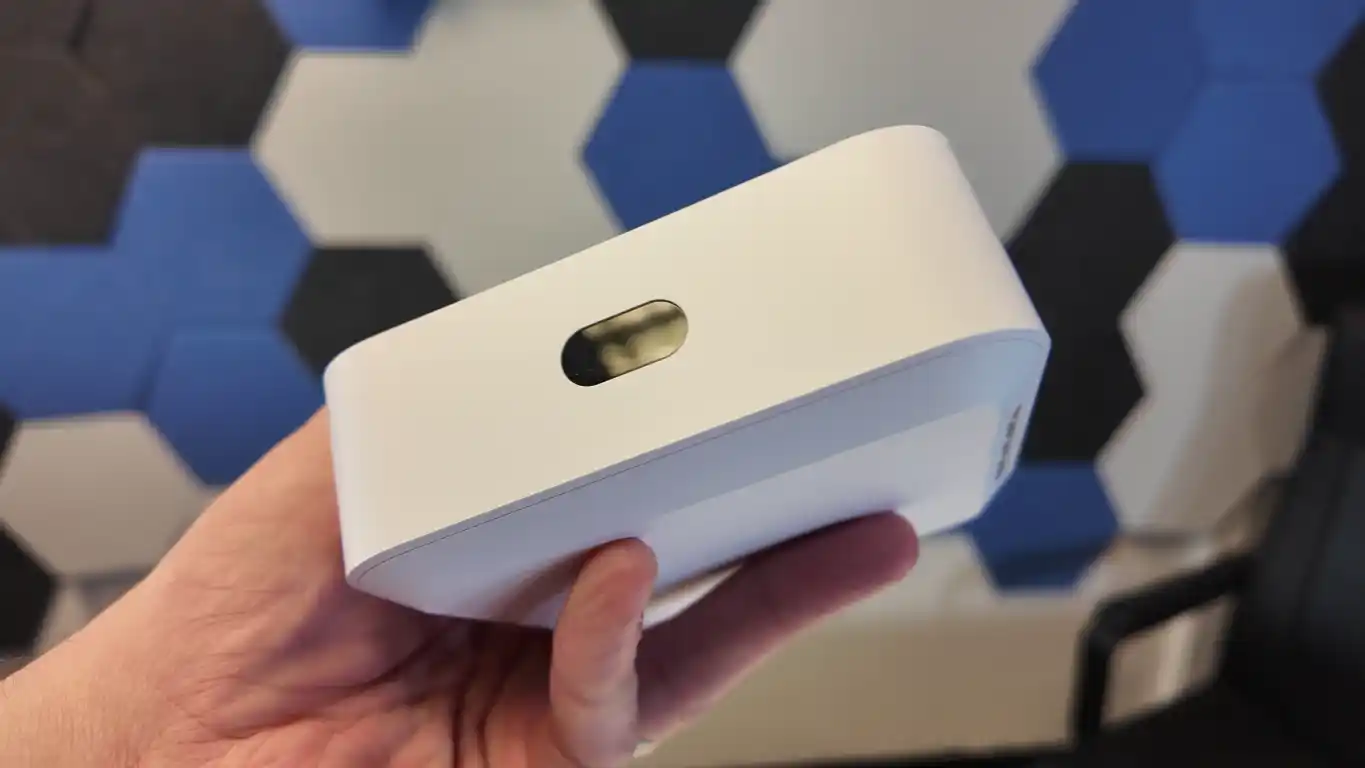
UniFi Express 7 Review – Quick Conclusion
Honestly, I kind of wish UniFi had launched the UX7 about six months ago. The UniFi Express 7 gateway is an impressive little device, and when you factor in the license-free architecture, alongside its $199 price tag for a fully Wi-Fi 7, 6 GHz-ready box, it’s hard to call this bad value. However, launching this device between the UniFi Dream Router 7 (UDR7) and the UniFi Cloud Gateway Fiber (UCG-Fiber) makes it look like the weaker option of the three. And while the UX7 certainly has network expandability and appeal, I strongly recommend anyone considering it to first check out the UDR7 or UCG-Fiber. That said, for its niche, highly scalable, and modular network appeal, the UX7 delivers exactly what UniFi promises. It’s certainly worth the $199 price tag, but keep in mind that it is designed first and foremost as a network gateway. You will struggle to fully unlock its potential without integrating a UniFi switch or expanding into an existing UniFi network.
| Where to Buy
UniFi Express 7 (UX7) –$199 HERE UniFi Cloud Gateway Fiber (UCG-FIBER) – $249 HERE UniFi Dream Router 7 (UDR7) – $279 HERE |
UniFi Express 7 Review – Design and Connections
Considering that this tiny device features tri-band Wi-Fi, 10G networking, and 2.5G networking, it’s kind of bonkers how small it is. Equipped with an internal quad-core ARM processor and 3GB of DDR4 memory, these modest yet highly capable internal components are more than enough to keep your data moving smoothly. The $199 launch price of the UX7 puts it slightly closer to the price of most Pro-sumer routers. While it’s not overpriced, some users may question whether there are better, more hardware-capable devices available at a similar price point in early 2025.
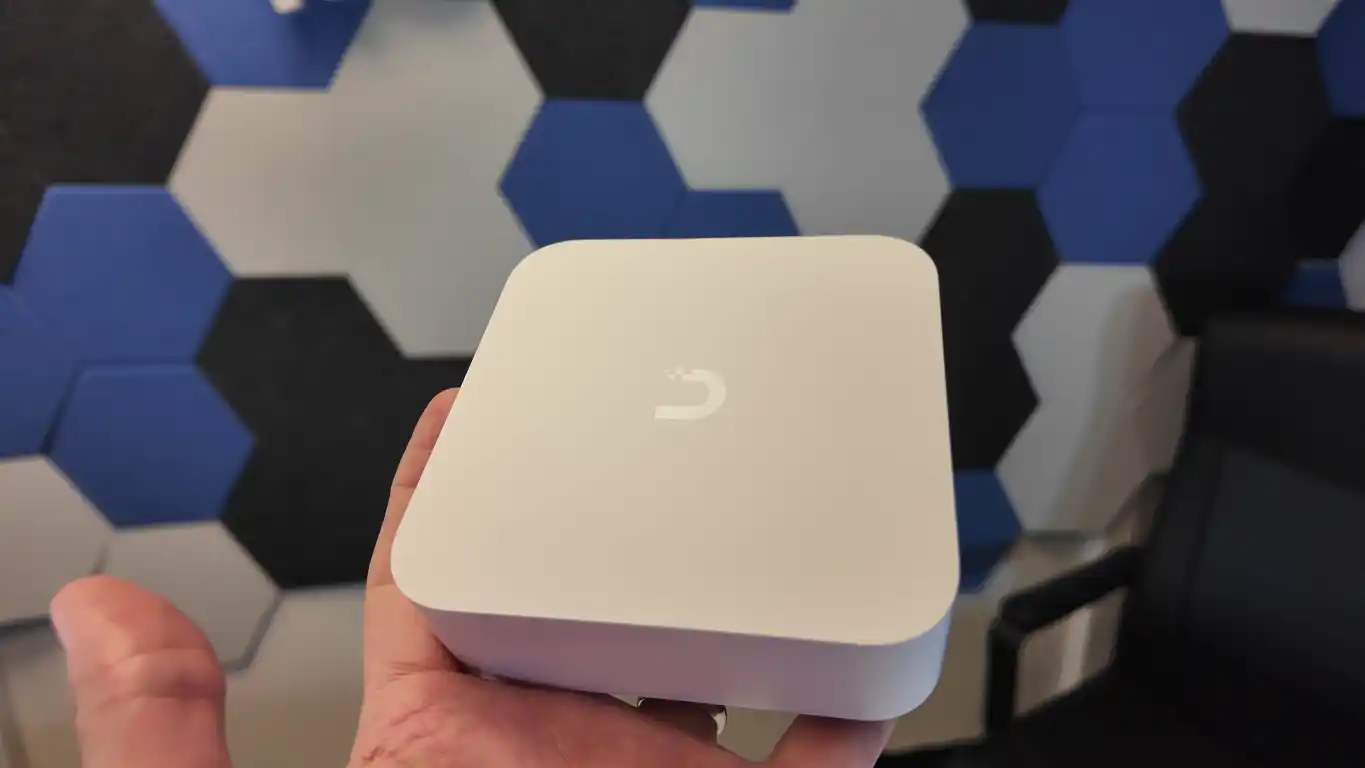
However, the main appeal of that price point is not exclusively about the hardware, and you have to factor in that this device is bundled with the UniFi software, offering full integration and utility of said hardware. This tiny box is able to host full control of a UniFi network, managing—via a single pane of glass interface—over 30 individual UniFi-connected/adopted devices and well over 300 clients at any given time. A big part of the appeal of UniFi products is that single ecosystem, and once you factor in that platform alongside the hardware, the $199 price tag starts to make a lot more sense.
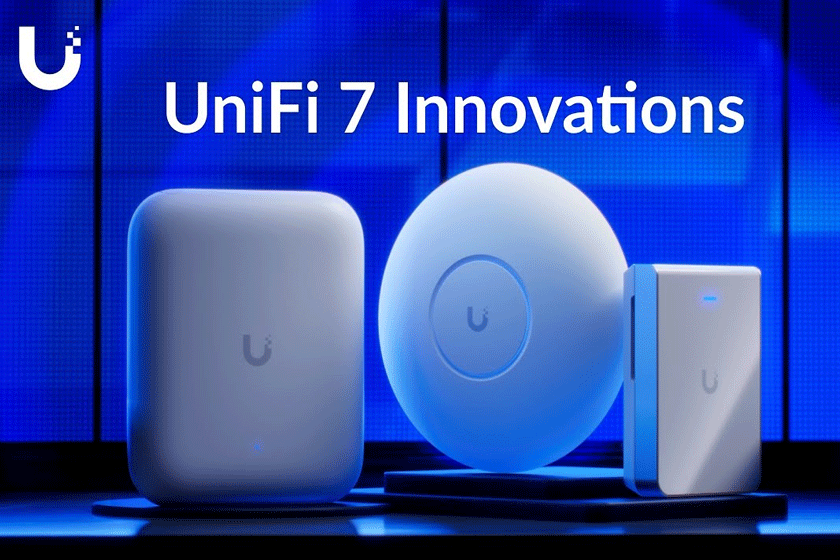
Although the system features two copper connections on the rear, the priority of the device will always be Wi-Fi connectivity. This small box is able to cover up to 1,500 square feet of wireless connectivity, but do factor in walls and rooms—of course! A lot of this coverage depends on the antenna and frequencies your client devices choose to use, and in that regard, the UX7 continues to push the boundaries.
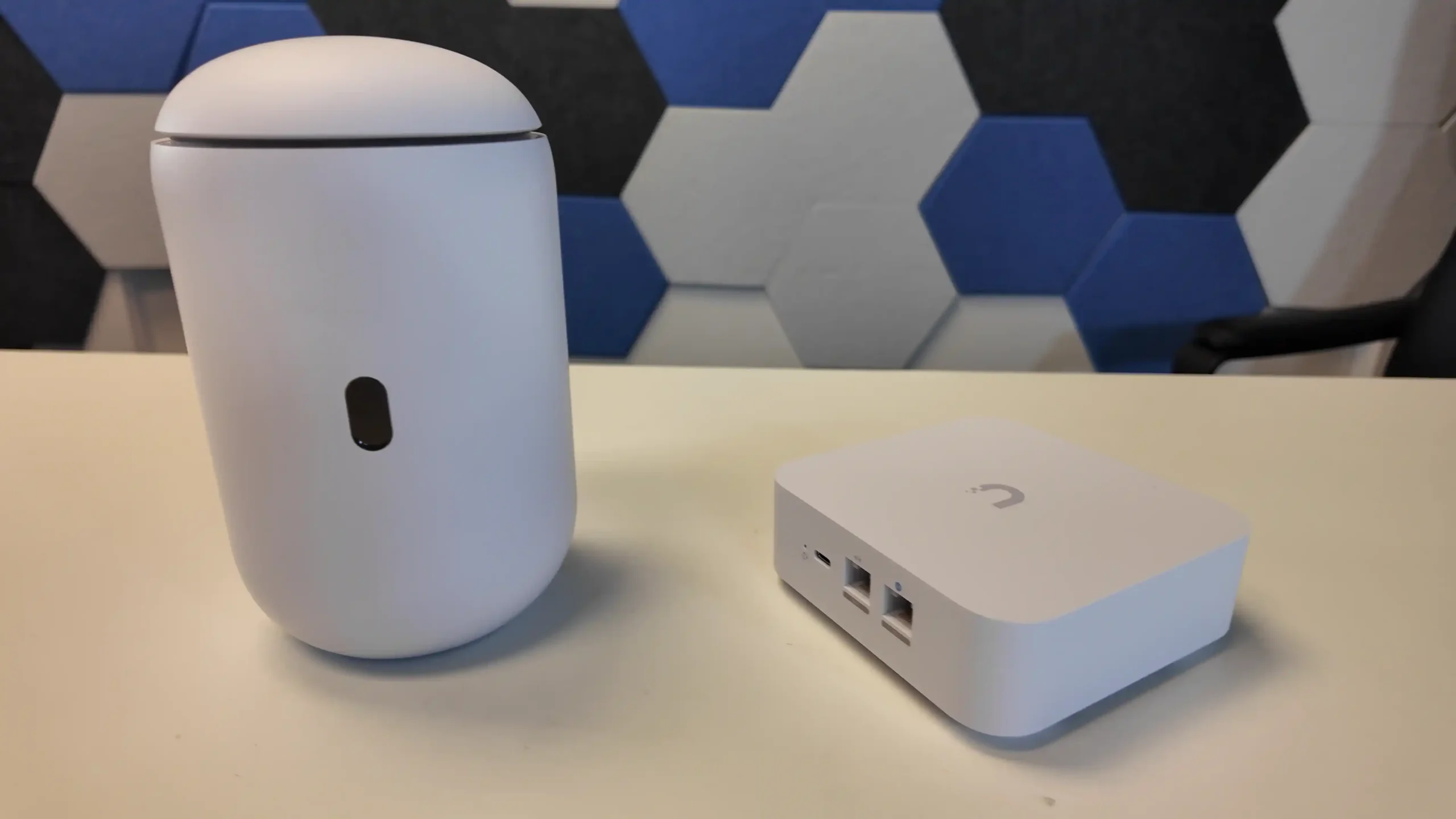
Scaling things up from the previous generation UniFi Express device, the UX7 supports Wi-Fi 7, Wi-Fi 6E, Wi-Fi 6, and traditional legacy Wi-Fi. Although the device has no external antenna, there are strategically placed antennas throughout the inside of this device. Thanks to the increased 6 GHz frequency access via the 2×2 6 GHz antennas inside and Wi-Fi 7’s utilization of 320 MHz channels, this opens the door to substantial performance increases in the UX7 over its predecessor.
Additionally, Wi-Fi 7 integrates Multi-Link Operation (MLO), which means Wi-Fi 7-supported client devices can create multiple simultaneous connections over different frequencies, drastically enhancing wireless performance—to the point where it dwarfs traditional wired connections.
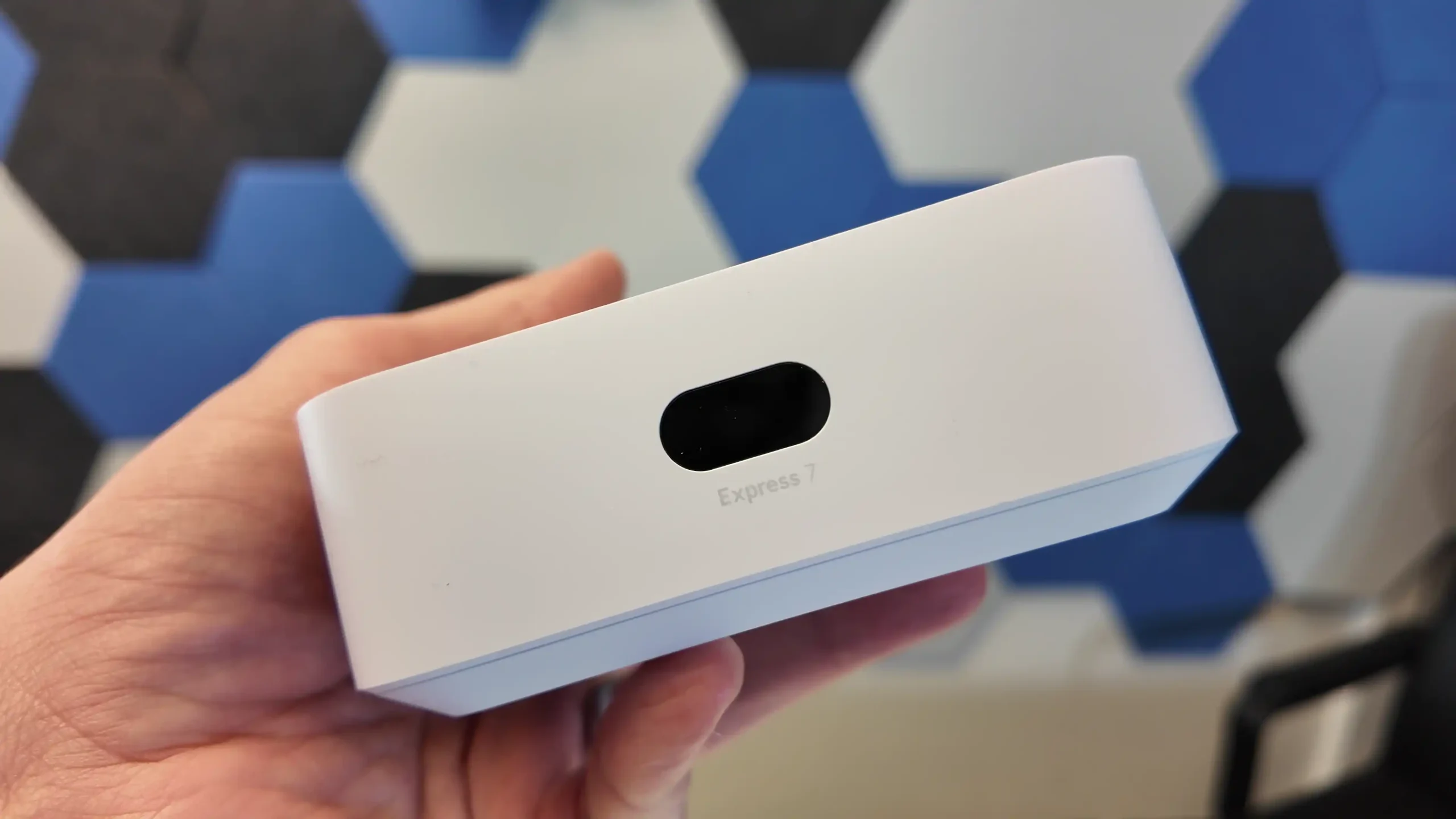
The 6 GHz band has a shorter coverage distance than 5 GHz, and likewise 5 GHz has a shorter range than 2.4 GHz. Although Wi-Fi 7 certainly solves many issues related to maximizing available radio frequencies, keep in mind that distance will still be a factor. Because of the small scale of this device, there are questions about true distance coverage compared to a router with more antennas and external antennas. Depending on the number of simultaneous frequencies via MLO that your client device can utilize, the maximum performance potential of this device will differ. However, across all of the available bands, you can achieve:
- 688 Mbps maximum bandwidth on the 2.4 GHz frequency,
- 4.3 Gbps performance on the 5 GHz frequency,
- A whopping 5.7 Gbps potential on the 6 GHz frequency.
Consider these more of a guideline to the larger shared bandwidth across multiple client devices, but nevertheless, they still indicate the performance potential of this tiny box once it’s integrated into your network. Although we will delve into more detail about security and encryption later in the review, it’s also worth highlighting that this system supports encrypted protocols all the way up to WPA3 for wireless transmissions. The UniFi Controller software provides an almost unrivaled level of network security management and troubleshooting, with controls extending down to individual devices, groups, VLANs, and MAC addresses.
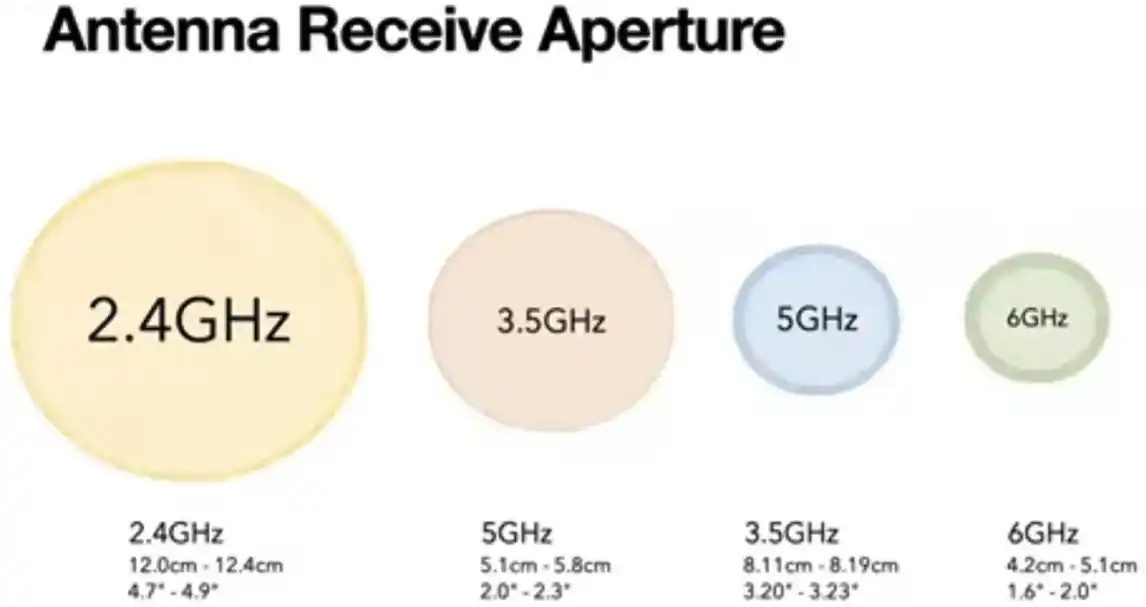
This means that even if you begin integrating third-party hardware into your network environment or stick to UniFi client devices as you expand upon this gateway device, the lock-and-door approach to your ISP services will always be significantly tighter thanks to having the UX7 as your gateway. Moving over to the wired connections, the system features a 2.5G Ethernet port that is utilized as a LAN connection. This means you can integrate an existing switch and expand your UniFi network toward more wired devices, as well as creating multiple virtual LAN arms in your network environment.
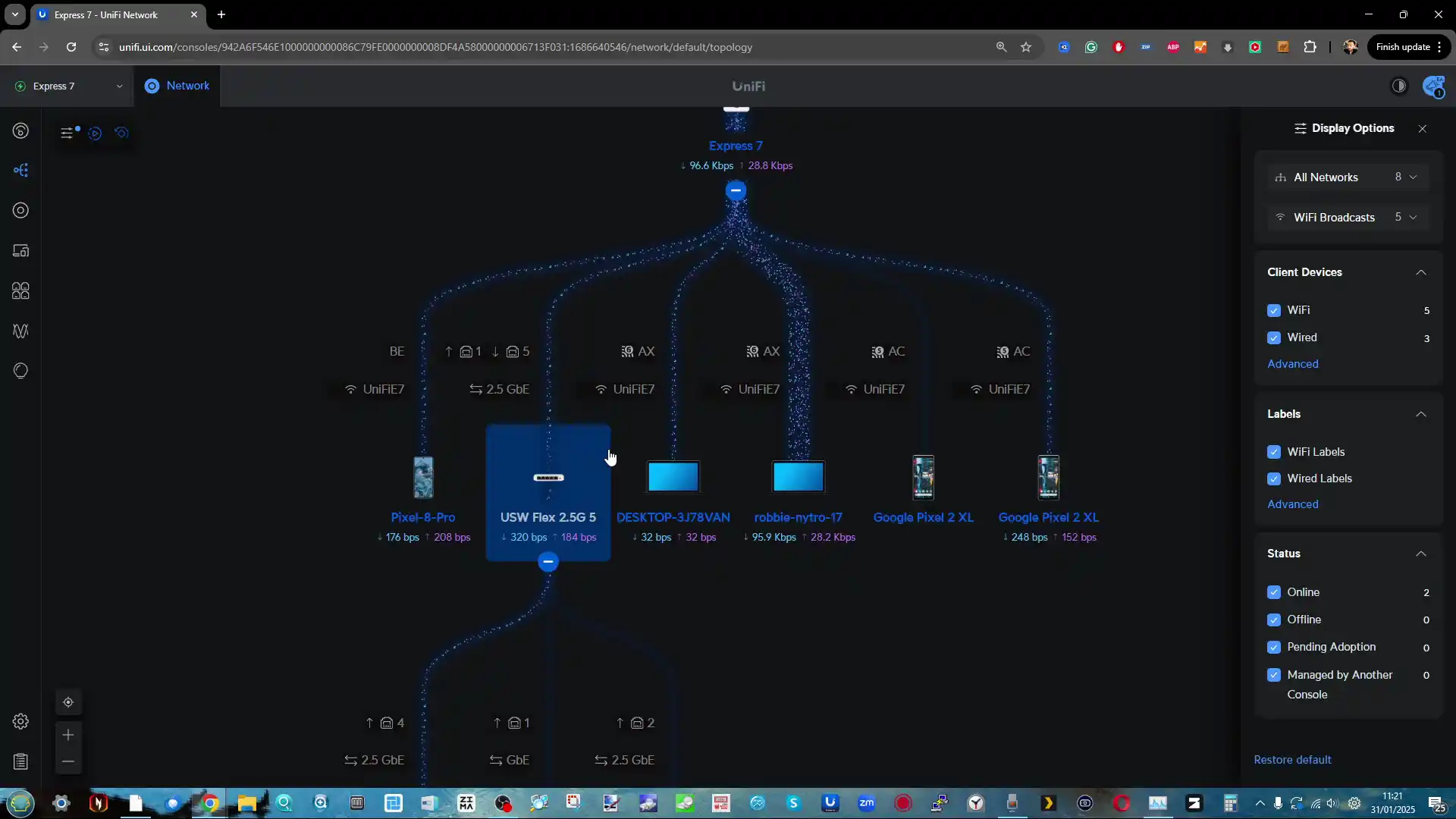
Unfortunately, this 2.5G port does not support Power over Ethernet (PoE), which means any connected devices will need their own power source. This is a shame, because both the simultaneously released UDR7 and UCG-Fiber devices each include a PoE port, making wired expansion with UniFi switches much cleaner and more convenient.
Nevertheless, it’s good that standard Gigabit Ethernet is absent in favor of 2.5G Ethernet, allowing for 2.5 times the performance of traditional and legacy networks.
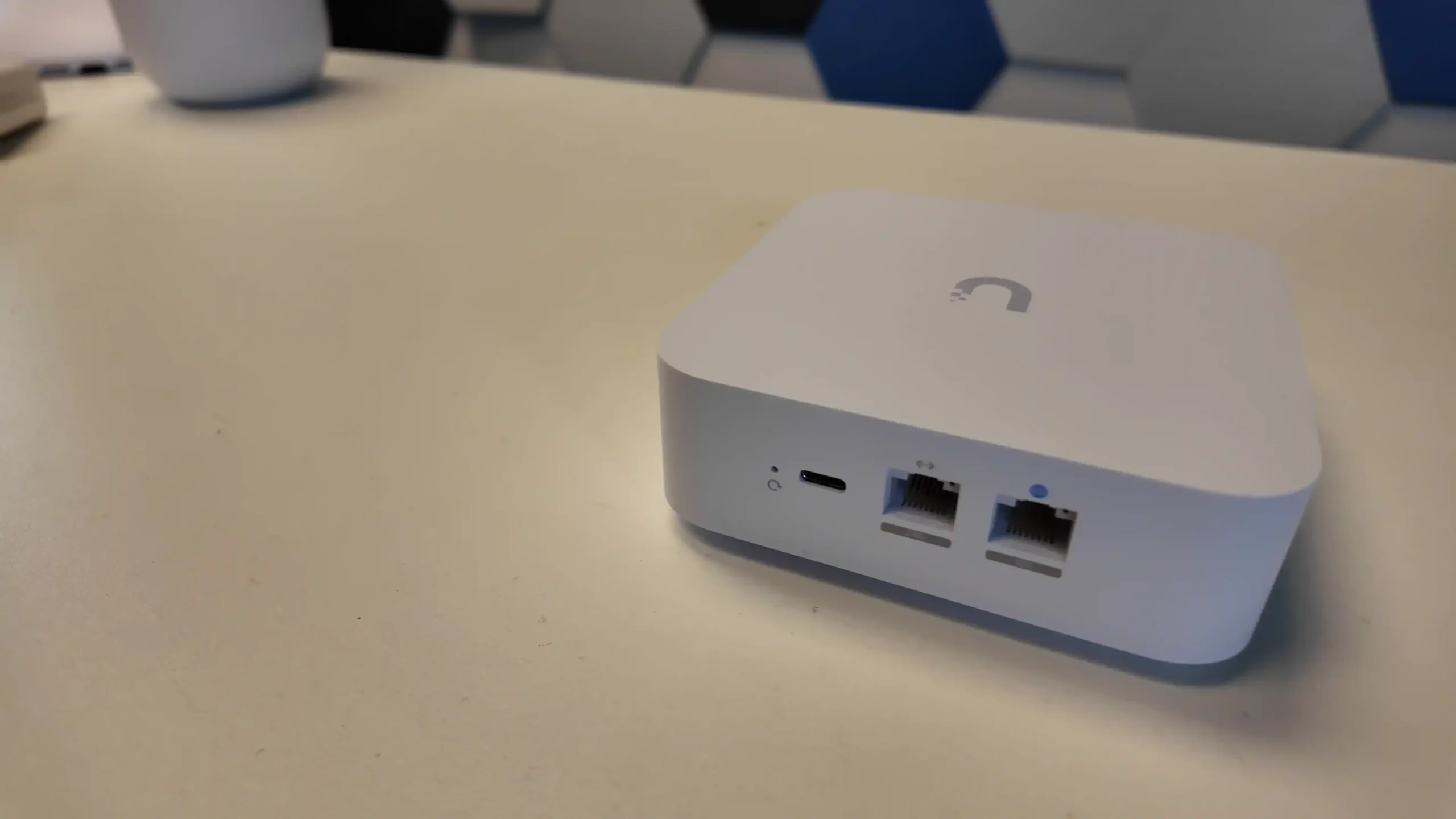
Interestingly, the UX7’s WAN port is a 10GBASE-T copper connection! Most users would have assumed that this compact device would arrive with 10G SFP+, as is common with most UniFi devices. However, opting for traditional copper 10G means that as ISP services globally begin to exceed Gigabit speeds, the UniFi Express 7 gateway will not create a bottleneck, allowing your network to fully enjoy those higher speeds as they become available. This also means that this tiny box is future-proofing your internet service gateway for a considerable length of time as better connectivity options arrive. Nevertheless, I’m a little disappointed that you cannot set the 2.5G port as your WAN, thereby allowing you to dedicate the 10G connection as a wider LAN connection. This would have been beneficial when using it alongside a traditional 10G NAS system or a larger switch that would take greater advantage of 10G network speeds. Very few users in the next few years will have internet speeds exceeding 2.5G (regardless of whether you are a home or business user), so fixing the 10G connection as the only WAN port feels like overkill for many. CORRECTION! You CAN set the 2.5G as a WAN port, but you need to manually change the initial 10G WAN port to LAN or Disabled FIRST, then the option to select 2.5G as a WAN will appear!
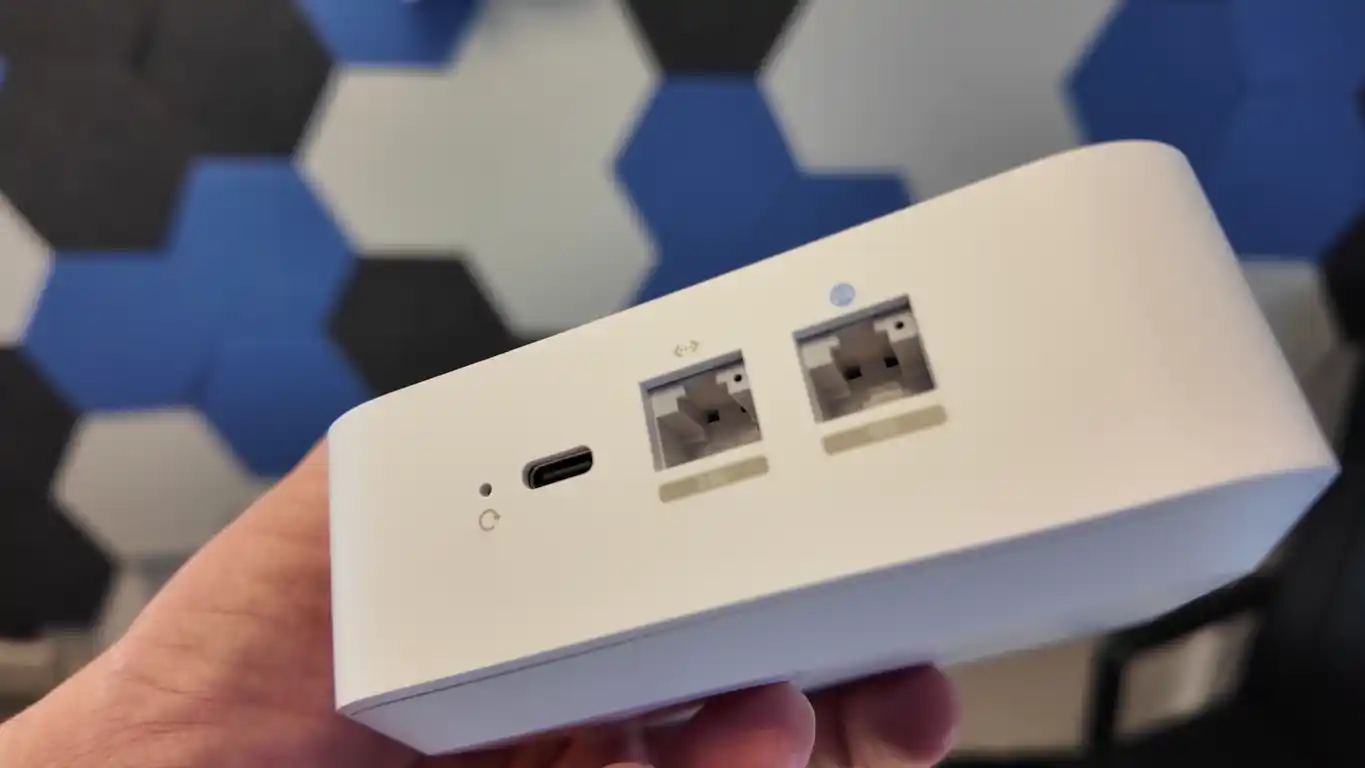
Impressively, the device is powered by a standard USB-C PSU, which is included in the kit. It’s probably no surprise that this device is quite power-efficient, factoring in the ARM CPU alongside the system’s prioritization of Wi-Fi connectivity out of the box rather than LAN/physical WAN connections. At peak Wi-Fi bandwidth utilization, with an active 10G connection, UniFi reports that the device draws just 22 watts at peak usage. Realistically, the device will spend 90% of its time operating at a fraction of this power consumption. Another major difference between the UX7 and other UniFi network management devices released in the last 12 months is that this system does not feature any internal storage or expandable storage via an SD card or USB port.
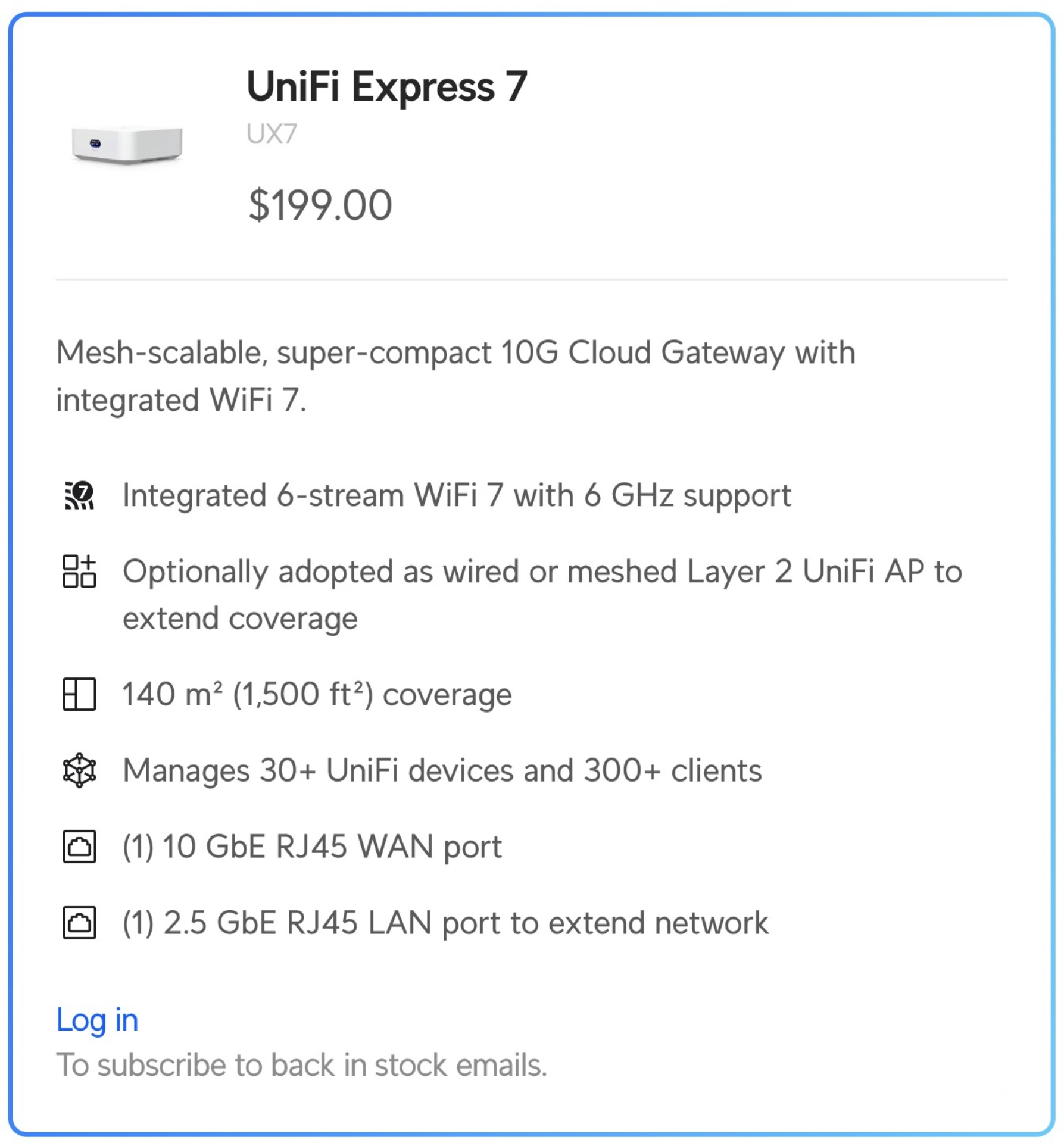
This means that the system is unable to host popular UniFi add-on applications for surveillance, in-house communication hardware, or dedicated UniFi hardware appliances. These features can still be added via an expanded UniFi network client installation over time, which is why this device is so affordable compared to other solutions. It is designed around gradually expanding your hardware network. That said, it’s a real shame that this device does not include any baseline storage out of the box, as many users would have wanted to utilize it as the base for a convenient and easy-to-deploy UniFi Protect surveillance device. As mentioned earlier, the UX7 is quite a niche device, making it difficult to compare against an already well-provisioned router or business gateway device. The hardware design and connectivity of the UX7 are optimized for a small, compact UniFi gateway deployment, but it also includes provisions for future scalability with wireless access points (for mesh networking) and UniFi switches for expanded connectivity later.
In that vein, let’s now discuss the UniFi Controller software and how the Express 7 takes advantage of it today—while also promising greater expansion capabilities in the future.
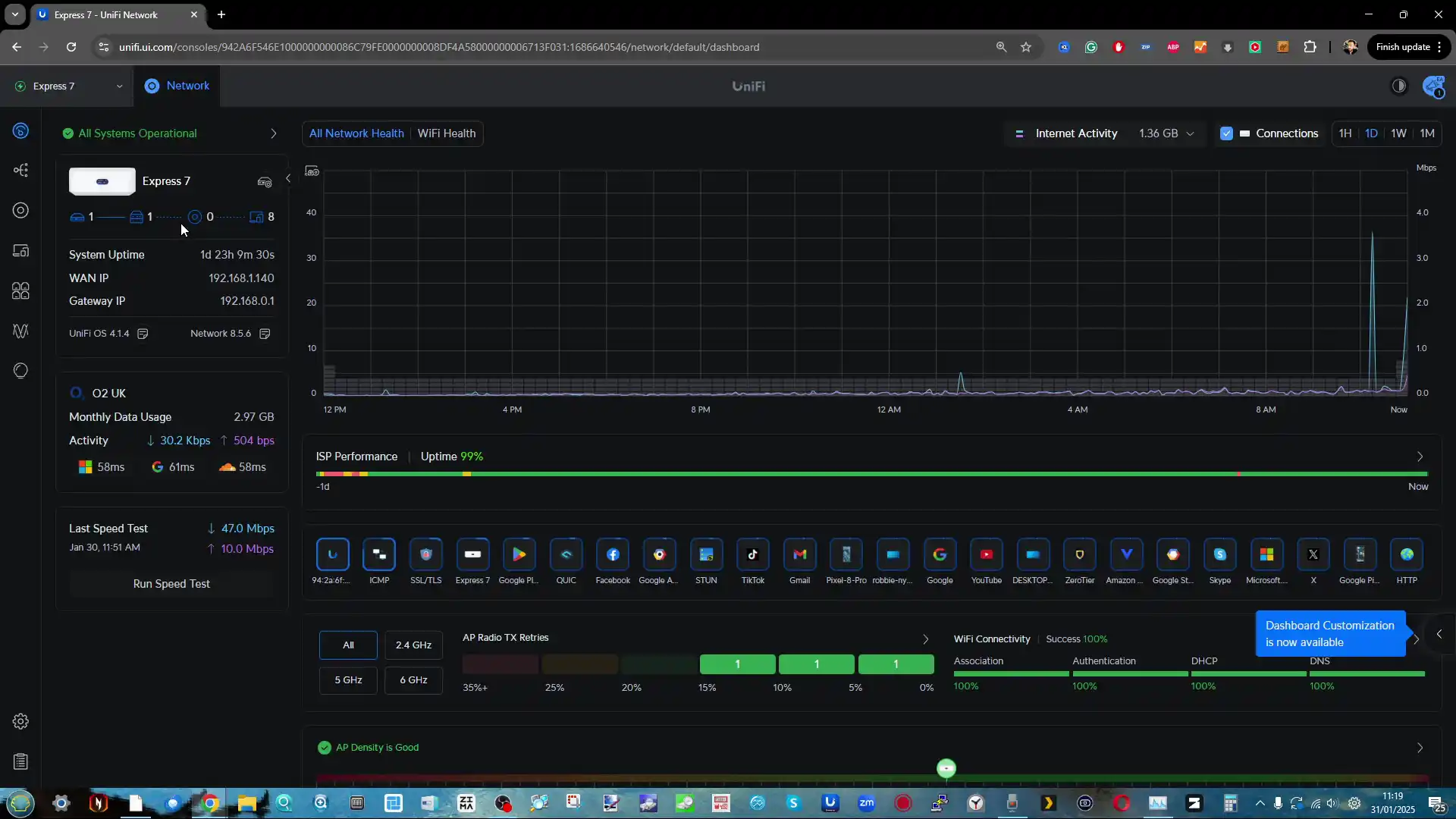
UniFi Express 7 Review – Software and Services
IMPORTANT !!!- Currently the Software review of the Ux7 is in progress, but I have already reviewed the UDR7 device which is very similar indeed. So, whilst I complete the UCG-Fiber and UX7 review, I have included the software review of the other 2 devices below, as they are running near identical services and features (but with differences with regard to port/wifi features. I will be amending the below text very soon, but include it here to give a better understanding of what this UniFi controller software can do. Apologies for this in the meantime.
Realistically, no one should be spending inordinate amounts of time using the software that your router arrives with – that’s just a simple fact. Indeed, you want you router (or any network appliance) to just do it’s job! Therefore talking about just how good the UniFi network software is, and how the UniFi Dream Router 7 capitalized on it, is going get a mixed reaction depending on your own level of network knowledge and custom requirements. I will say straight away though that you will really, REALLY struggle to find a more capable and flexible router software at this price point. You will struggle to find ANY setting, config, adjustable parameter of control measure not included with the UX7. First off, there is the mobile application. As the UX7 hosts the UniFi network software, ALOT of the iOS and Android official UniFi applications are supported by the UX7.
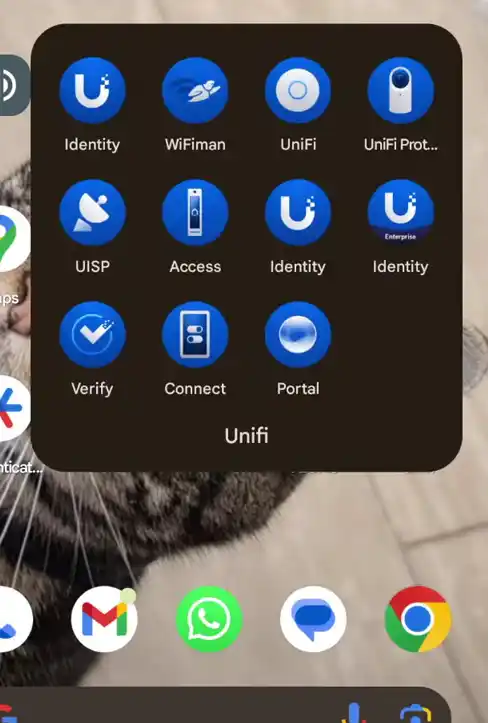
Firs time setup of the router using the mobile application (you can use a desktop machine with your web browser if you prefer of course) is incredibly straight forward. The Router can be found via the local area network or Bluetooth within 2 minutes of it’s first power-on. One big misconception (I was guilt of this too a while back) was that you have to register a UI.com account online in order to use UniFi appliances. This is NOT true. You can set the device up without a UI account (and even WITHOUT an internet connection) and doing so just needs to you create a local administrator account. It is recommended to use a UI account of course, as it allowed for easier comms and access for your larger Unifi network, but it is by no means compulsory. You can also create a system backup (with your config data of users, settings, SSIDs, etc) and backup online if you choose – and then easier pull this backup if you wish during initialization easily.
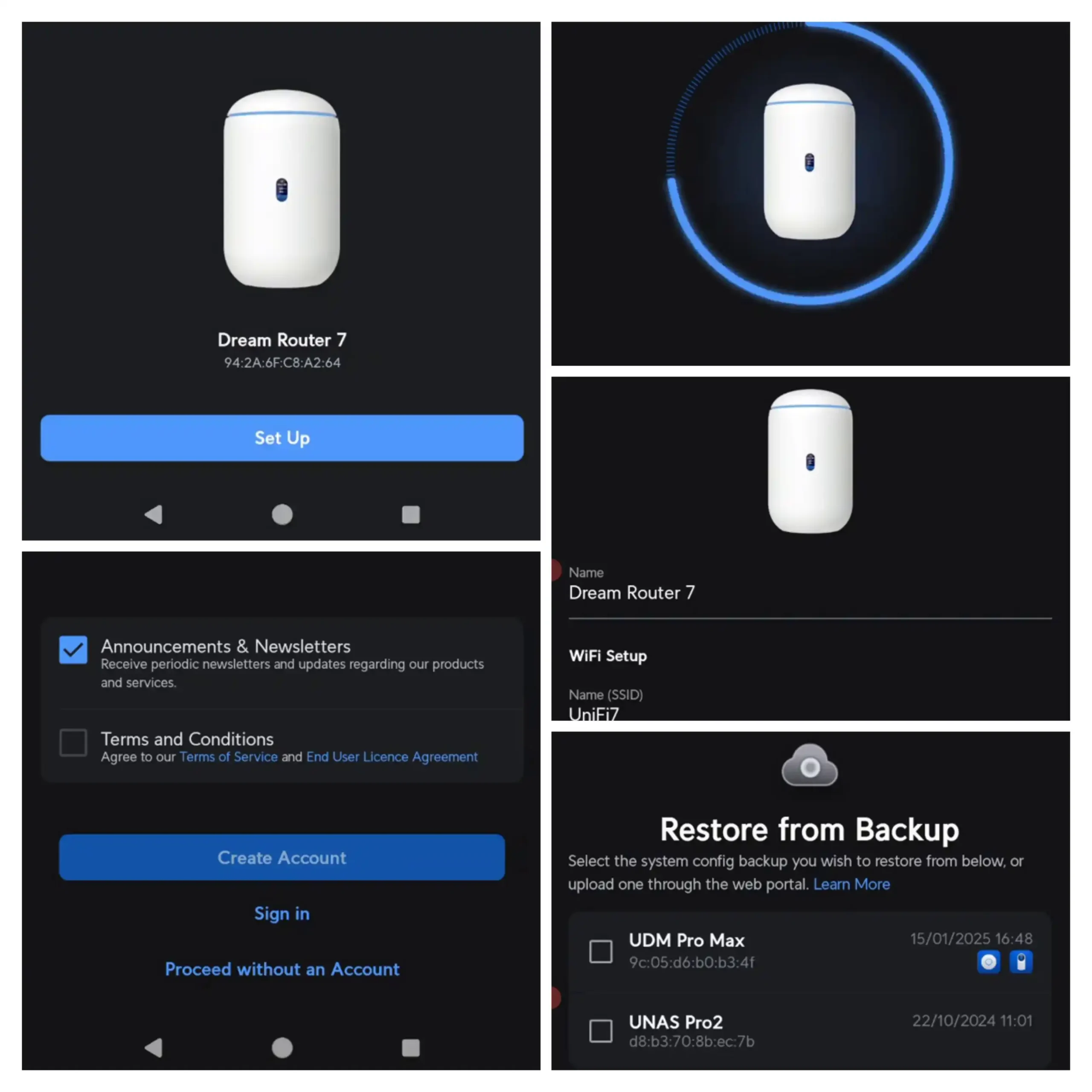
Upon creating local credentials or resisting an online account, the router performs an initial internet performance test and then goes about setting up your router. Much like other recent UniFi releases, the system has a ‘gamer’ style installation screen that shows tips and guides on how to get the most out of your router – very rare in a router I will say.
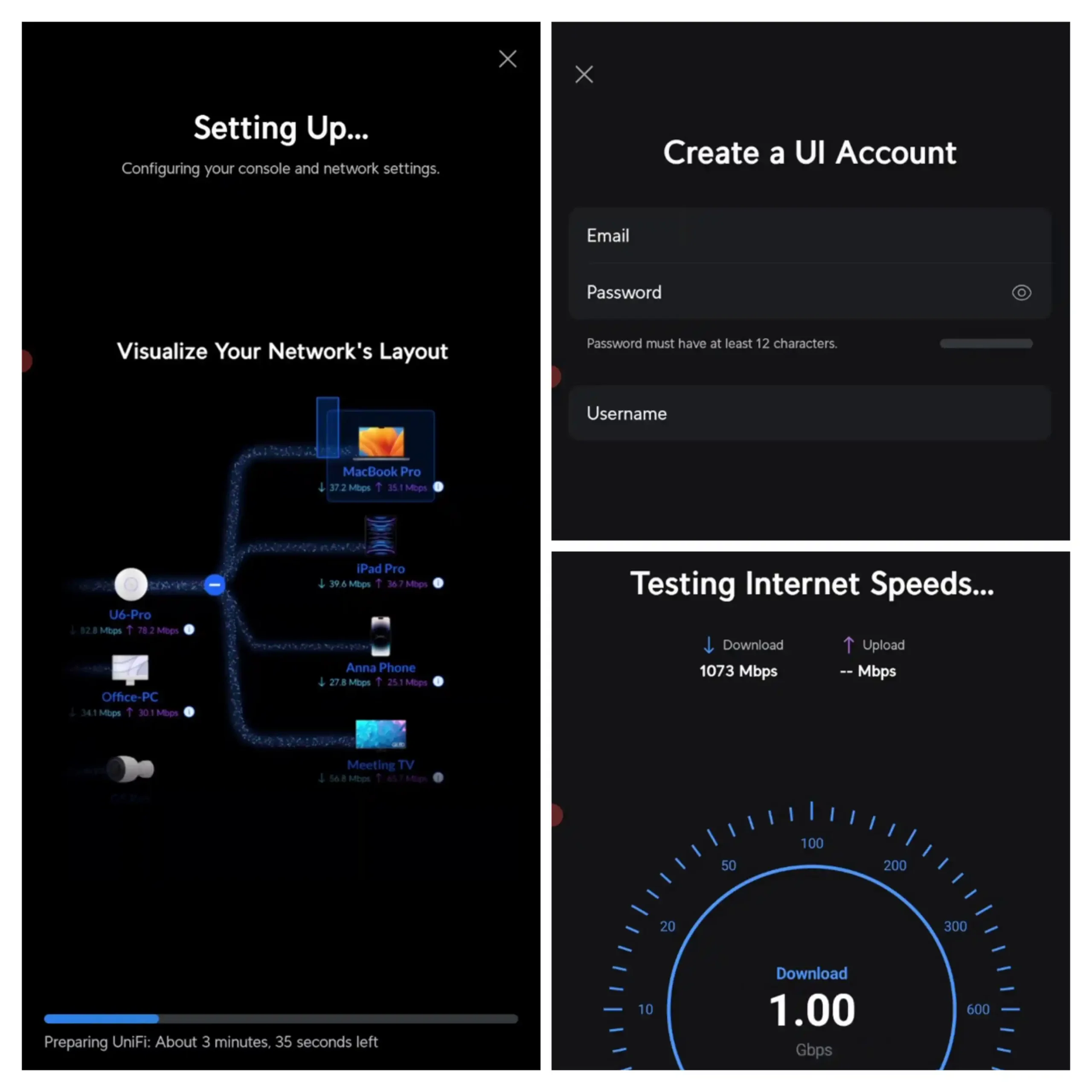
The setup process takes around 2-3 minutes and after that, you have pretty much FULL control and access to the Router’s configuration from your mobile phone. You can definitely tell that UNiFi have put the hours in with regard to the UX of the mobile application. Routers (and switches for that matter) are NOT easy systems to try and simplify – let along ocndence in a compact mobile UI. However they really have excelled in the latest version of their software.
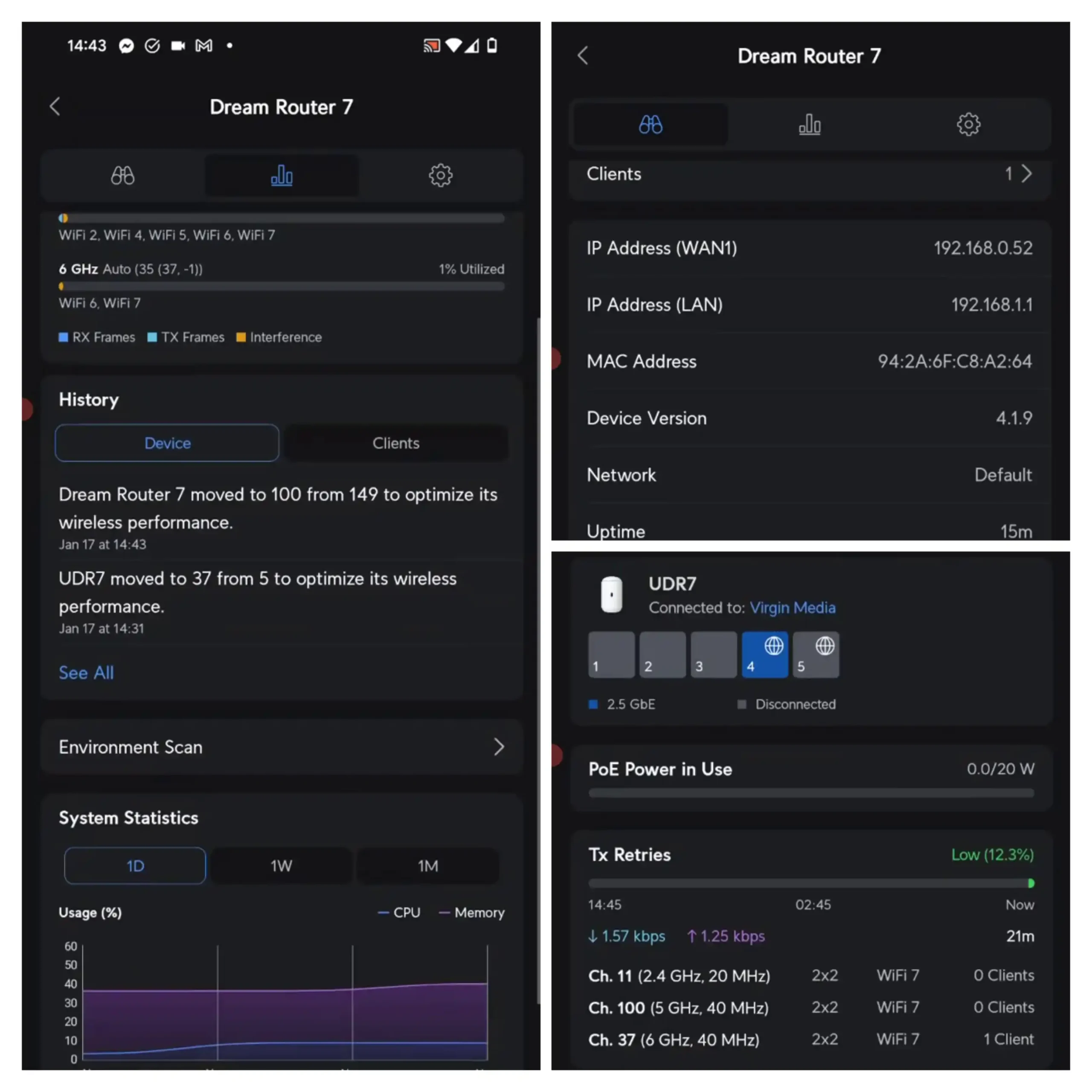
Management of individual devices on the network are all presented intuitively in the app, and alongside their position/priority/bandwidth/consumption being presented, you can also use the app to institute controls and rules for 1, some or all devices on the fly – with instant implementation. Again, it’s no the fact that you can ‘do’ this that I am impressed by, it is the ease and intuitive way it is presented in a mobile app.
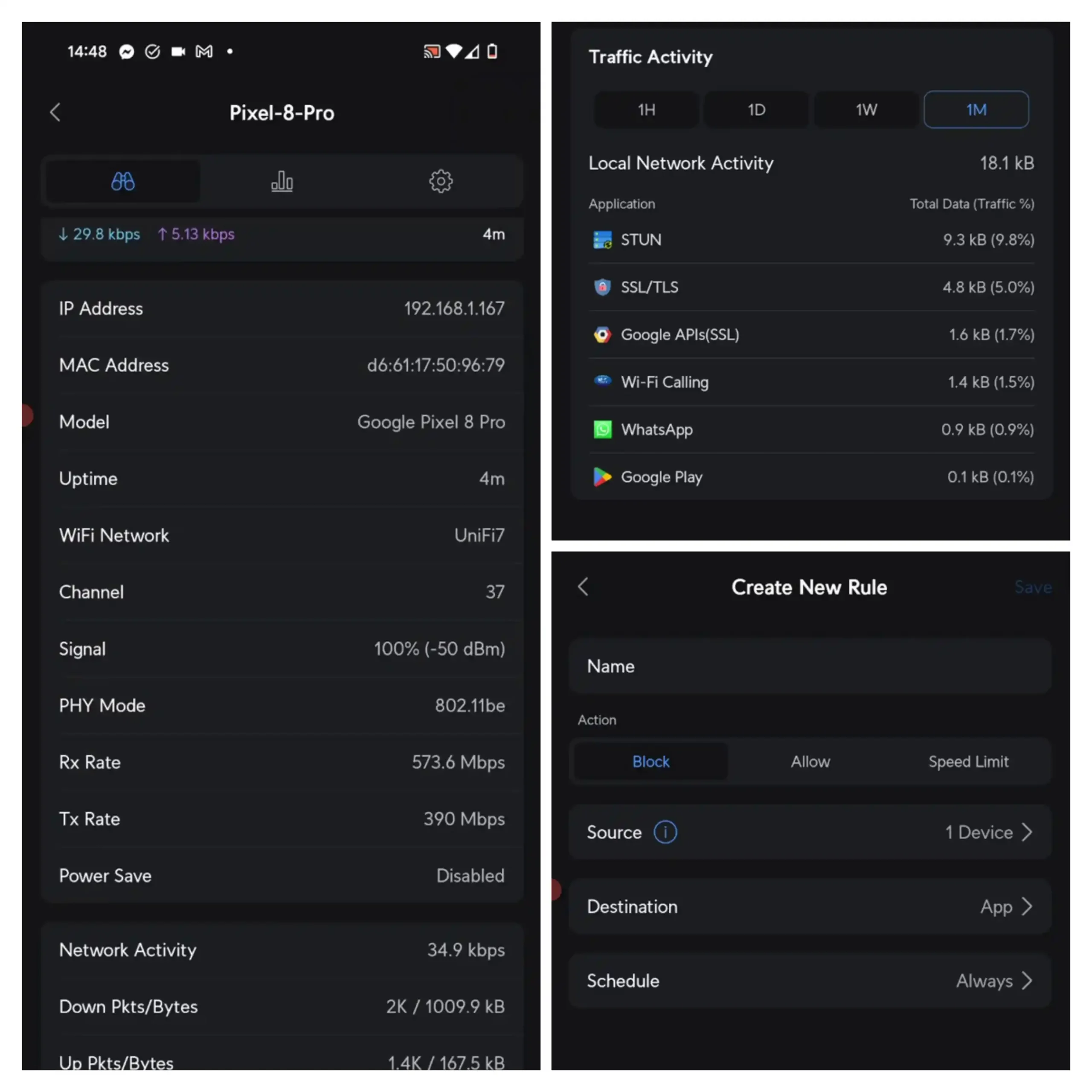
The same applies to the physical connections and wireless connections on the UX7 itself, with full remote control with the app to bridge, negotiate, failover, vLAN, disable, etc any port easily – as well as create new SSIDs, assign channels and push client devices around on the router side in 3-4 clicks. All of this is performed responsively and easily in the app.
 On the subject of client devices, let’s discuss that WiFi 7 support. WiFi 7 opens up ALOT of performance and general bandwidth advantages. WiFi routers and client devices have been around now for around 10-12 months, as well as the increase in availability globally of greater than Gigabit internet services. Most internet service providers have already a router with their services – but not many provide WiFi 7 routers with their services, even at greater than gigabit speeds. So, what is the advantage? For the quicker (ish) version, watch my video below.
On the subject of client devices, let’s discuss that WiFi 7 support. WiFi 7 opens up ALOT of performance and general bandwidth advantages. WiFi routers and client devices have been around now for around 10-12 months, as well as the increase in availability globally of greater than Gigabit internet services. Most internet service providers have already a router with their services – but not many provide WiFi 7 routers with their services, even at greater than gigabit speeds. So, what is the advantage? For the quicker (ish) version, watch my video below.
Now, you might well not have any devices right now that are WiFi 7, but plan on upgrading to WiFi 7 at some point in the further over a PCIe upgrade card. Even if you are using a system that lacks a PCIe upgrade clot, you can get small m.2 upgrade cards for a WiFi 7 / 802.11be upgrade for as little as $15-20 here. Hell, you do not even need to open up your system, as you can now get WiFi 7 to USB adapter upgrades for as little as $25-30, which is exactly what used when testing the router with my Windows 11 laptop for the earlier testing of the UDR7.
The USB-to-WiFi 7 Adapter I used in my testing of the UDR7 was this one HERE on Aliexpress.
This USB to WiFi 7 adapter allowed for immediate 802.11be connectivity between my laptop and the UniFi Dream Router 7, over the now available 6Ghz band. Although there is more to WiFi 7 and this router than just that additional frequency. The UX7 SUPPORTS 2.4Ghz and 5ghz (just like all WiFi 6 and 6E routers), but crucially alongside the 6Ghz band allowing for more active concurrent connections, you are also able to take advantage of 320Mhz bandwidth (till now WiFi 6/6E only allowed for up to the 160Mhz connections). This means that you have a greater bandwidth per connection – though you can only have a finite amount of connections at 320Mhz at once. This is COMBINED with WiFi allowing for overlapping connections too and 1 device enjoying multiple connections at once.
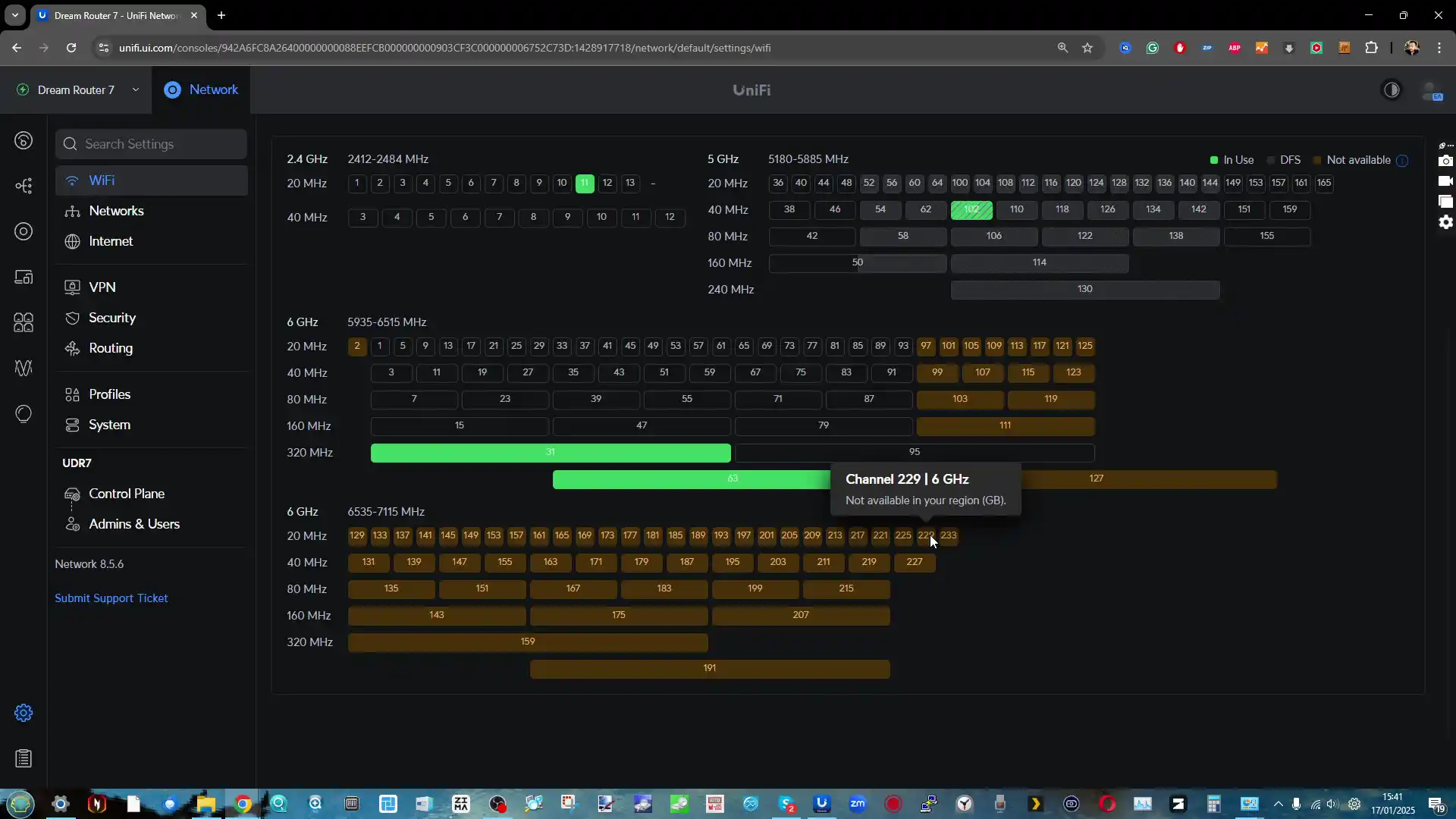
This means that not only can you match the speed of a normal wired gigabit connection, but you can ABSOLUTELY SMASH IT! As you can see below, using this USB adapter on my regular windows laptop, connecting to the UniFi Dream Router 7 over the 6Hz band – I was able to hit 2.8Gb/s wireless connectivity!!! That is even faster than using one of the physical 2.5GbE connections on the UX7.
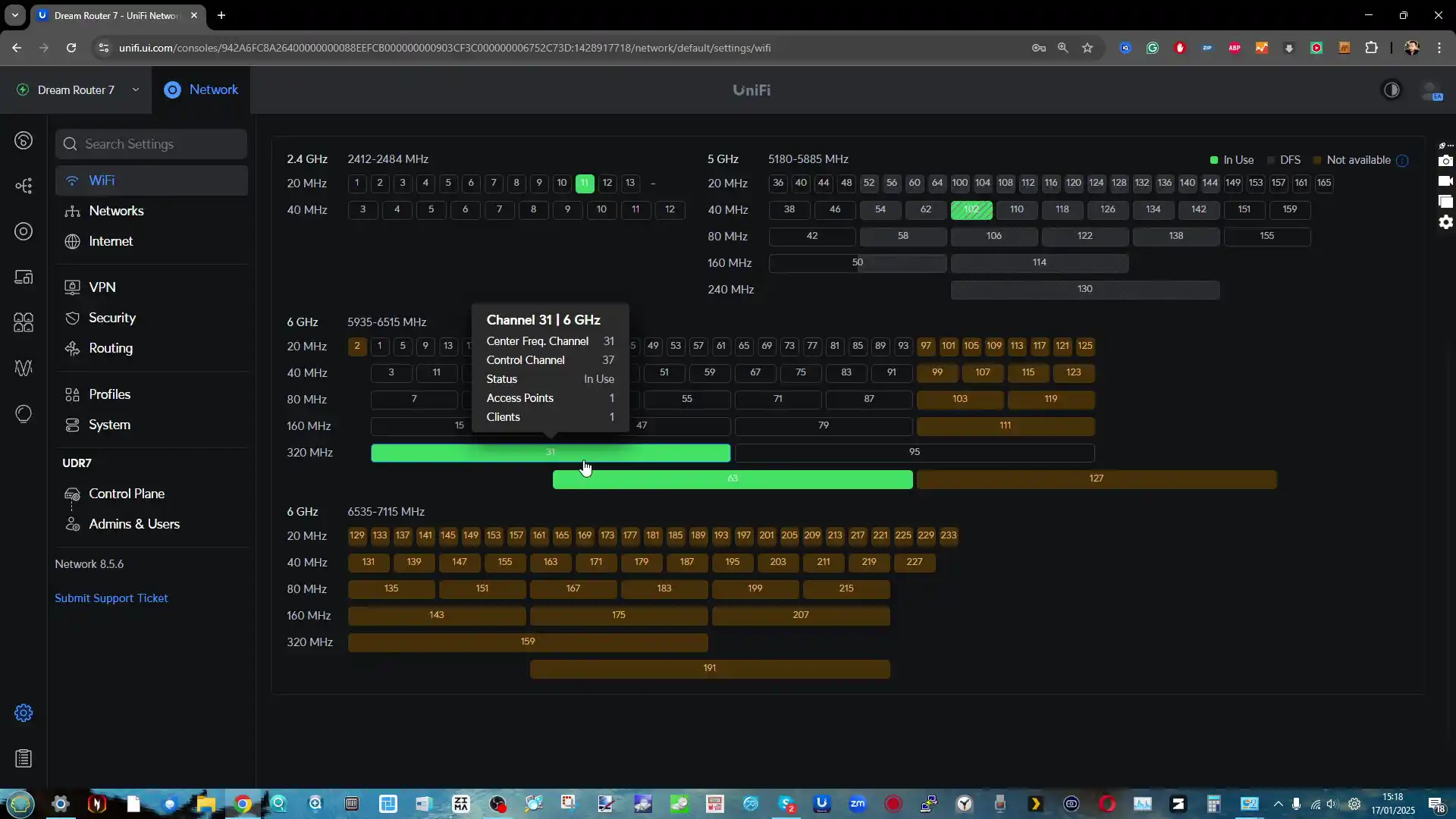
It’s worth remembering though that WiFi 7 is NOT perfect and although it presents a lot of benefits for bandwidth improvements, reduced latency and increased encryption options, support of the wider frequencies and abilities of a larger WiFi 7 populated network are still a little ‘early days’.
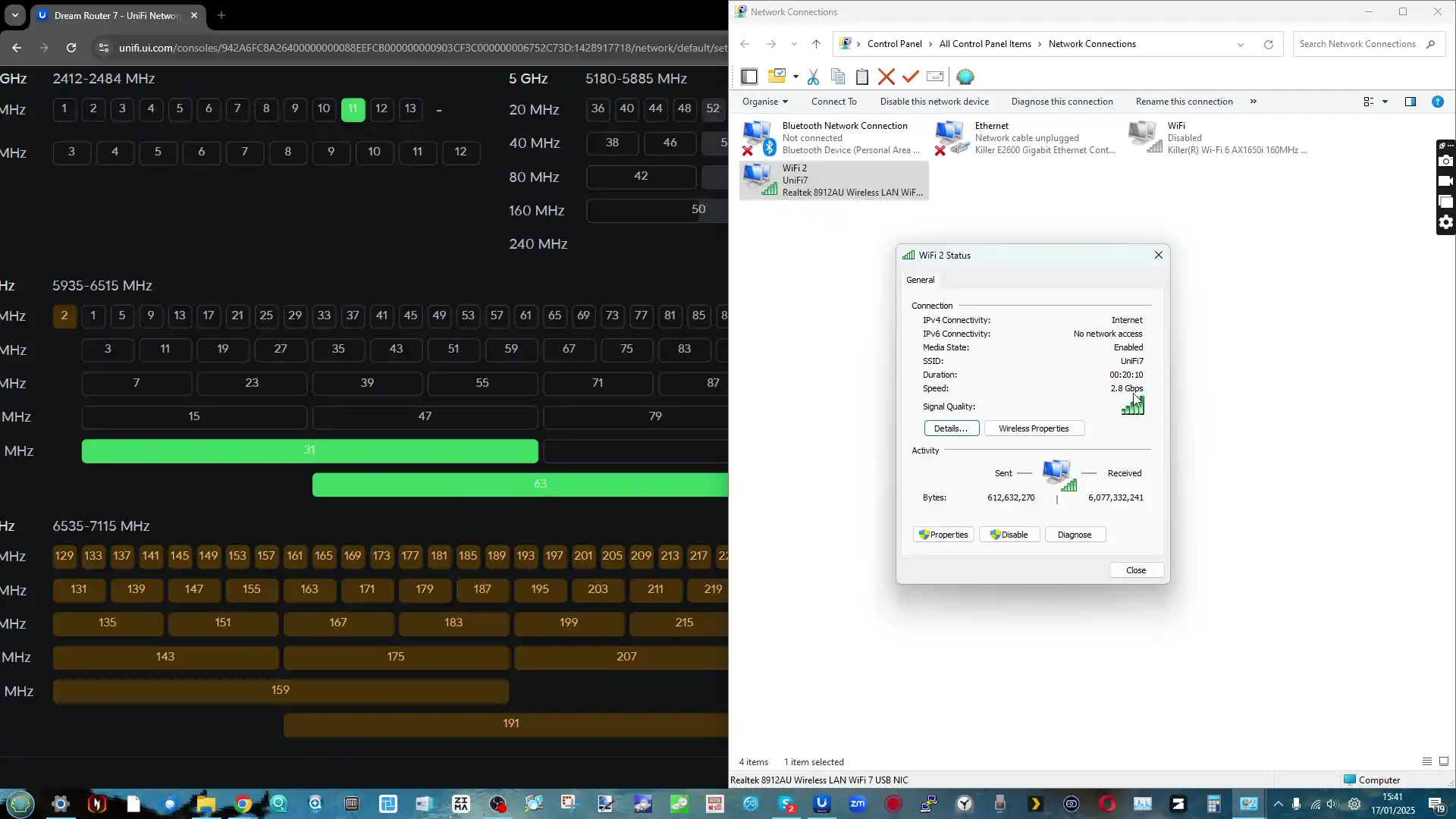
By that, I mean that although you can hit high performance with 320Mhz connections, the actual radio frequency opened up right now (depending on your region) is pretty slim. The UX7 DOES show you the full radio spectrum, separated dynamically with each 20/40/80/160/320Mhz block that is spread across 2.4/5/6Ghz – but ALOT of it is still unavailable to use in many regions.
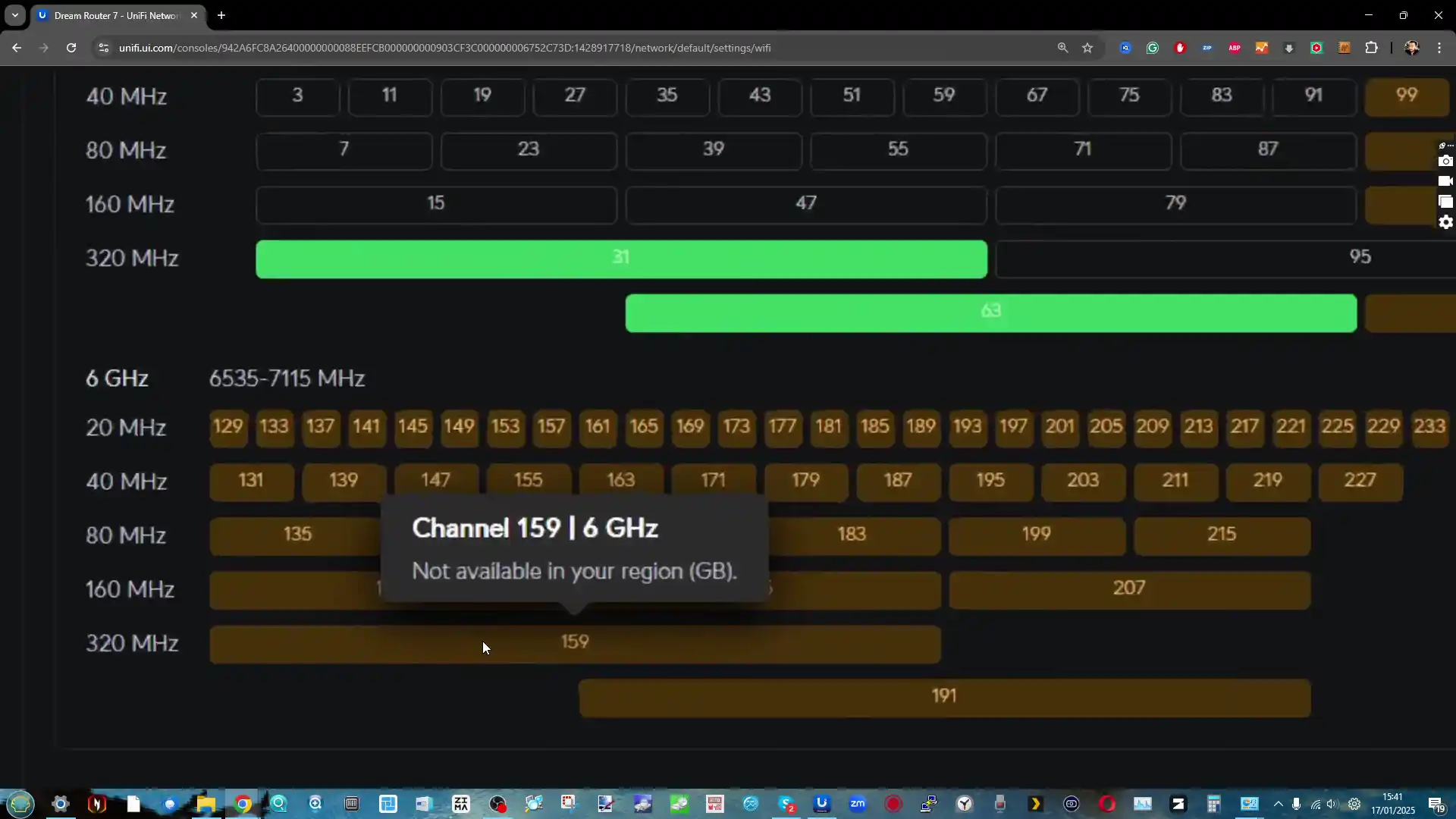
These limitations are likely going to reduce over time and, therefore you have to look at a decent % of the WiFi capabilities of the UniFi Dream Router 7 as ‘future proofing’ – but just keep in mind that although you can deploy ALOT of wireless (and wired) devices in a UX7 managed environment, those peak 802.11be/WiFi 7 bandwidth improvements are going to be shared only by a few client devices – in reality the real benefits are going to be felt with the opening up of the 6Ghz frequency allowing for more devices to be spread over all three frequencies and bands at 80/160Mhz.
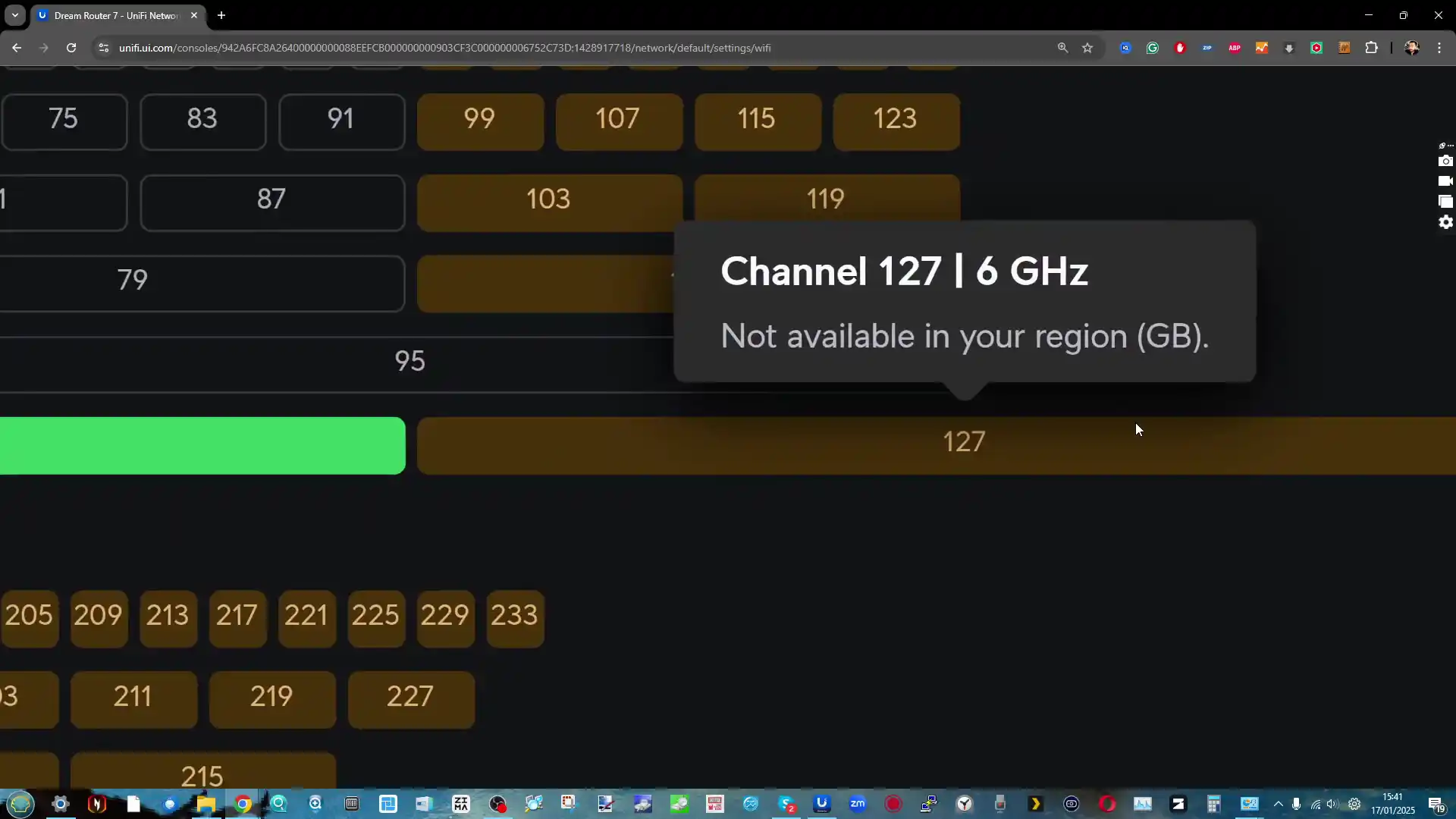
Anotehr note to keep in mind is that the 6Ghz band has a shorter area of effect than 5Ghz (which likewise has a shorter area than WiFi 5). So WiFi7 is at it’s best in closer proximity without walls – more as a cable alternative if you are in the same areas as your UniFi router. But when I connected to a 10GbE NAS (connected to the 10GbE port of my UCG-Fiber), I was able to hit 187MB/s write easily (though read performance was oddly inconsistent – possibly related to the NAS, still investigating – TBC) in CrystalDiskMark.
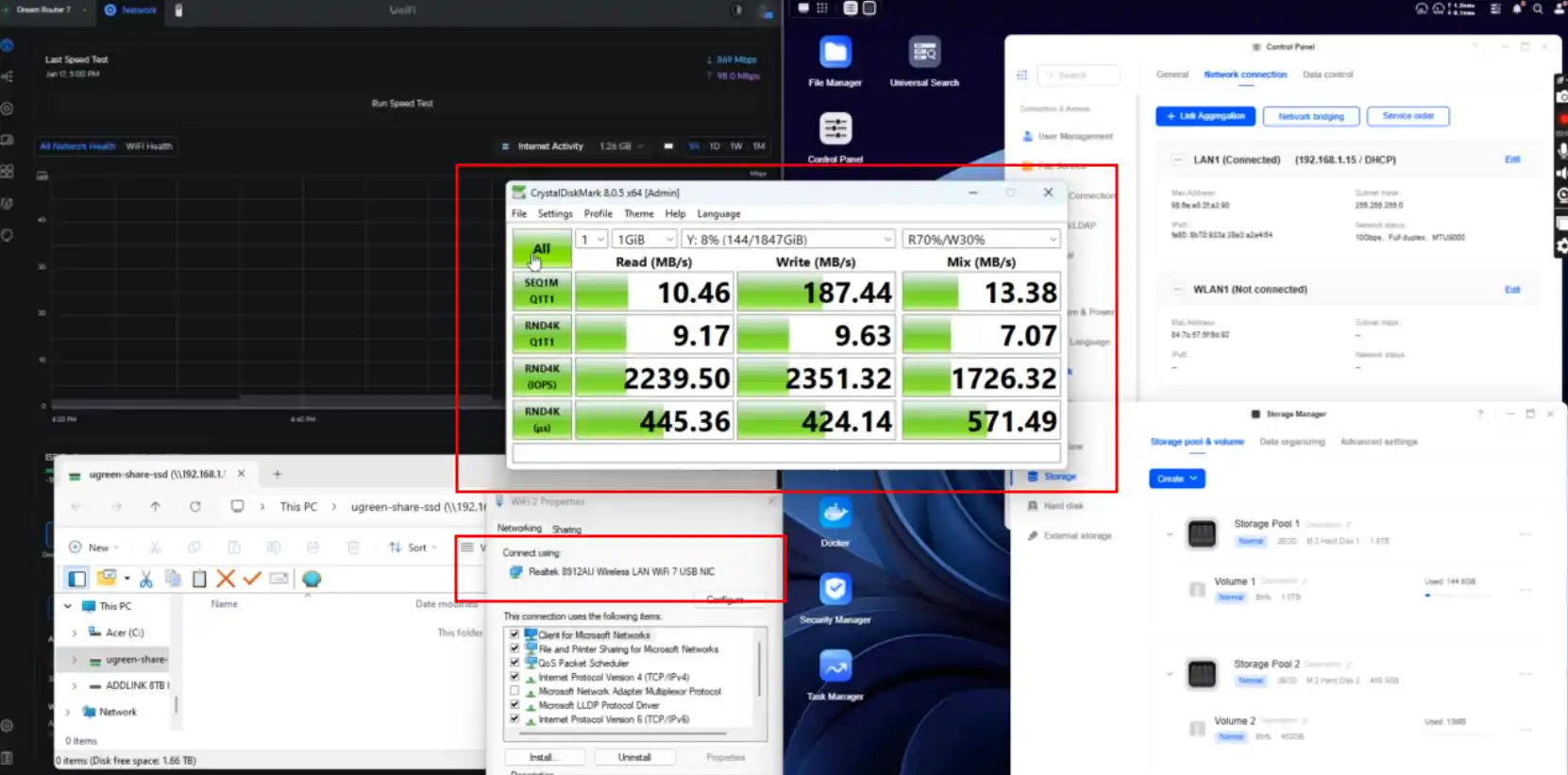
Likewise, similar testing with the WiFi 7 USB Adapter, through the UX7 and at the 10GbE connected NAS hit 260MB/s+ easily. Once again, I would have easily respected this if I had been connecting with the NAS using the 2.5GbE ports – but I am hugely impressed that I was able to hit this benchmark over a WiFi connection (thanks to that 2.8Gbps 6Ghz setup). Respect!

Additionally, it is very easy to monitor the position, WiFi coverage, Channel and performance of any device connected to the UX7 controller software. Also allowing you to create rules on the fly to automatically manage them later as/when devices arrive.

These same controls also extend all the way down to the ISP input of the UX7 AND IF YOU HAVE MULTIPLE uNIfI AP/Nodes in your setup, can control how/where bandwidth is allocated and the priority of devices/nodes that are unique to your own deployment.
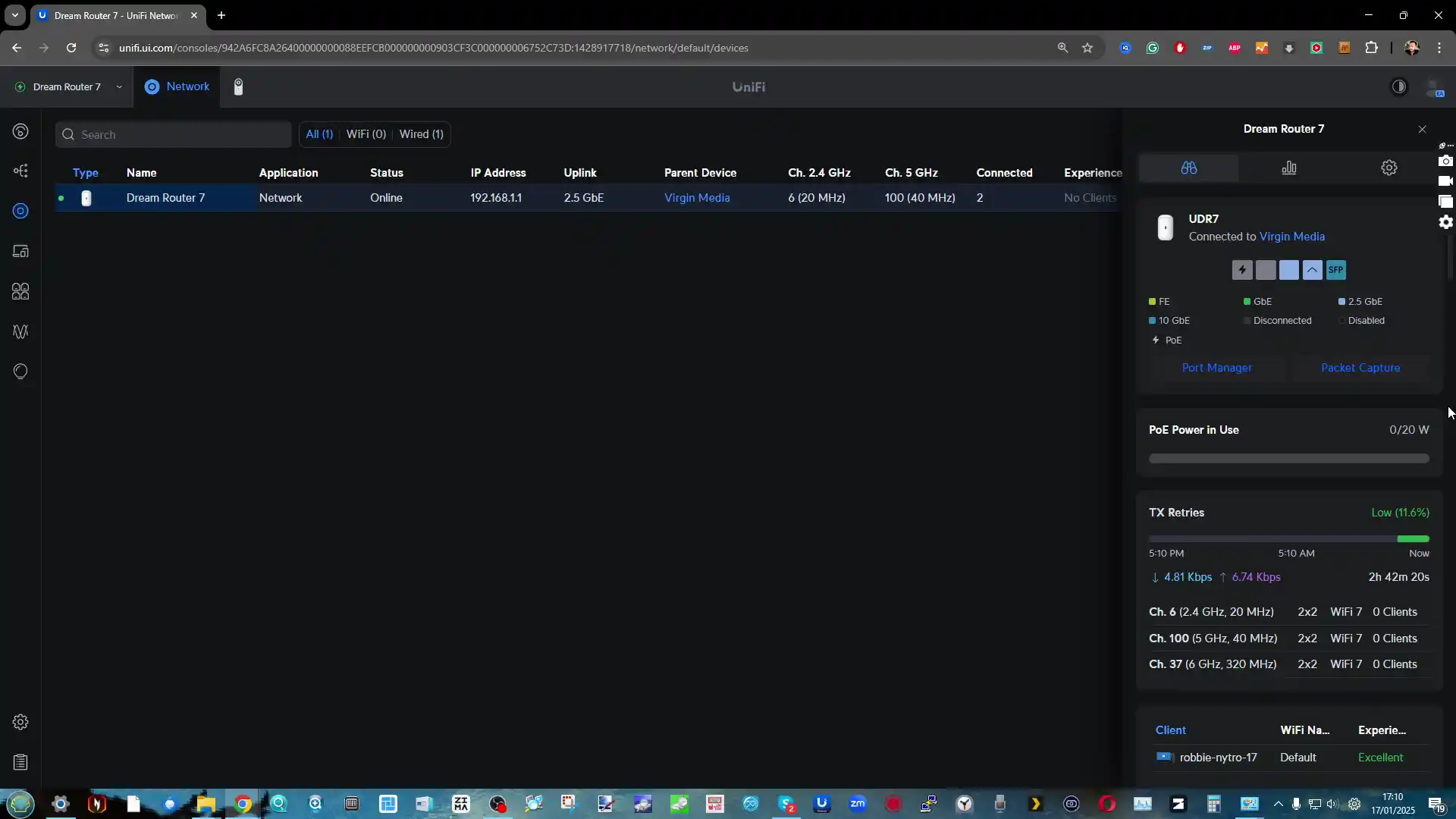
The dashboard features a grouped UI and analytics overview that allows you to see the price traffic that is going into a physical LAN, grouped VLAN or just a single devices on the network – allowing you to see the sites/services/geo data in real time too!
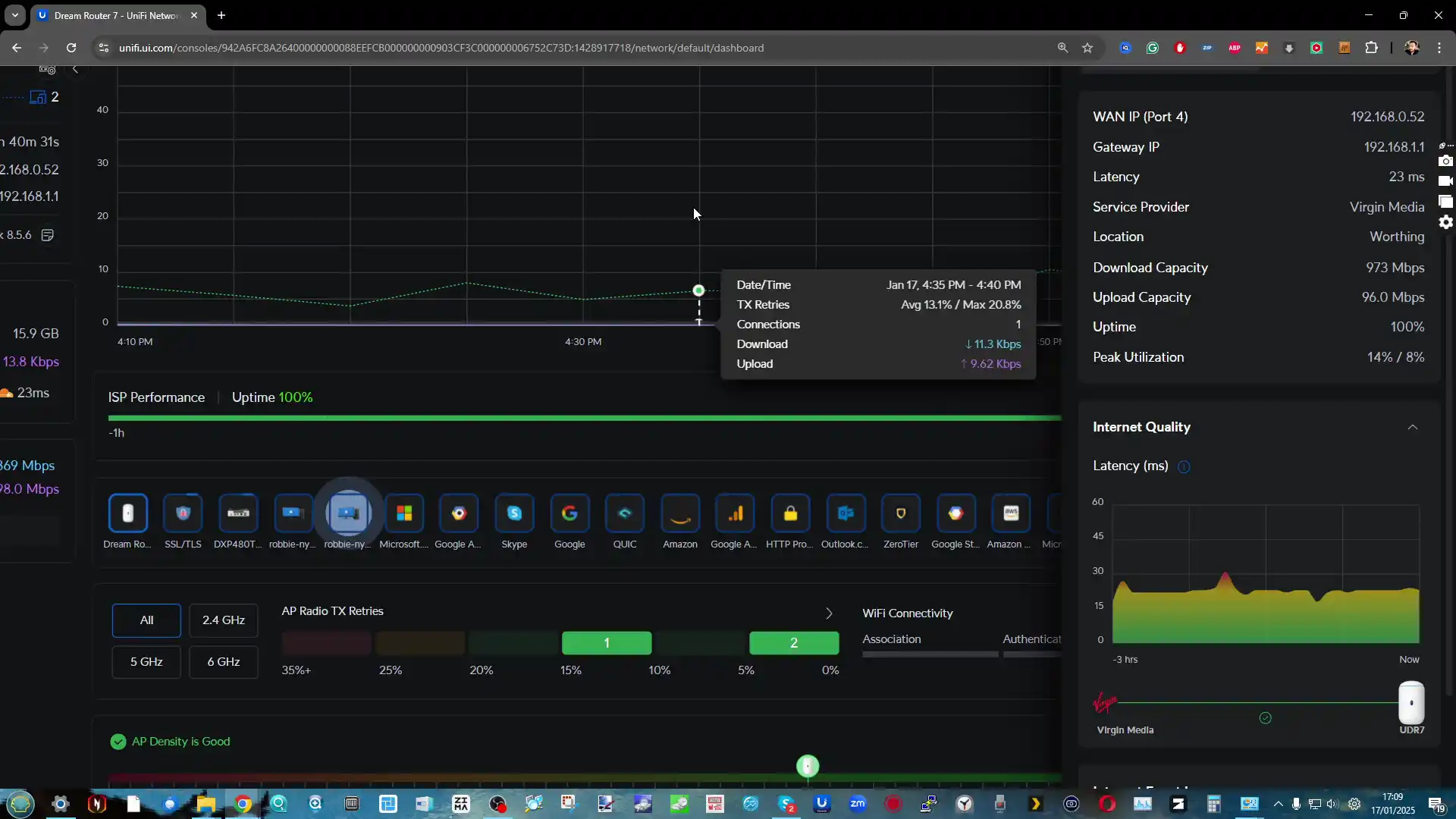
And likewise as before, you can extent these analytics all the way to the root UX7 router to see EVERYTHING happening in realtime in your network and internet connectivity.
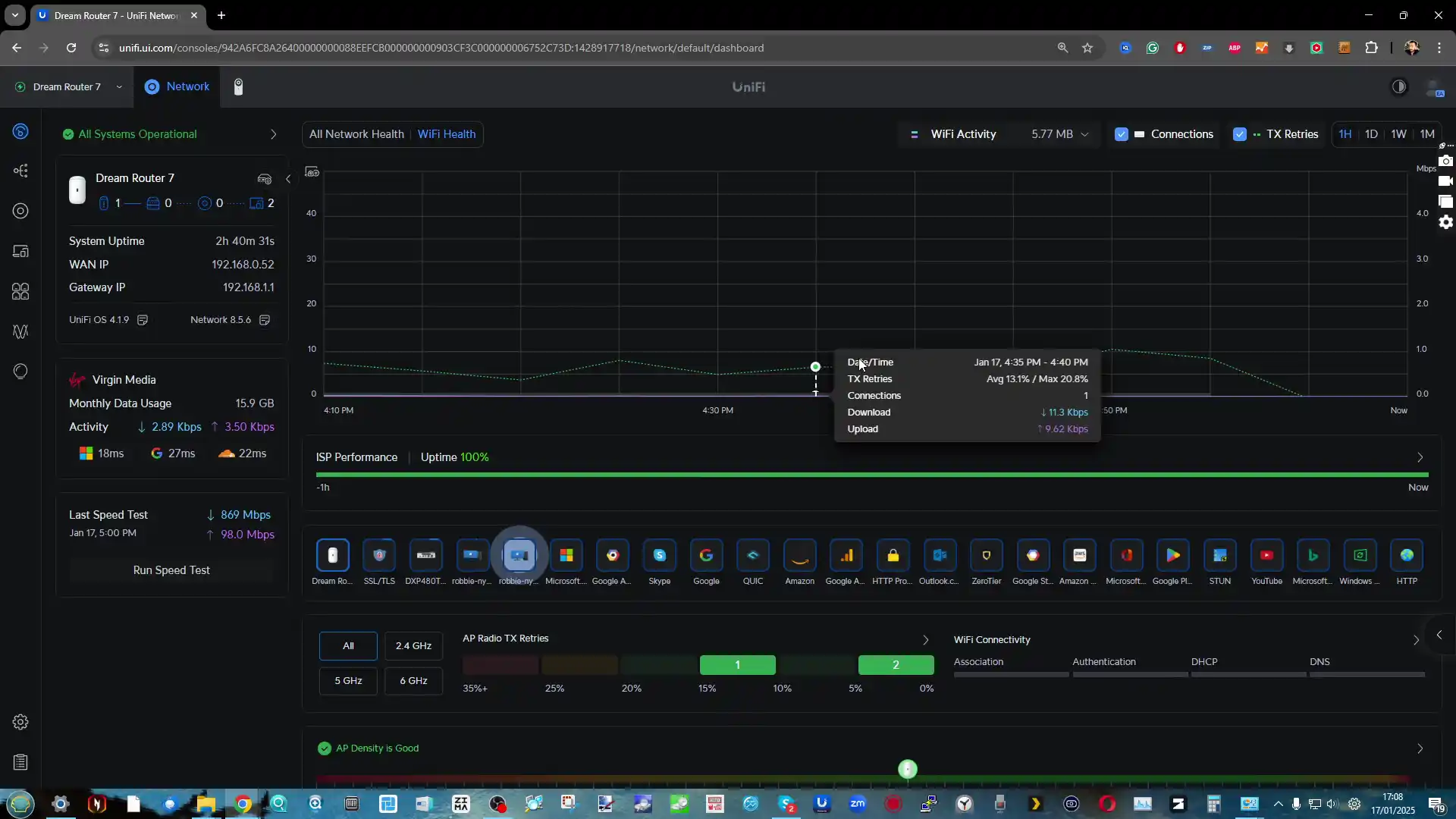
Blacklisting (and whitelisting occasionally) or certain websites is also easy to action manually when needed too – or you can import an existing database of ‘bad’ site lists directly into the UX7 to simplify the process.
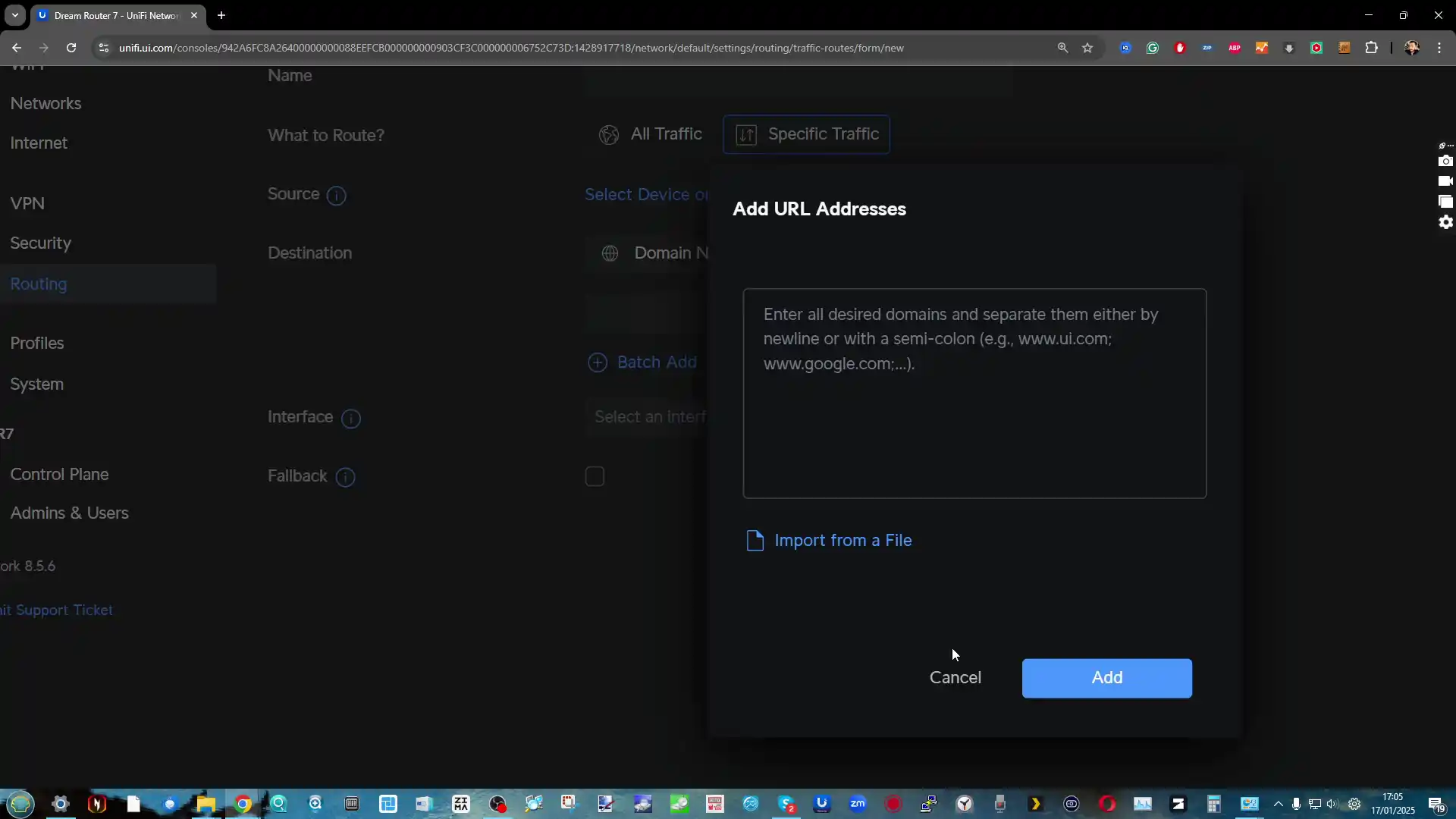
Once rules, priorities, orders of services and limits have been created, you can then apply them to individual devices, networks, groups, vLANS, etc – even to a physical LAN port if needed. These rules are completely customizable and if 1 parameter is changed on the fly, it immediately actions across all selected devices.
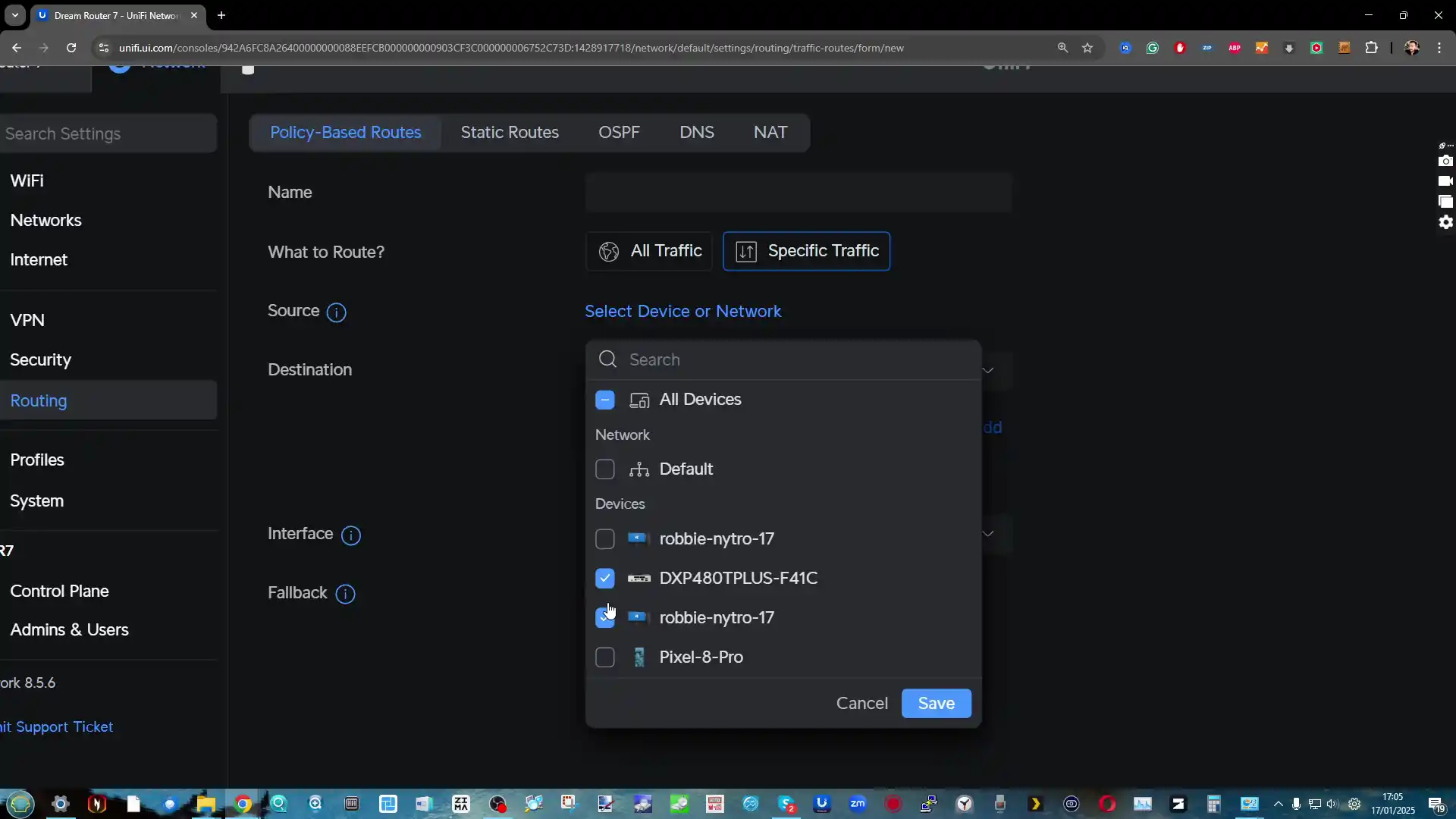
It’s also worth highlighting that UniFi has its own enterprise user identity service (‘Identity Endpoint’) that you can apply to devices if you want to ensure that connected devices on the LAN or WAN are truly secure (client auth tools on each device) and this extends to the VPN and UniFi network client device access too.

I also should stress that although the UX7 seems like a very, VERY proprietary router – UniFi do NOT lock you into having to create an account with them or use only their services. You can set the system up for LOCAL ONLY management and control if you choose. Or even hybrid the two and create 1 secure ‘Identity Endpoint sys admin’, but others are ‘local’ only – nice balance tbh.

And new users (super user or billy basic!) can be created, modified and deleted at any time!
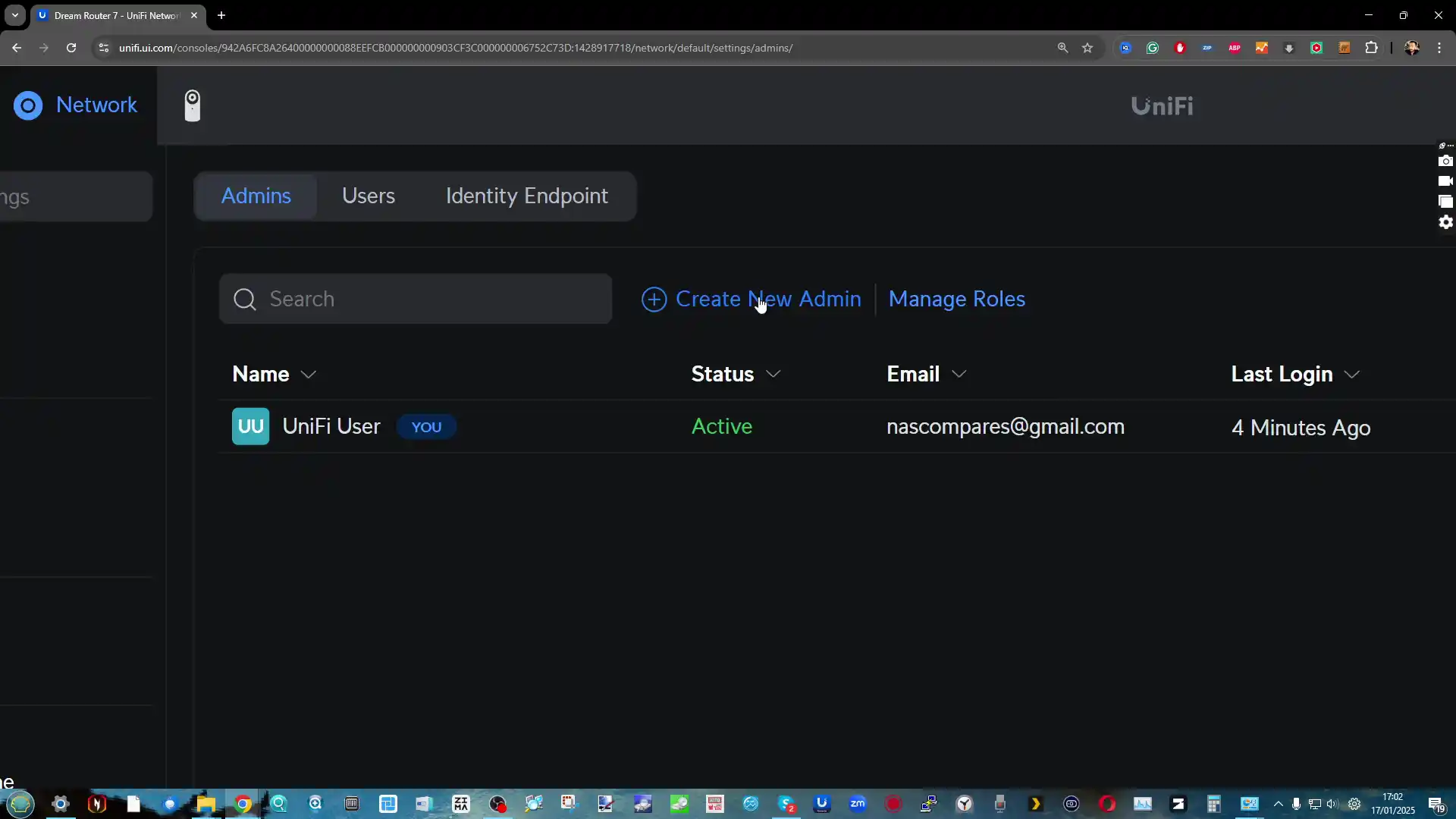
Control and configuration of the UX7 are very straight forward and there are pretty high end configuration options in the backend of the system to control both the local network setup, as well as WiFi connectivity out the box (or added later in the case of systems like the UCG Fiber via the U7/U7 Pro/U6).
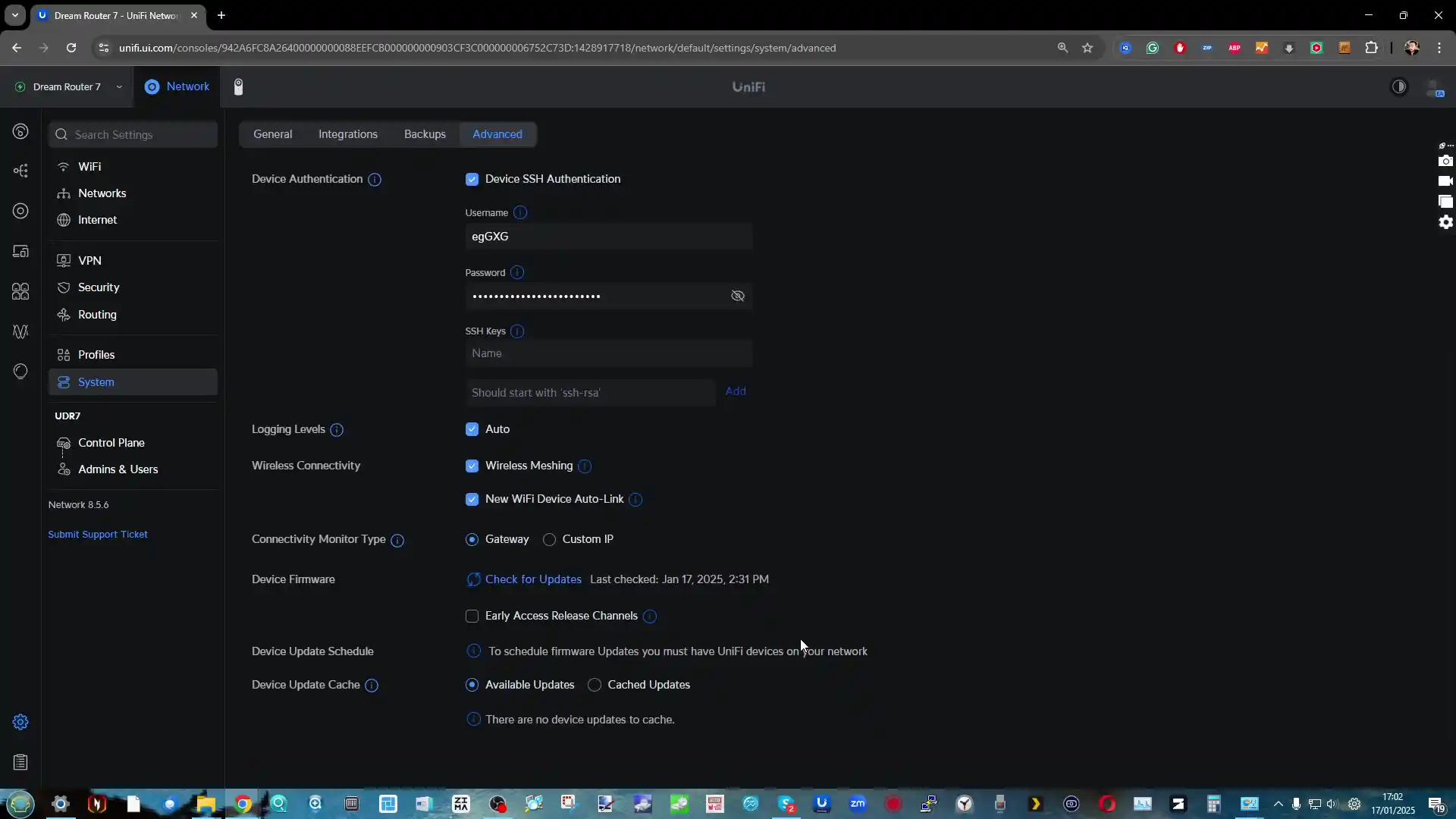
And professional SI’s/Technicians can set the system to ‘truly open’ if they wish, and this can be securely controlled as needed. This allows for opening up frequencies in the case of a WiFi setup down the road and advanced settings related to antenna gain/adaption.
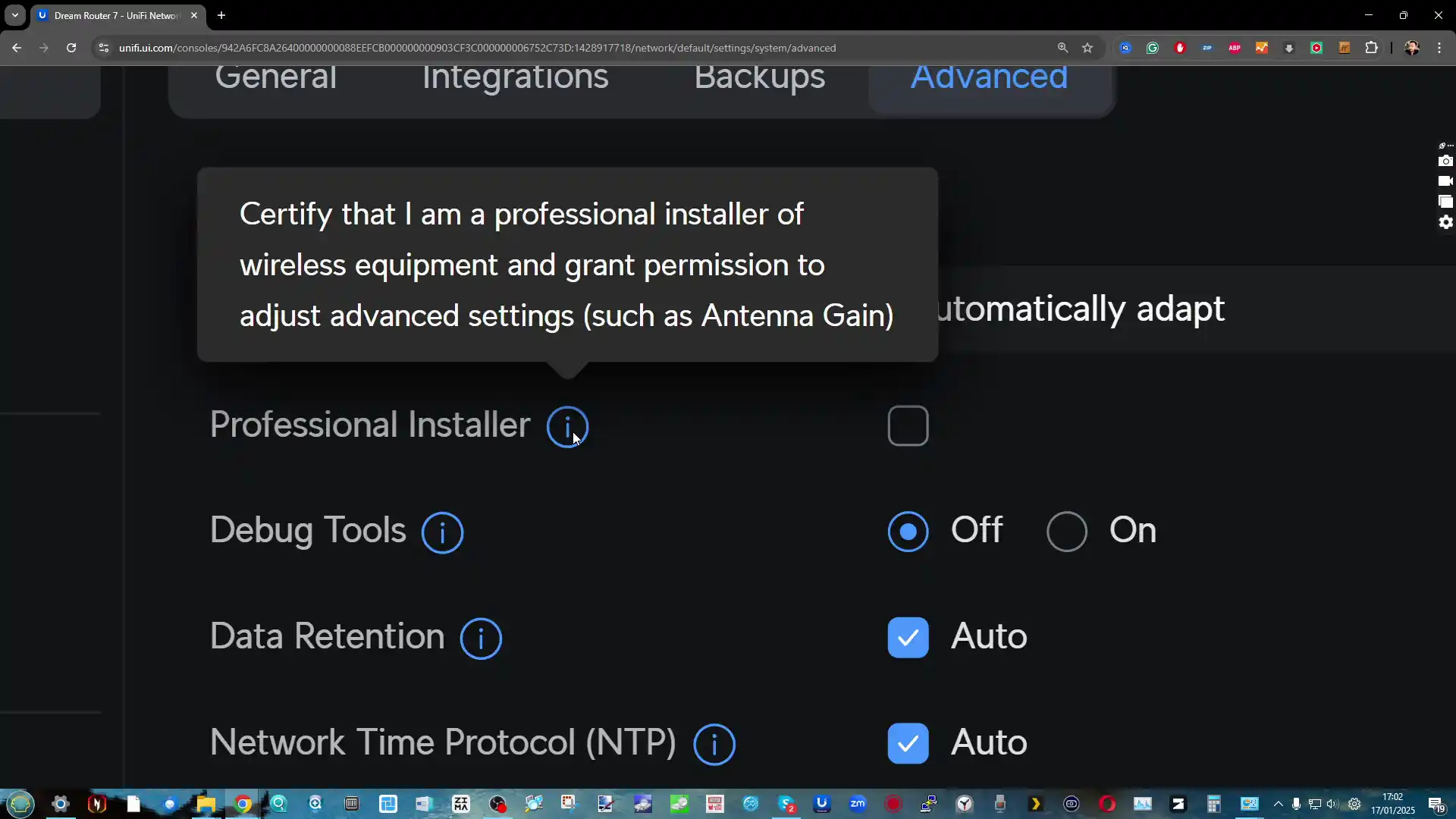
The system configuration and control are surprisingly extensive for a $279 router and puts it well, well into the realms of an enterprise-grade solution, despite its Prosumer/SMB price point.
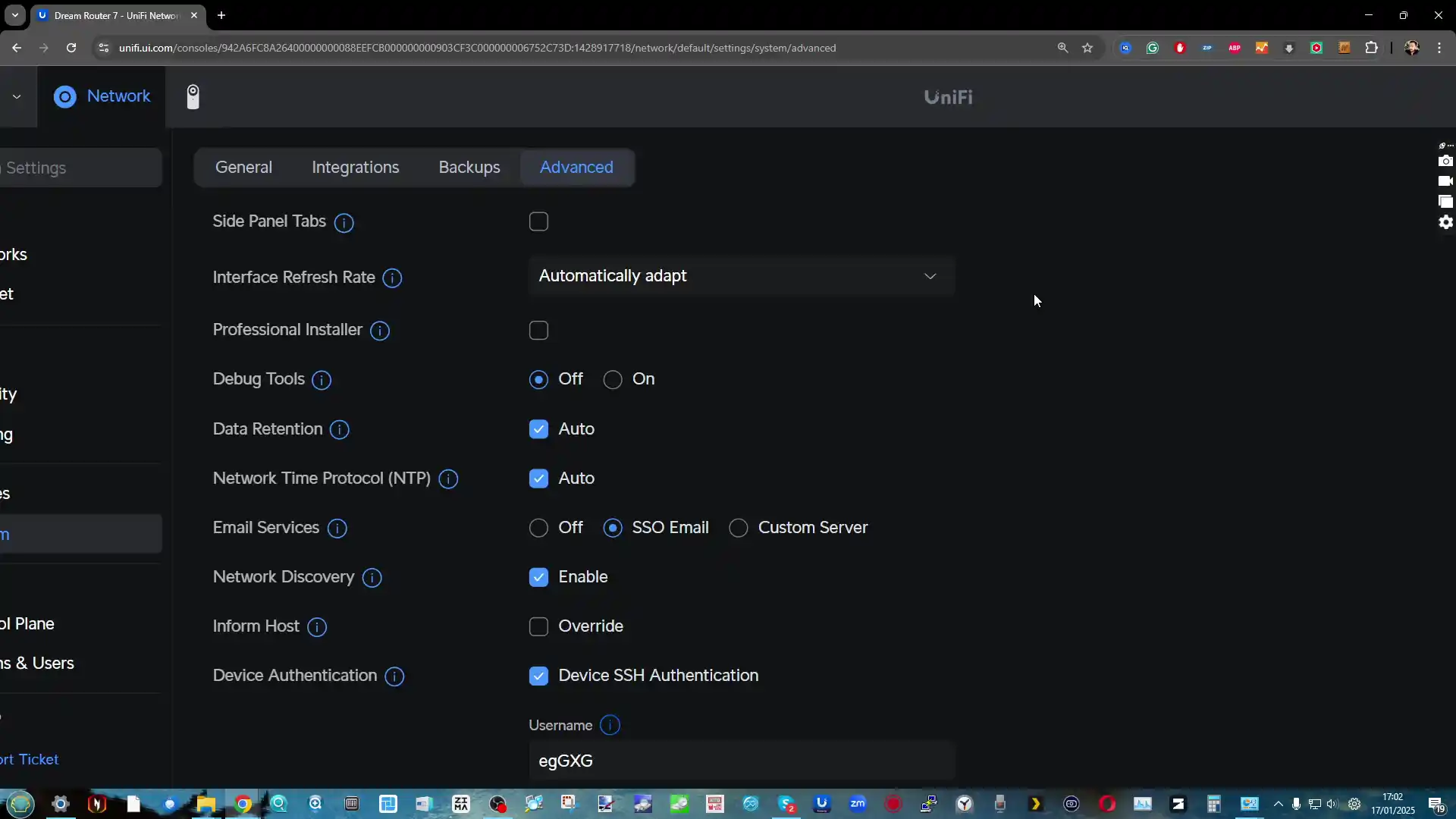
Unsurprisingly, the UX7 has internet speed test tools (either using the native web browser GUI or the WiFiman application for Android/iOS).
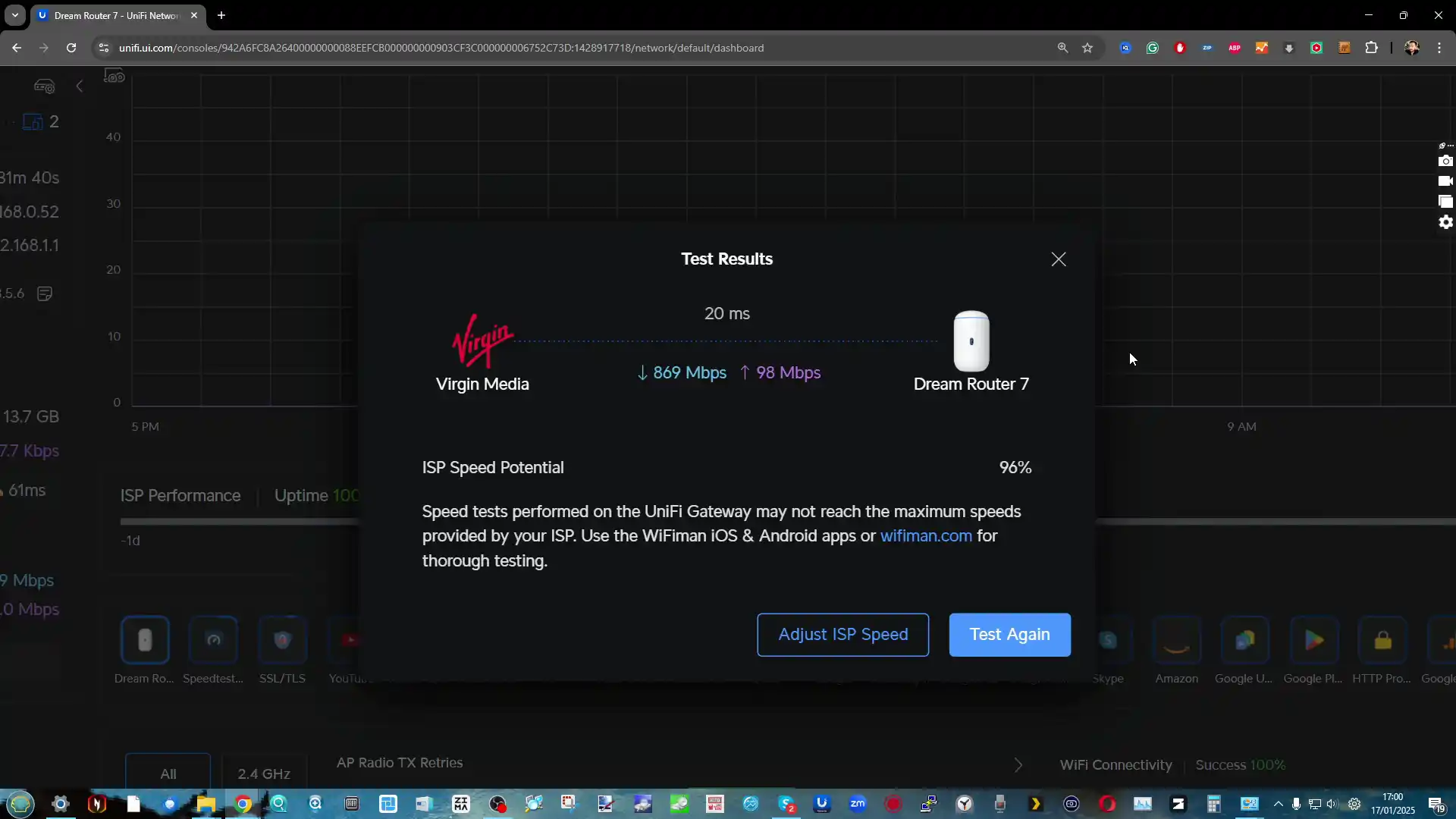
But its goes further, with the ability to monitor the packet management in your network (covered earlier) to such as extent that you can even block the server calls to specific sites/vendors that are going through the UniFi manager and block them SPECIFICALLY. Eg, want to keep google services, but NOT YouTube (either for work/professional reasons, or because of your kids homework deadline?) – you can do that REALLY easily.

And you can apply these rules easily and analytics with ease via the topographical network monitoring window. So you can visually see the devices in the network, then apply the rules, in case a new device gets sneakily added to circumnavigate any limits/restricts in palce.

And if you see a sudden spike in internet use, you can (in seconds) isolate the device that is causing it AND see what it is – allowing yo to block/monitor as needed.
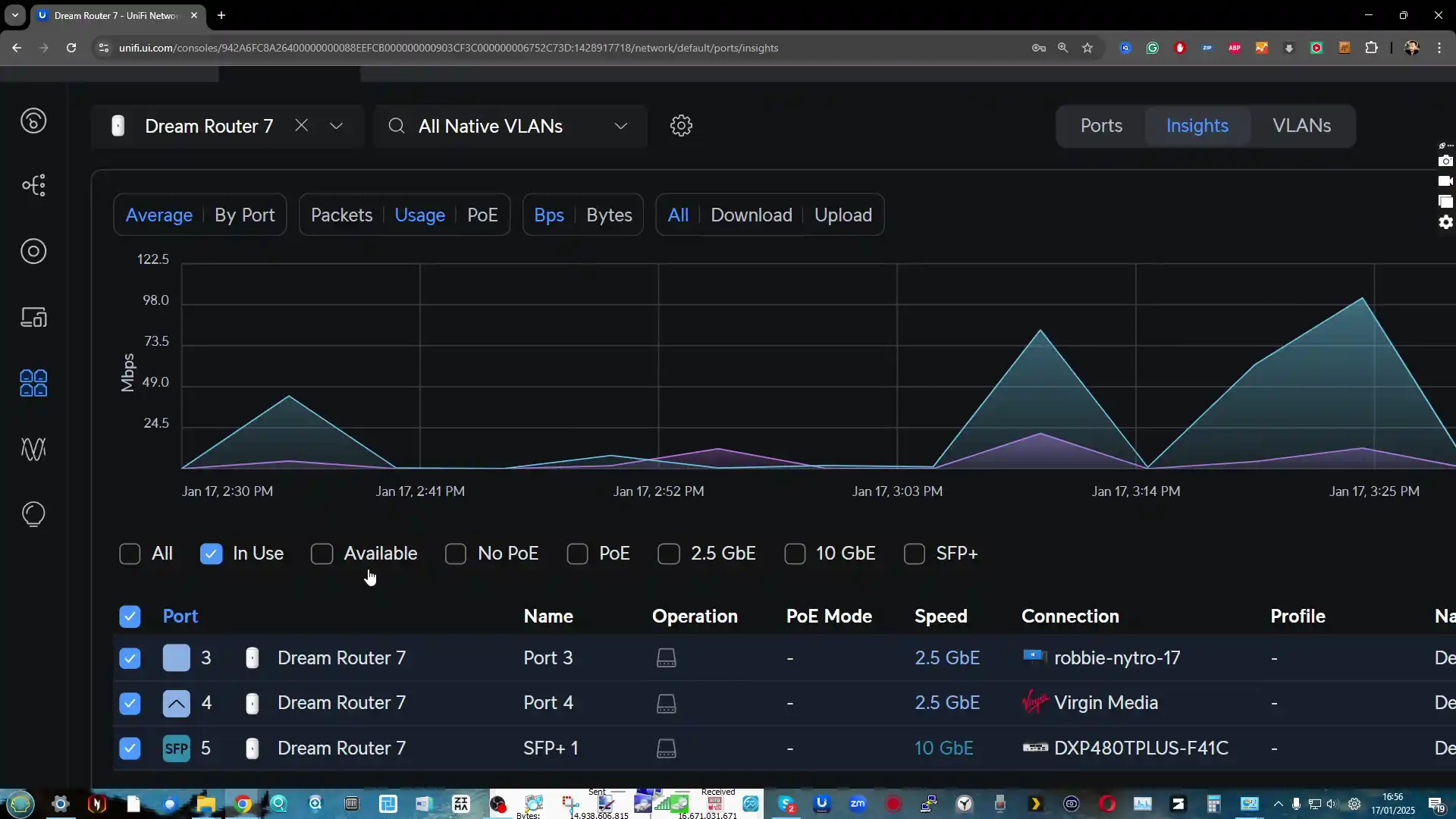
Equally, you can set some pretty extensive security provisions to pre-emptively kick in when an unknown device arrives on the scene, or if an existing device in the network begins to be suspicious.
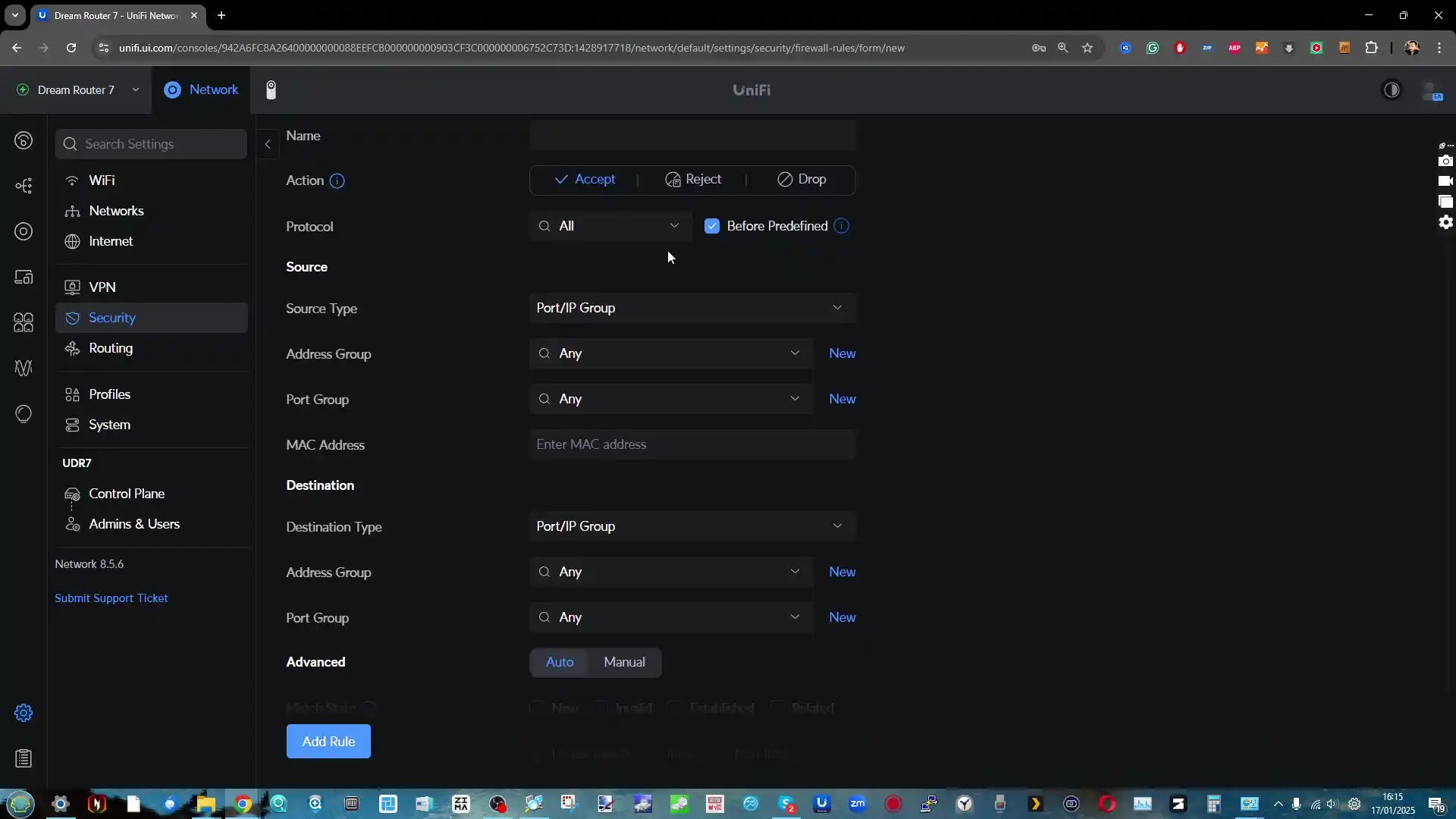
The same goes for creating day 1/100 rules for port forwarding, traffic management and Firewall rules. All of this is HUGELY customizable and most pages in the UniFi GUI feature both ‘simple/easy’ views, as well as much more complex advanced views as needed at the top of each page.
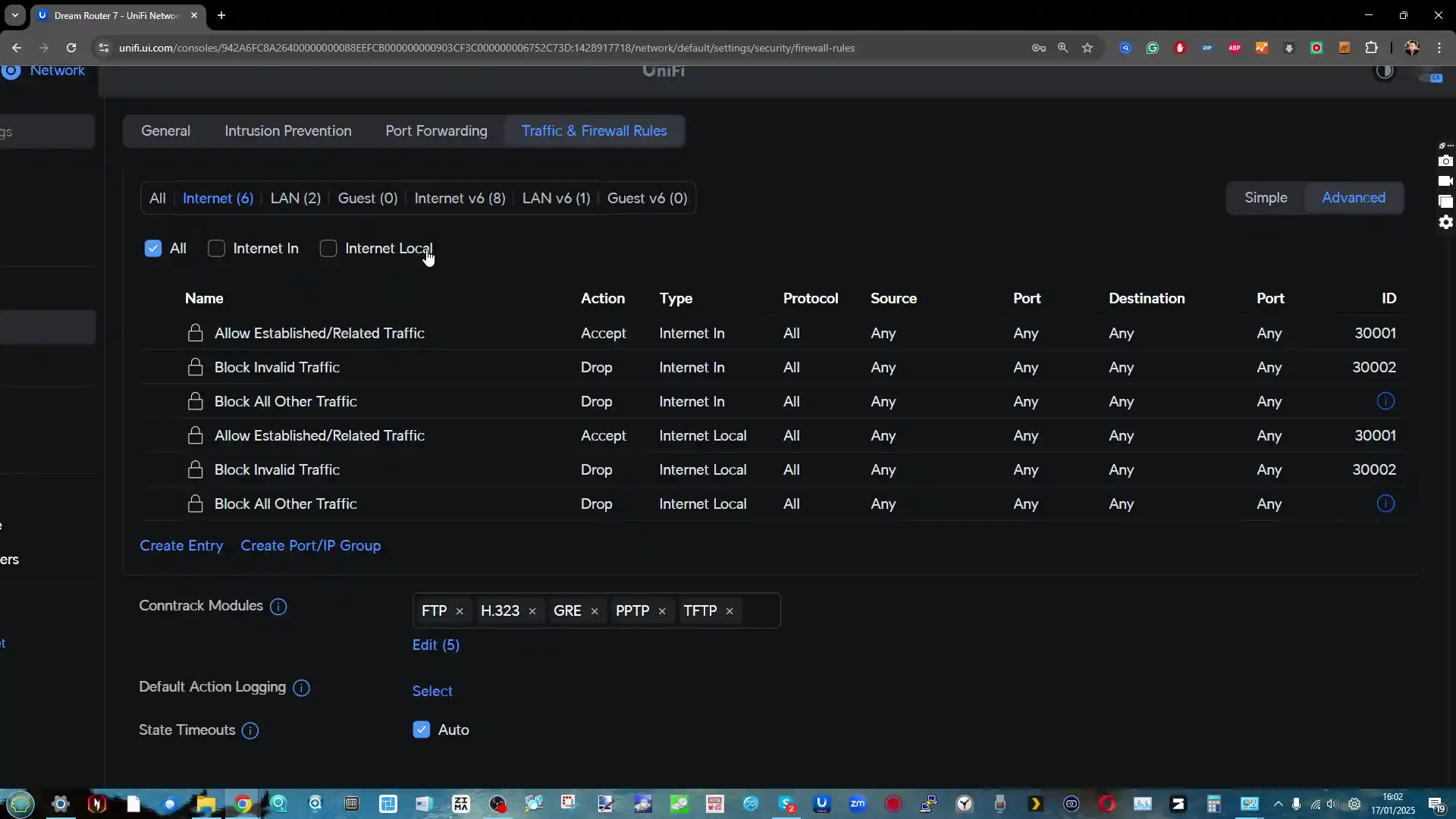
The multiple LAN ports can also be scaled up/down as needed if your existing network is not quite ready for the full network connectivity of the UCG-Fiber too.
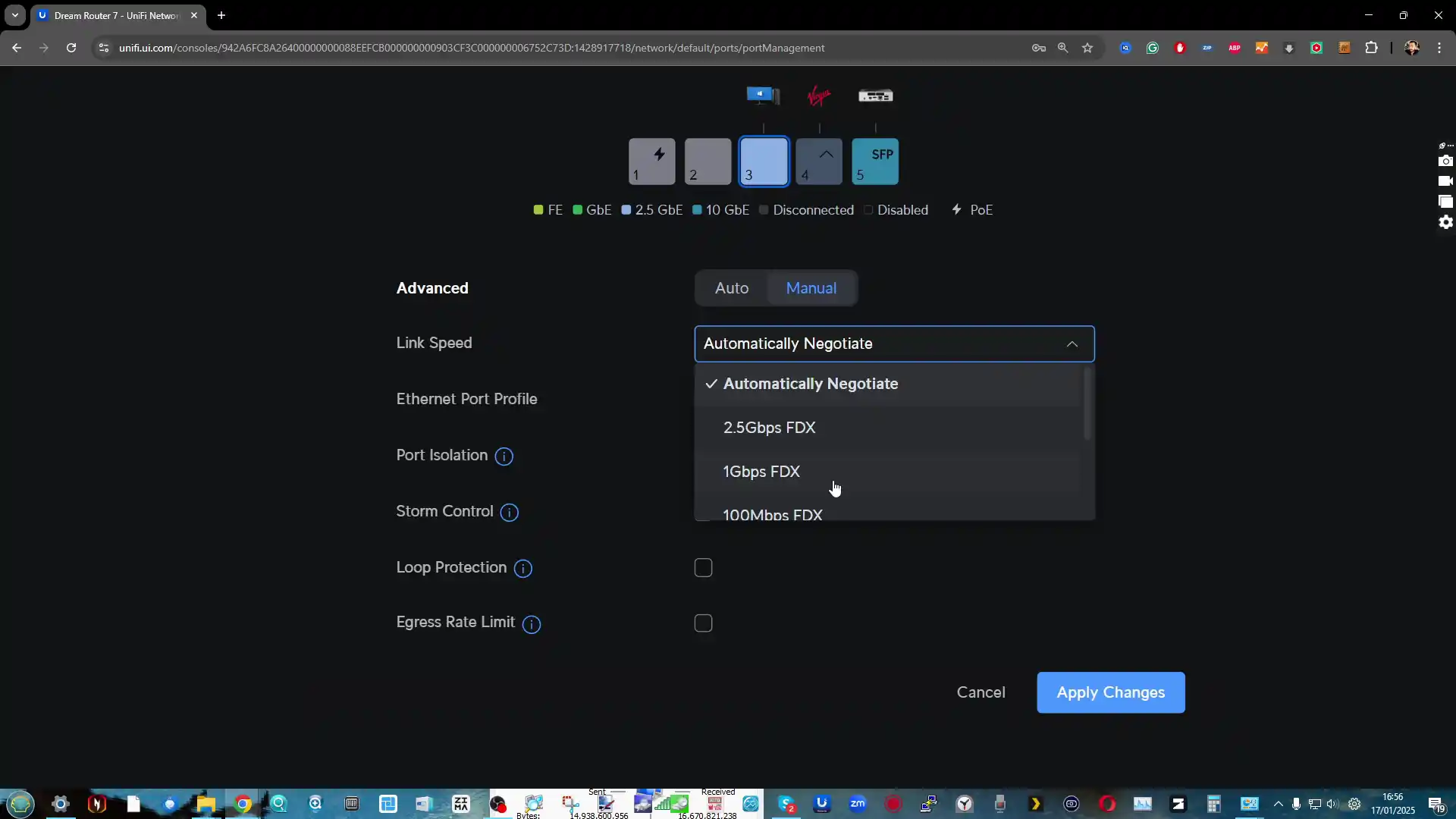
And thanks to the UX7 featuring multiple WAN ports, you can decide how you want to handle multiple ISP services into your home/business, to separate/combine/balance between them with ease across your connected devices.
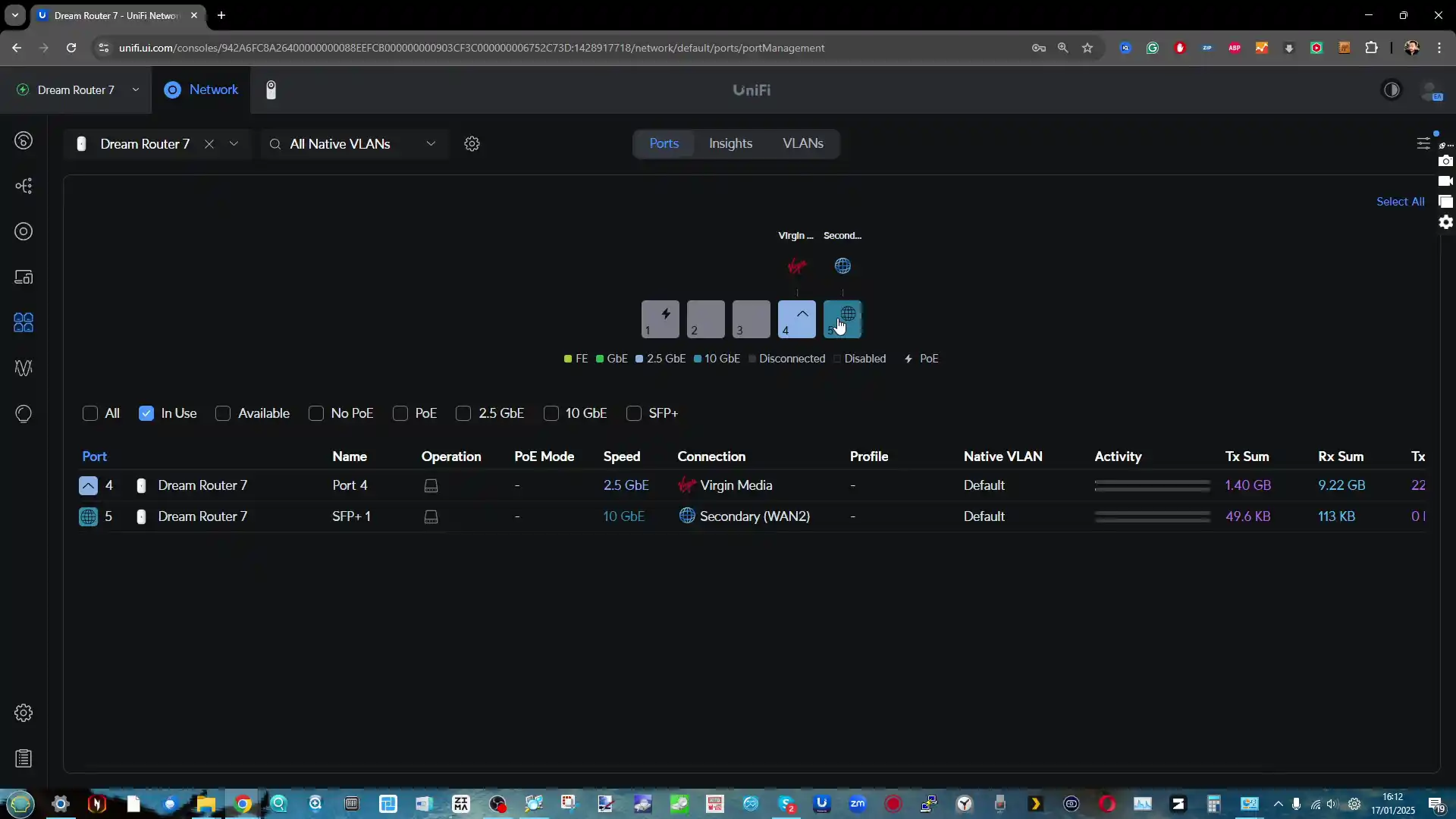
Additionally, each WAN port can be adjusted to a ‘WAN’ or ‘LAN’ roles as needed – even disabled. So, whether it is as a failover internet connection, or that you want to free up that 10GbE port for use as a LAN – The choice is yours!
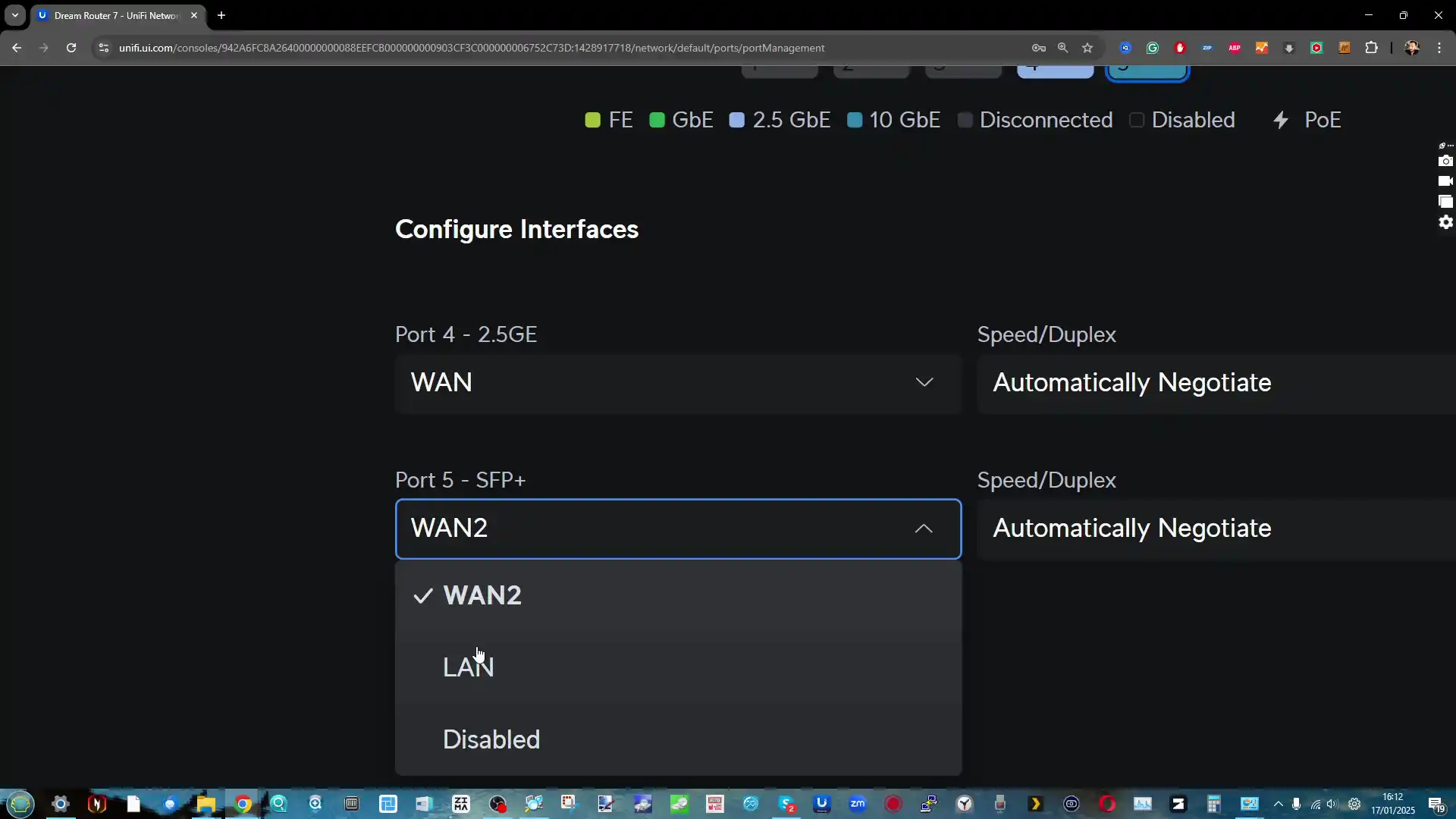
Also, as mentioned earlier, as the system supported internal storage via the slot, you can go ahead and run UniFi Protect surveillance software too – as well as as an additional switch to the available LAN ports, for cameras or add a camera to the POE port.

There are actually several different surveillance, communications, display or smart appliances in the UniFi portfolio that can be installed on the internet storage drive + also means you have more scope for that POE ready port.
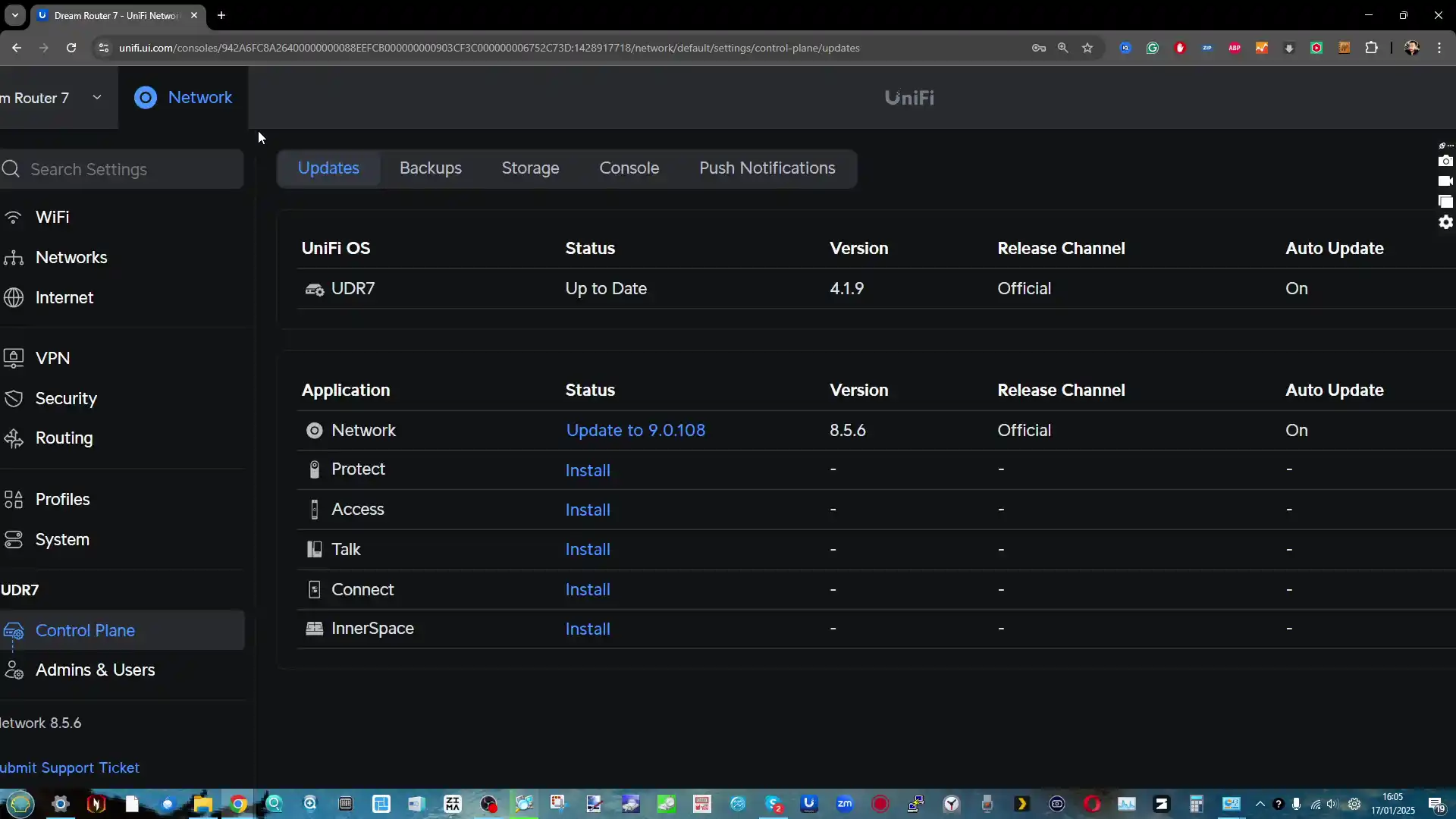
It gets to a point (perhaps) that there are TOO many security and configuration options, and people looking for just a router to ‘just do it’s job’ will be somewhat overwhelmed. Most of the important settings are already set pretty well, but I never the less recommend first time buyers take the time to explore the configuration options present in order to better understand what they are buying here in terms of it’s abilities to protect your network and internet services.
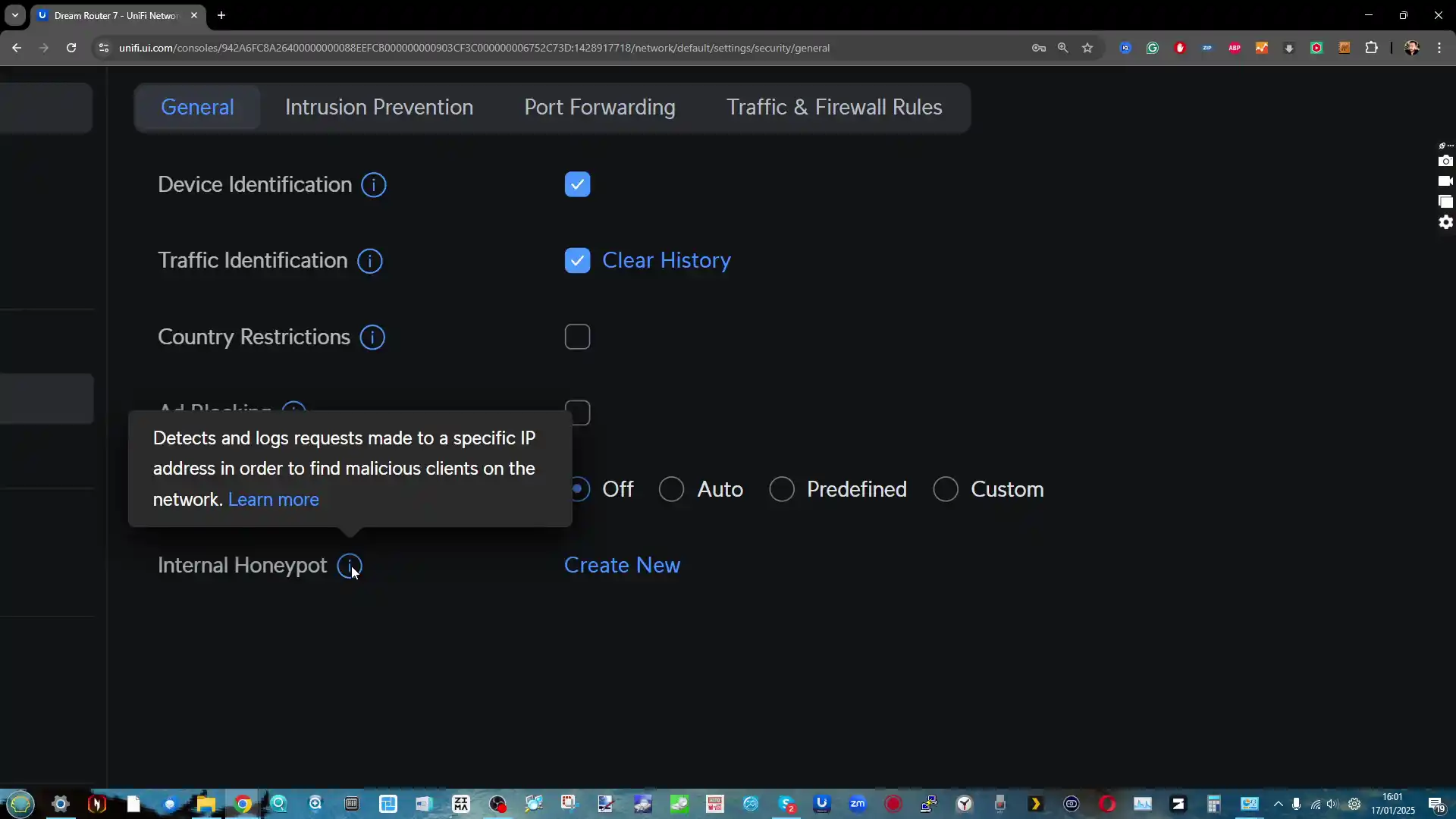
This extends right the way down to the more advanced prevention and intrusion protection measures (Dark Web blocking too). Again, pretty advanced for many, but take the time to look through them if you purchase the UX7.
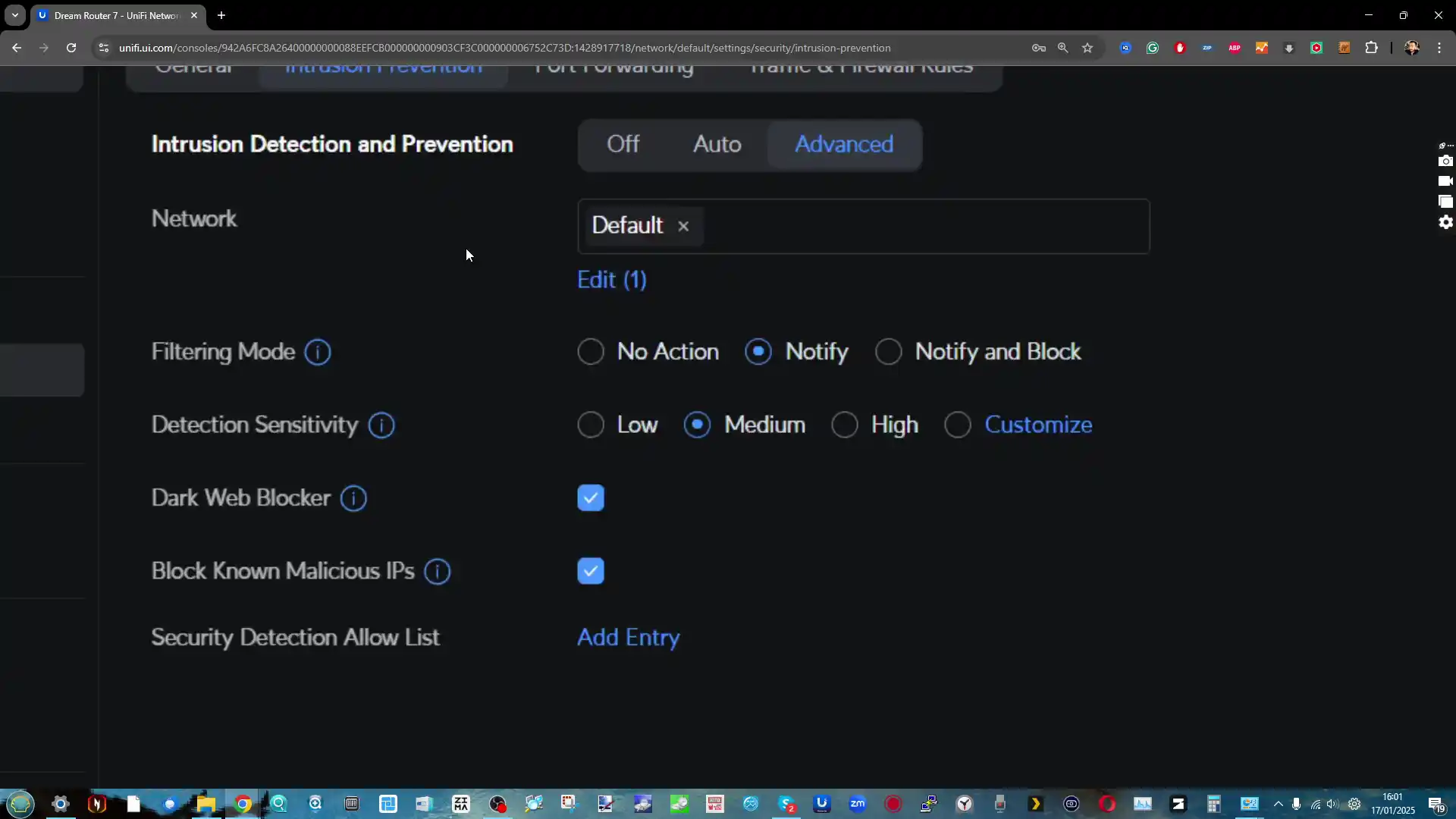
And if in doubt, you can use the UniFi Teleport VPN service to anonymize your site-to-site exchanges (again, very ‘first party’ and more about SD-WAN level stuff, but does form part of the purchase here).

Also, keep in mind that the UX7 has the option to create Airgaps in it’s wired network AND WiFi connectivity (if you want to add that) that allows you to create automated access times – especially useful for businesses who want to lock down access outside of the usual 9-5 operational hours.
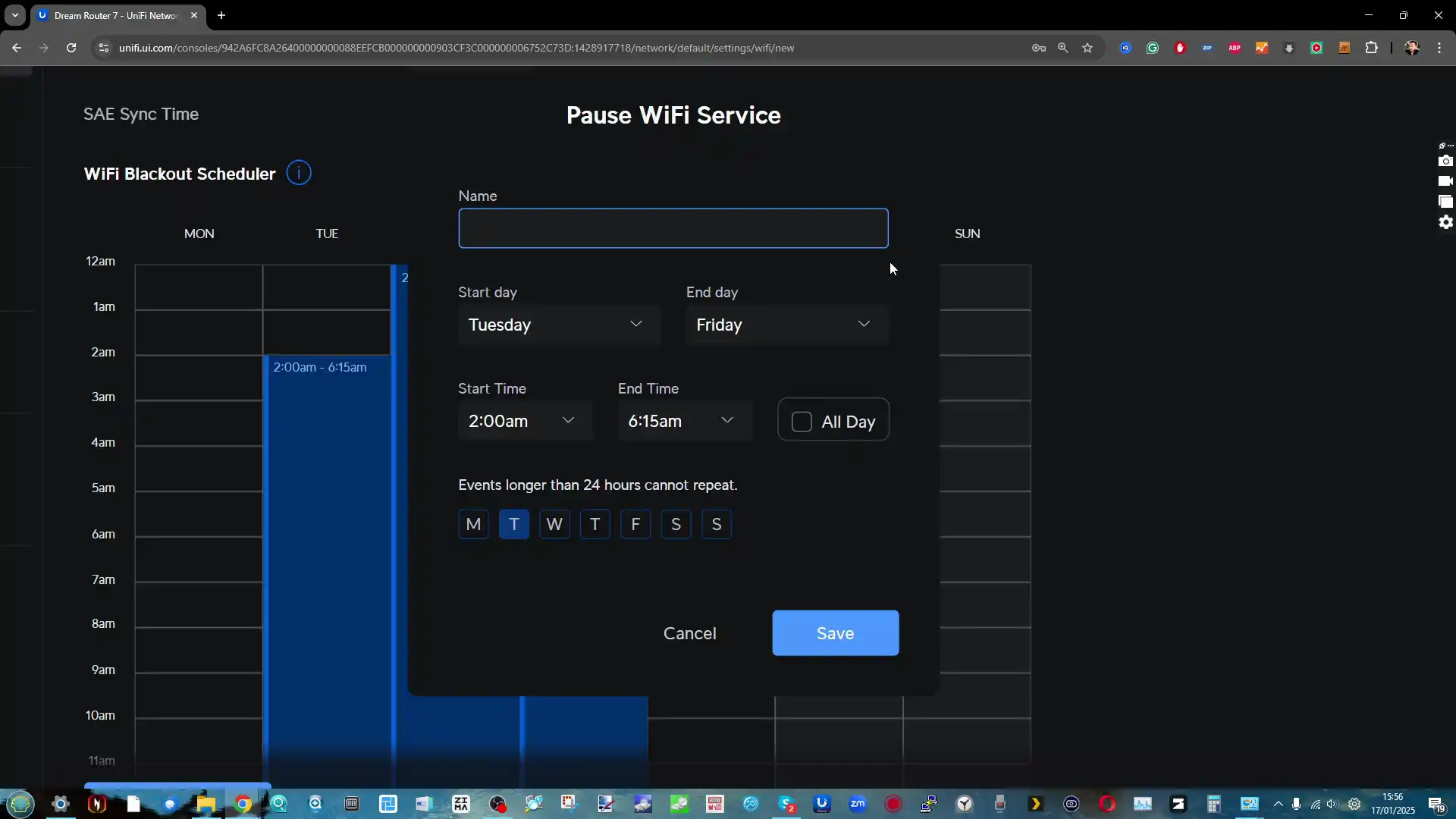
If you want to use WiFi services, yo can create multiple SSIDs of varying degrees of access – and yes, all the controls on security, speed, antenna, frequency, vLAN, etc are all present here too.
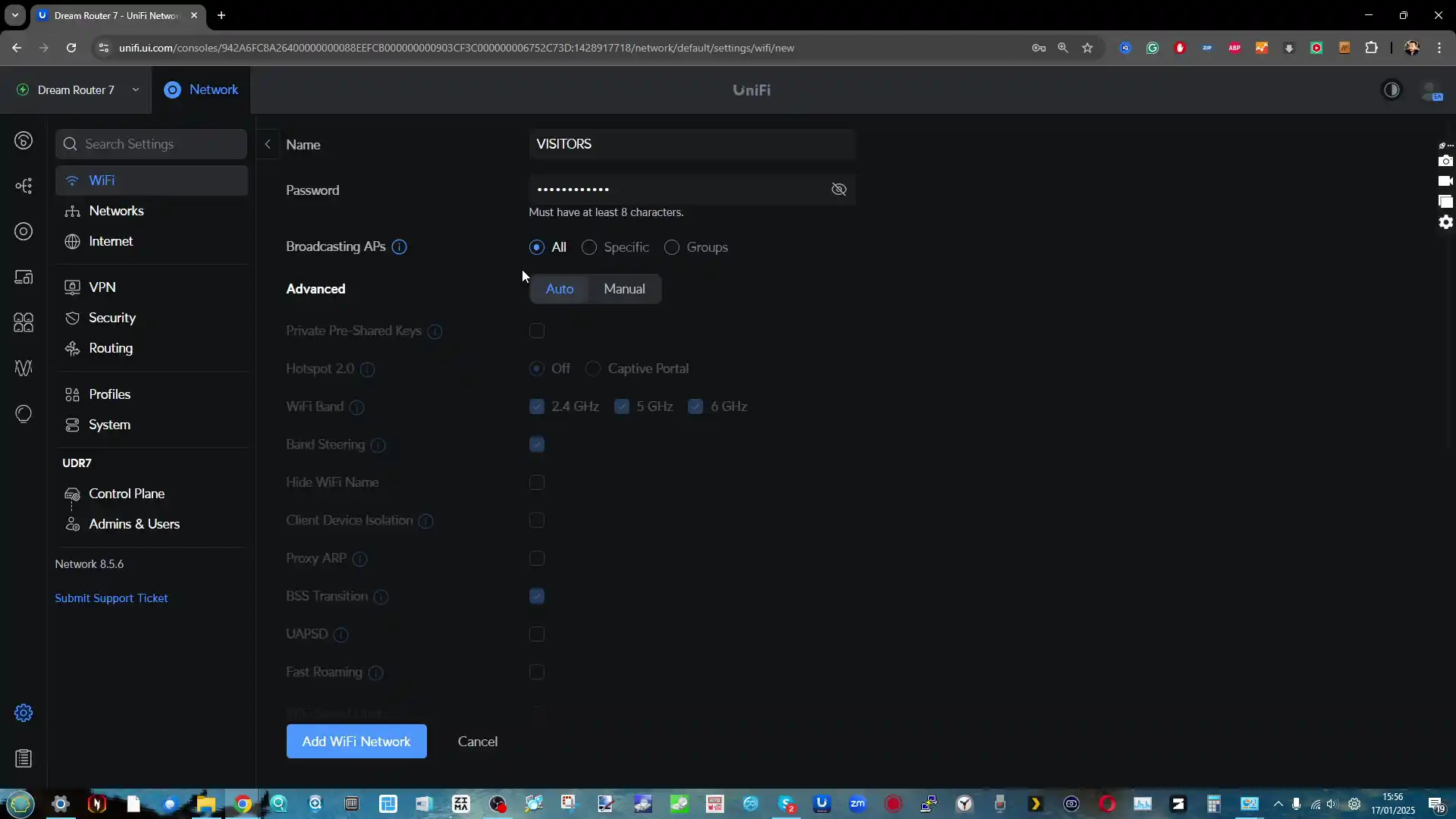
When creating those VLANS, you can add specific physical ports, IDs, WiFi APs etc to that vLAN to segregate your network as securely as possible.
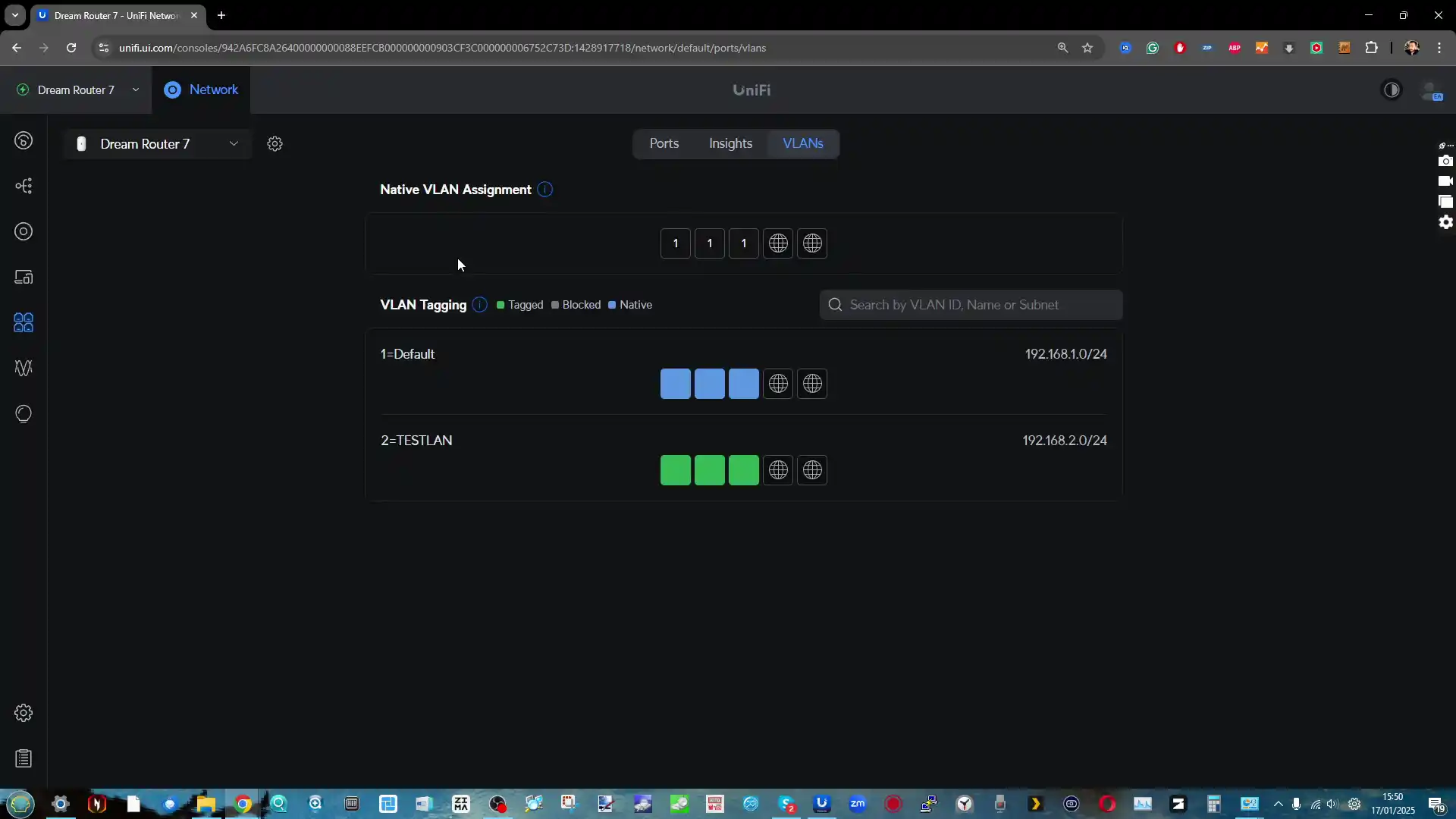
And from there you can adjust the vLAN configuration in terms of it’s smooth operation and security directly from the network management panel (as well as view all active vLANS on one page if needed to see how they interact/clash + show each device you have moved in/out of them easily.
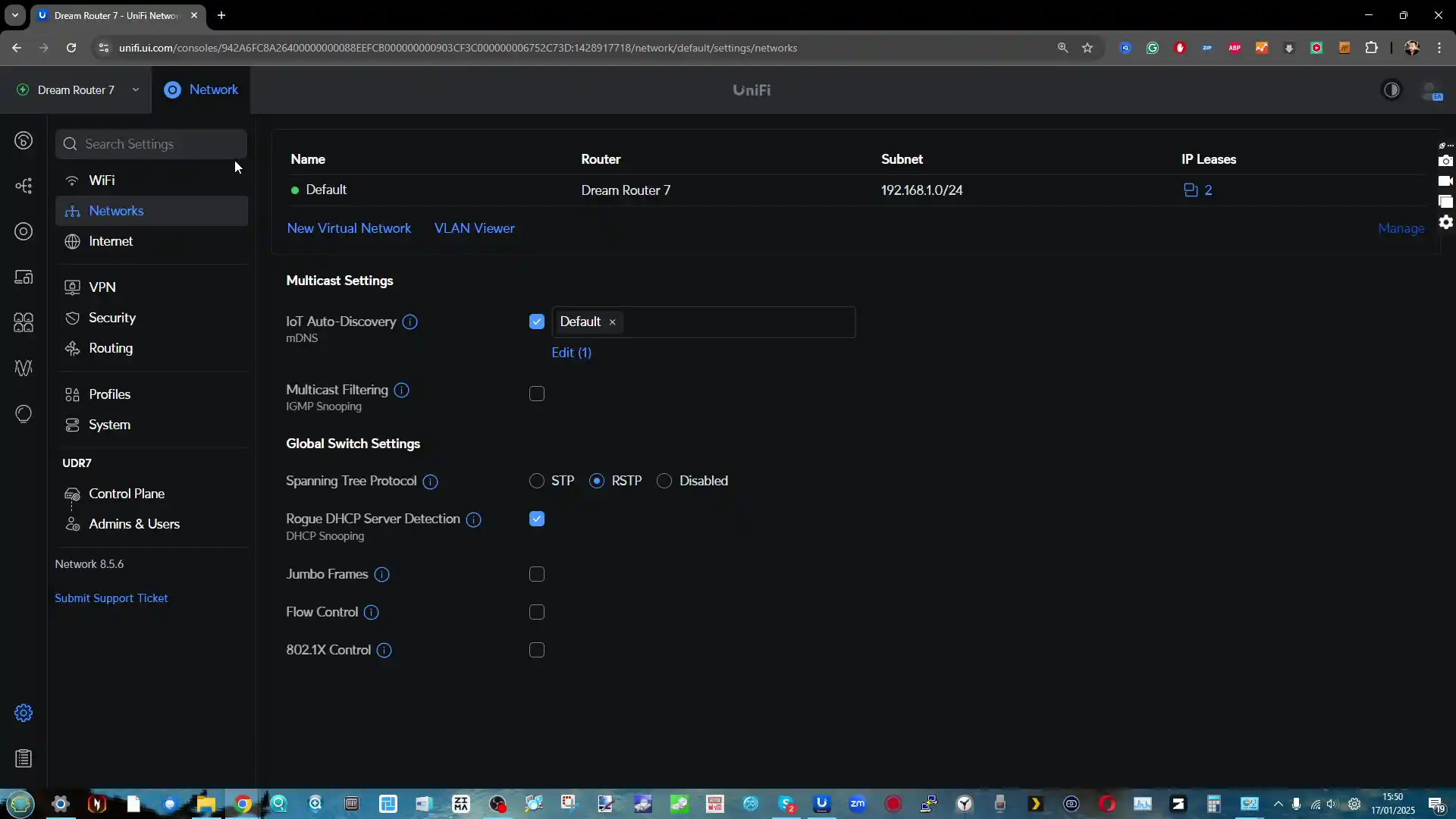
And again, all packet management/monitoring are available within the vLAN if you need.
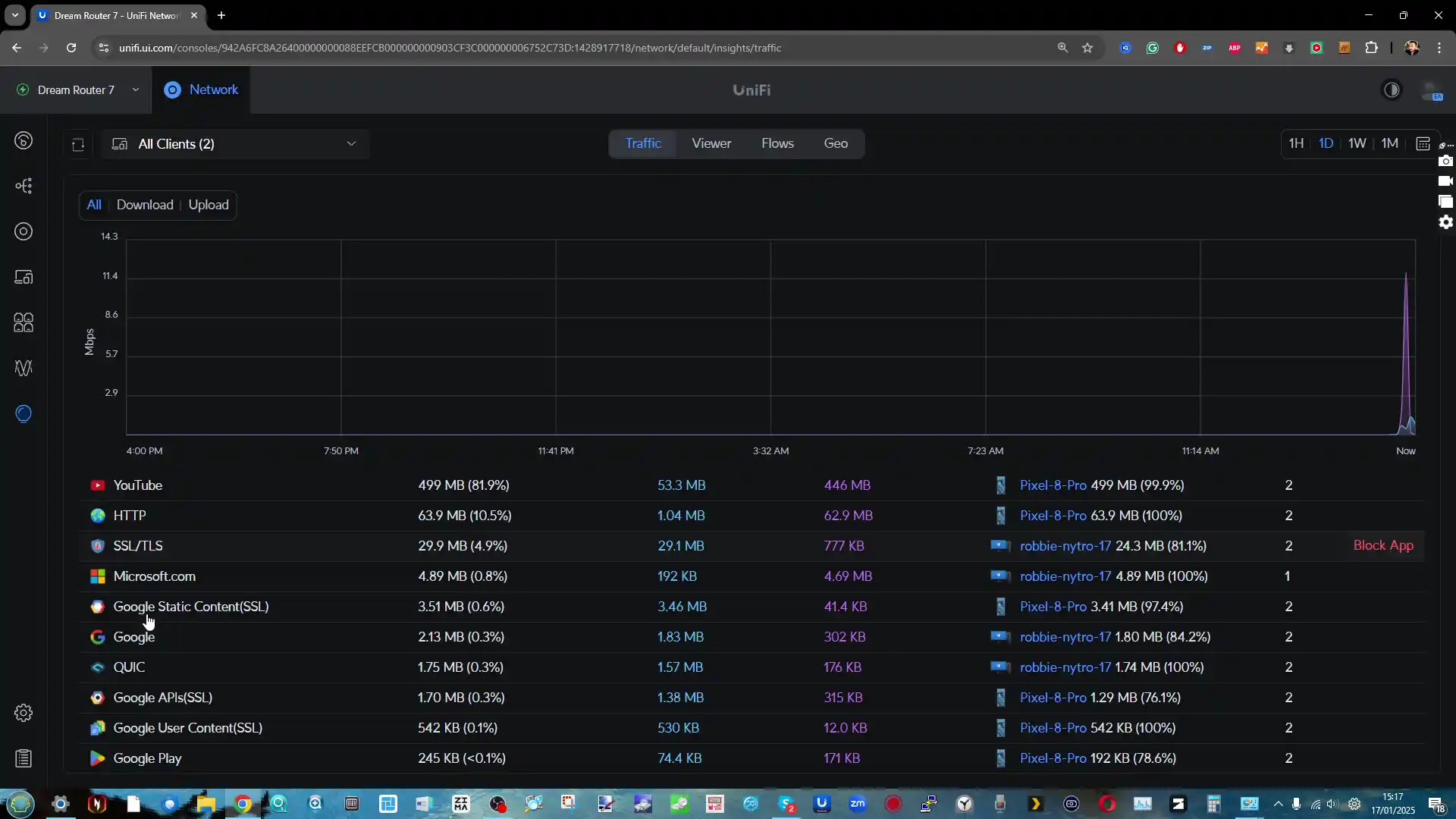
If this all sounds tremendously intimidating, there is a much, MUCH easier 1 panel view in the ‘Insights’ tab that just shows each current network branch and it’s connections/clients in a list format.
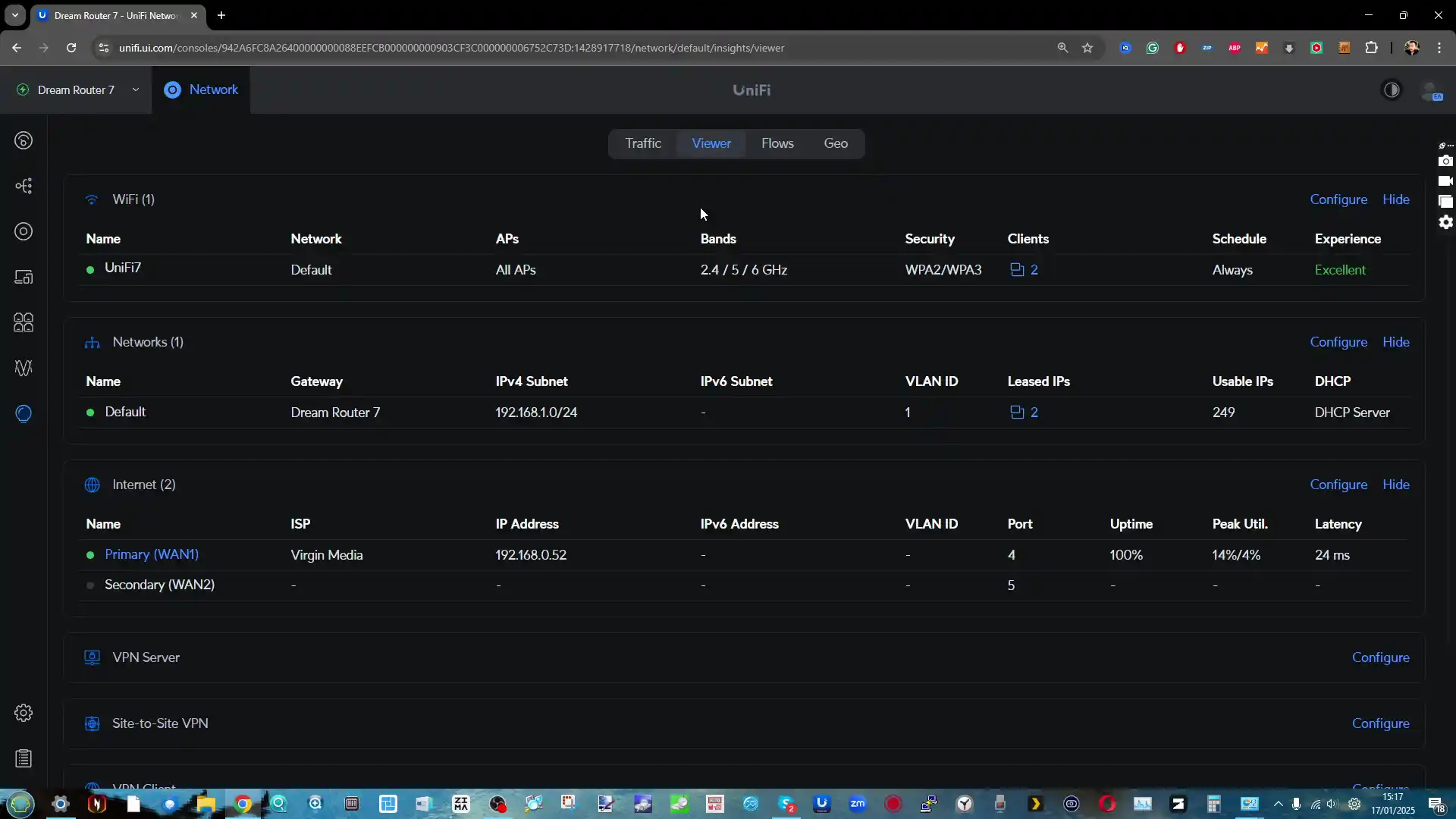
Not good enough? How about a global view that shows the data packet exchange in real time with regard to each region (i.e worried that your data is being harvested to an overseas location, this will show you which countries are currently connected with on your UCG-Fiber for upload/download (websites? server? It’s easy to check and find out here!).
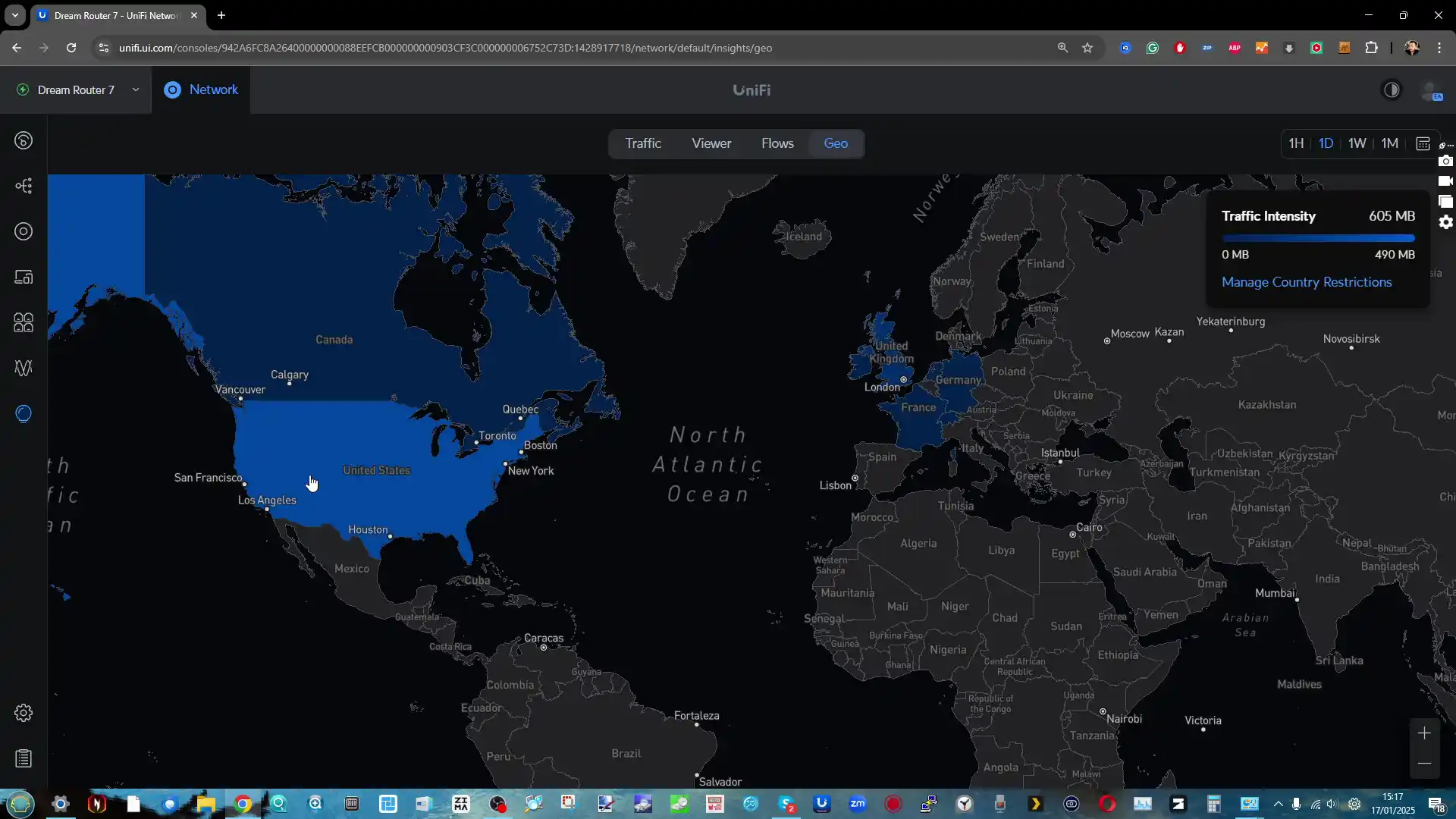
Bottom line – the bulk of the UniFi Control Software here is available on the majority of UniFi Router, Express, Cloud Gateway and Dream Machine devices – but the EXTENT to which you can use it is heavily dependent on the device you buy. In the case of the UX7, you have a fantastic balance of Day 1 control sure, but you have an even better management and scalability on the system for when your ISP services double/triple, as well as the number of devices in your network expand.
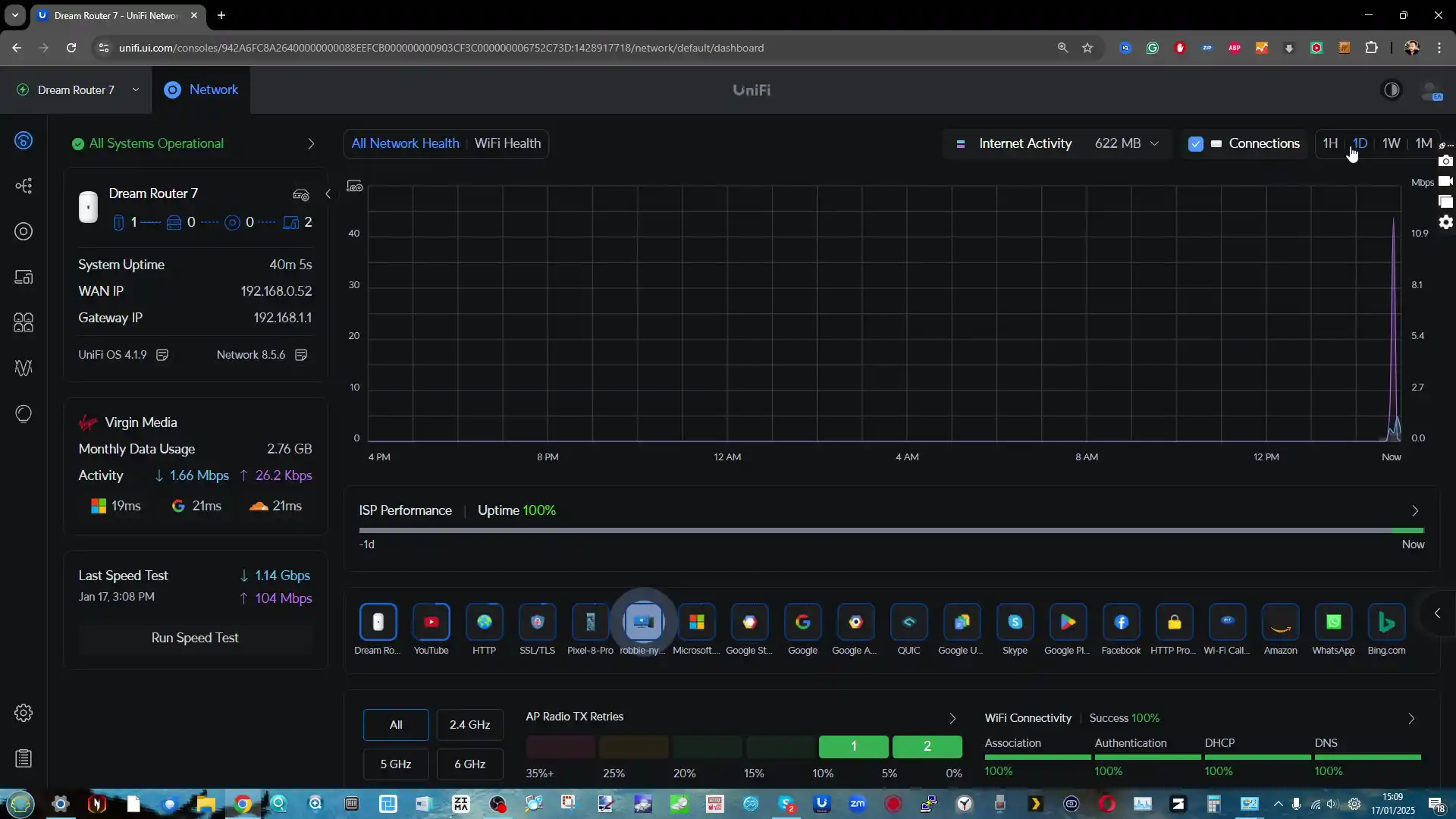
UniFi Express 7 Review – Verdict and Conclusion
If the UniFi Express 7 had been released about six months ago, I think it would stand out considerably more than it does right now. However, sandwiching its launch between the Wi-Fi 7 UDR7 and the highly LAN-capable UCG-Fiber device somewhat muddles the launch of the UX7. The UX7 is a highly capable and highly expandable appliance that serves as an affordable, low-footprint way for home and business users to begin integrating UniFi into their network. Had this cloud gateway device arrived before the Router 7 or Fiber device, I think its integration would have been hugely appealing. However, given the small $49–$79 price difference between the Router/Fiber devices that UniFi launched at the same time, the UX7 does feel a bit underwhelming by comparison. That isn’t to say that the UX7 is a bad device! It really isn’t. UniFi has crammed a huge amount of capability and expandability into an exceedingly small frame, at just 11 cm²!

This is by far the smallest tri-band Wi-Fi 7 fully capable router-style device that I’ve ever seen, and it arrives at a lower price point than Wi-Fi 7 alternatives from Amazon or Google right now. It is also substantially easier to expand into mesh networks, thanks to the U7, U7 Pro, U6, and U6 Wall devices. Equally, the ease of adoption and integration of UniFi switches into the UX7 down the road means that you can granularly and much more affordably expand your network of UniFi devices over the years. This is a great deal easier than having to spend more money upfront on hardware that you may not even fully utilize in your network for a few years to come. Future-proofing and expandability are once again the key selling points here, but just keep in mind that there are alternatives to this product (including from UniFi themselves) available right now. It would be wise to spend a little more time considering whether those slightly more hardware-rich devices—at less than $100 more from UniFi—might be better suited to your needs.
| PROS | CONS |
|
|
| Where to Buy
UniFi Express 7 (UX7) –$199 HERE UniFi Cloud Gateway Fiber (UCG-FIBER) – $249 HERE UniFi Dream Router 7 (UDR7) – $279 HERE |
🔒 Join Inner Circle
Get an alert every time something gets added to this specific article!
This description contains links to Amazon. These links will take you to some of the products mentioned in today's content. As an Amazon Associate, I earn from qualifying purchases. Visit the NASCompares Deal Finder to find the best place to buy this device in your region, based on Service, Support and Reputation - Just Search for your NAS Drive in the Box Below
Need Advice on Data Storage from an Expert?
Finally, for free advice about your setup, just leave a message in the comments below here at NASCompares.com and we will get back to you. Need Help?
Where possible (and where appropriate) please provide as much information about your requirements, as then I can arrange the best answer and solution to your needs. Do not worry about your e-mail address being required, it will NOT be used in a mailing list and will NOT be used in any way other than to respond to your enquiry.
Need Help?
Where possible (and where appropriate) please provide as much information about your requirements, as then I can arrange the best answer and solution to your needs. Do not worry about your e-mail address being required, it will NOT be used in a mailing list and will NOT be used in any way other than to respond to your enquiry.

|
 |
Beelink ME Pro NAS Revealed
Best SOLID STORAGE NAS of 2025
Should You Worry About the NanoKVM Hidden Microphone?
Best Cheap NAS of 2025
Minisforum MS-02 Ultra - WHO IS THIS FOR??? (The First 48HRs)
Why People Use TrueNAS, UnRAID and Proxmox to Turnkey NAS (Synology, QNAP, etc)
Access content via Patreon or KO-FI
Discover more from NAS Compares
Subscribe to get the latest posts sent to your email.


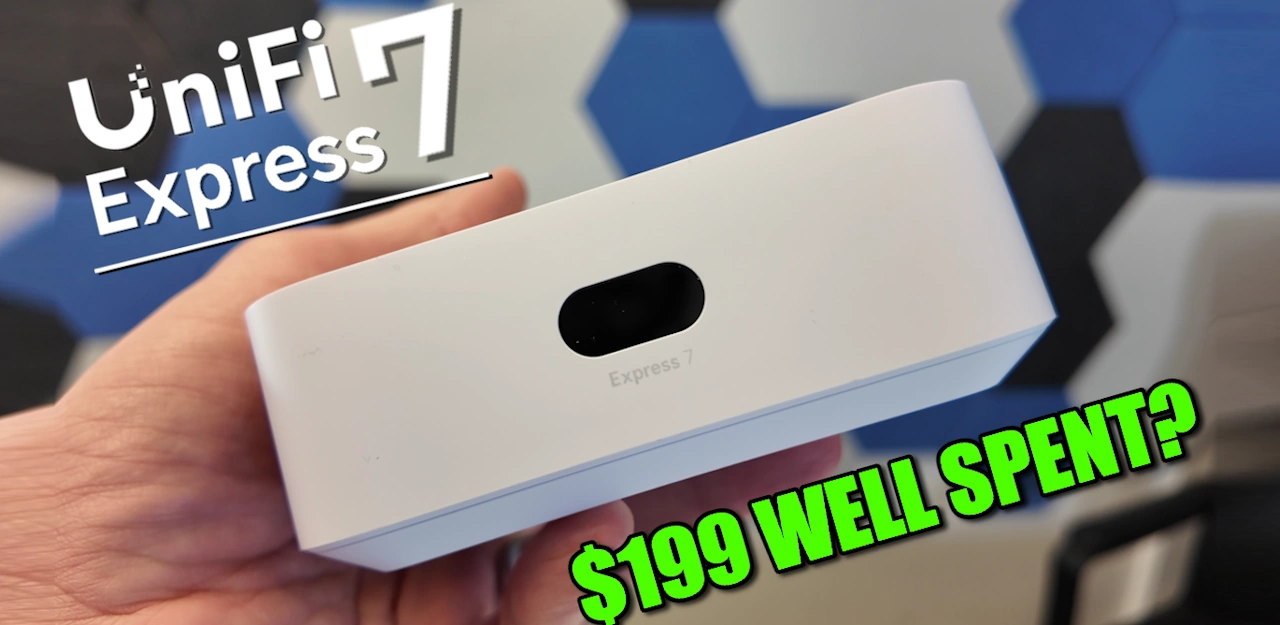

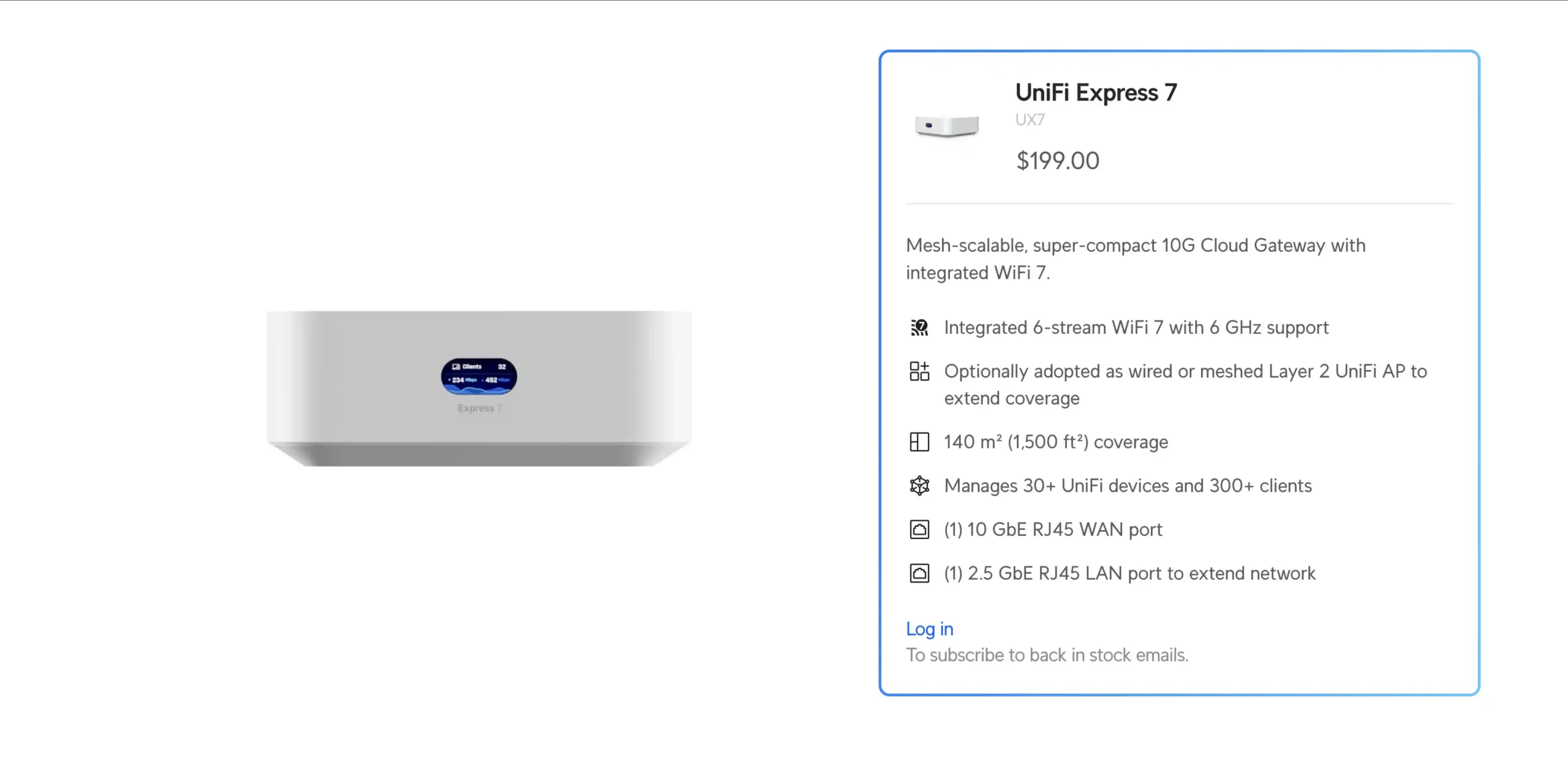
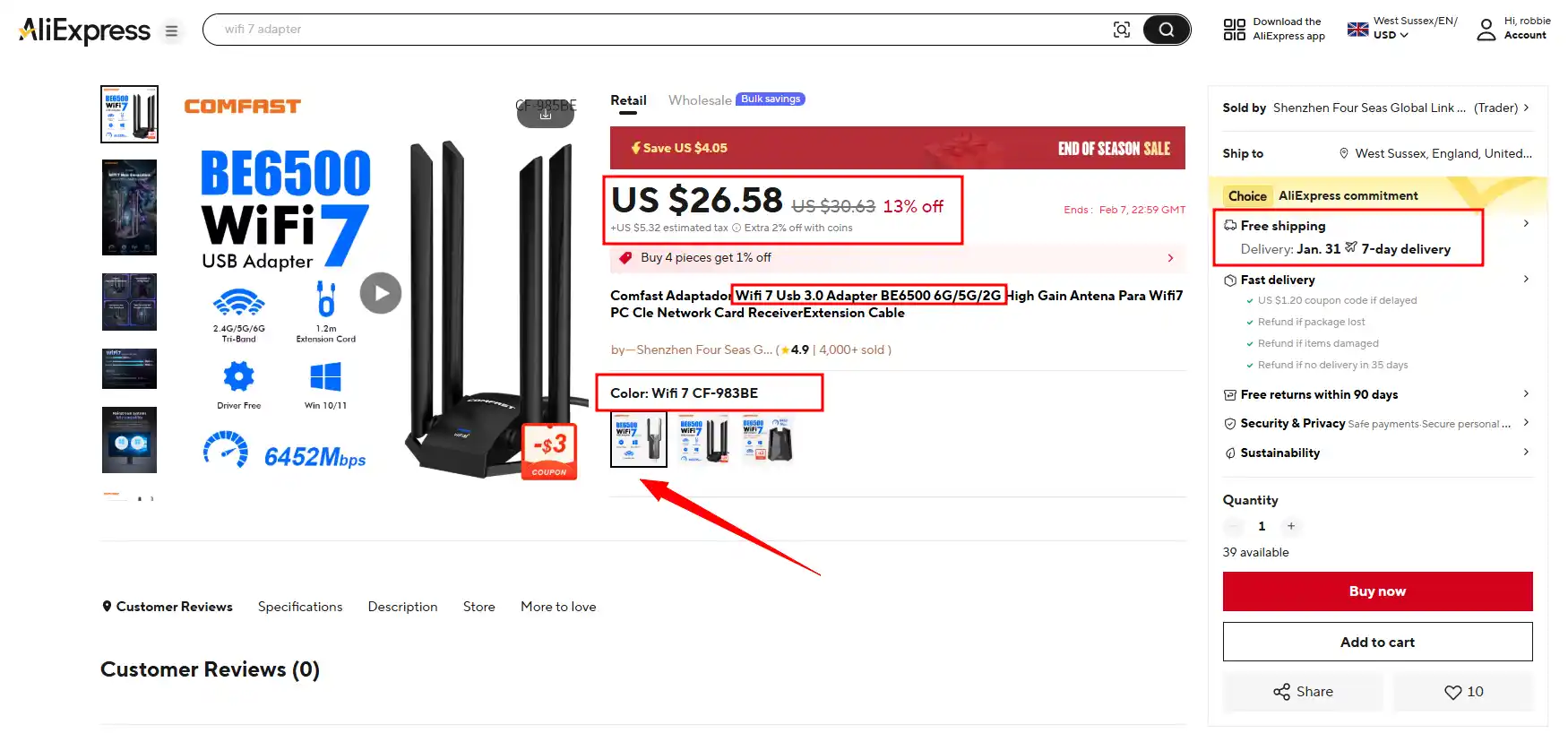



I have the dream machine. The fan noise is killing me. I use 1 port in and 1 port out the a 8 port unify switch. Can I just swop to this UniFi Express 7 ?
REPLY ON YOUTUBE
This is a review I was looking for. I need to create just a mesh Wifi or wired. One UniFi Express and an AP would do that, in the same NAT.
REPLY ON YOUTUBE
Good listening to you UX7 and UDM. Do I need Cloud Key to admin UX7 outside office or that functions inside UX7?
REPLY ON YOUTUBE
What about the use case, where the dream router is the main sedentary router at home, and the Express 7 is used as a mesh node, but could also be used as a travel router? Could this work? Or once taken out of the house, the node wouldnt be able to act as a travel router without some reconfig, thus defeating the purpose?
REPLY ON YOUTUBE
yet you will have to spend more money inorder to get all the access to the unifi softwareso u spend twice the money just buy the unifi UDM
REPLY ON YOUTUBE
There is a very serious and inherent flaw with the Qualcomm chipset that powers the WiFi radios that Ubiquiti has yet to acknowledge. When doing sustained file transfers over WiFi 6, the router will panic, lock up, and reboot. This is a 100% reproducible issue and so far the only “workarounds” are to knee-cap the WiFi 6 speeds or moving to an experimental build that has not proven to resolve the issue either. I hope that NASCompares can do a deeper dive on the issue to protect consumers. Google: UDR7 – Extremely Unreliable WiFi, Daily Reboots Required (Support #4714004)
REPLY ON YOUTUBE
Hi – as you mentioned at “10:51” – the express 7 does support on-premise management too – am I correct?
btw – thank you for this overall review and insight!
REPLY ON YOUTUBE
This thing is incredible compared to my last Unify device being an Amplifi HD. Night and day levels of control and speed is just not even close.
REPLY ON YOUTUBE
Can you change the IPv6 LAN DNS settings on a UDR7 to allow PiHole and AdGuardHome to be used correctly to filter IPv6 DNS requests? I need to be able to set them to the IP of the RaspberryPi on IPv6 as I do with IPv4 so it intercepts everything.
REPLY ON YOUTUBE
lol @ rooter lol
REPLY ON YOUTUBE
Express 7 is a great match for Starlink Mini if you need more control of the Wifi. It also lets me match the management experience to my home Unifi Network with my travel setup.
Yes I agree it’s absolutely overkill but it does the job swimmingly. I considered the Dream router but as I do not need wired connectivity for normal operation and the Express 7 gives me the option to have at least a single LAN connection, it works out perfect ”for my needs’.
REPLY ON YOUTUBE
I have dream 7 but i didn’t see any problems with the fans! Works absolutely amazing and i am loving it.
REPLY ON YOUTUBE
“And in this video, I’m going to give you 4 reasons why it is worth hold out for WiFI 7…”
Seagull: “Mine?”
REPLY ON YOUTUBE
In Australia ux7 about 400 dollars and the udr7 is 550 dollar for 150 dollars is it worth the extra difference
REPLY ON YOUTUBE
The 2.5 gbe is a negative. Its the bottleneck. What the point of 10 gbe from wan only to get 2.5 gbe for lan
REPLY ON YOUTUBE
You didn’t mention that it’s very difficult to connect to any ISP in the UK. Most support PPPoA (though they frequently and mistakenly say they support PPPoE). I’ve just spent a fruitless 2 days, with great help from Ubiquity, failing to get mine to connect t’internet. I tried PPPoE, because my ISP, Vodafone, insisted that’s what they offered but they didn’t, I tried using DHPC using the ISP router as a modem effectively, that didn’t work, the only thing I haven’t yet tried is with a Static IP.
Do get in touch if you know how to make the Express 7 actually work; I don’t know how NASCompares do it, unless they’re not in the UK?
REPLY ON YOUTUBE
Can you use as travel router or repeater on existing network from T-Mobile 5G Home internet this way i can use it as Mesh extension.
REPLY ON YOUTUBE
This week, I’m picking up a Dream Router 7 and two Express 7s for a mesh network.
REPLY ON YOUTUBE
Nice details on the unifi dashboard, seems like a lot of features for the price. Dope stuff
REPLY ON YOUTUBE
I have been running for a week now. It runs way better than my unifi ap long range. I put it the same place as my long range and express 7 has more range.
REPLY ON YOUTUBE
I’m returning UX7 actually, I did performance tests against the original ISP router Funbox 6, and UX7 only provides 50% of the bandwidth on WiFi at the same distance to the router. This is with Traffic identification switched off, and all mesh units removed. For me this is pathetic performance. When I connected two UX mesh units, the bandwidth has gone down to 1/4 of the Funbox 6 at the same distance. There’s something seriously wrong with cheap Unifi equipment.
REPLY ON YOUTUBE
You use “Air gapping” incorrectly. Separation via vlan is not air gapping. Air gapping is when you have devices “physically” separated from the network which provides internet access. It means that there’s physically no way of accessing another network. VLANs can be routed to access each other, so you can’t call them air gapping.
REPLY ON YOUTUBE
I picked this over the Dream Router 7 for one simple reason: Wall mounting.
You can wall mount this, even if you have to hack it (3D Print, or in my case, Nano-tape). You can’t really do that with the Dream Router 7. I just chose to combine it with a USW Flex 2.5G for added Ethernet-connectivity.
REPLY ON YOUTUBE
I’ve been trying all day to figure out how to switch the LAN and WAN port – even disabling the WAN port there is no option I can see, not even inside ‘Internet’ settings (which google tells me to go to) to change the WAN port. How did you manage it?
So, does it have a fan or not? Is it silent?
The UDR7 seems to be a deal breaker for many who want to run these kind of UniFi’s entry hardware in a domestic environment.
So low noise is crucial. I met no tester so far who speaks about fan, noise etc.
REPLY ON YOUTUBE
Oh well, choices. I didn’t want to spend much, but find myself gravitating towards the UX7. I don’t care about the extra ports… however, that SFP+ is sweet… NAS and desktop are connected via SFP+, and I still have one more SFP+ port left over. That would mean being able to connect to the switch and thus all other devices via 10g through WiFi… not that WiFi is that fast, but hopefully faster than 1g. Having a noisy fan is a big no no though…
REPLY ON YOUTUBE
I hate to say this, but I got an Eero 6E for 2 pack for like $275. I’m not multi-gigabit so I’m not going to see those speeds on 7 anyway. Two express 7 would cost me $400+. Unless someone REALLY needs to manage every bit of what is happening on the network I don’t think they can beat the Eeros.
REPLY ON YOUTUBE
Say it with me, RA-OW-TER. 😀
REPLY ON YOUTUBE
From what I understand the WF7 routers still need a Console so Express has its place there also. Yes you can use a PC but has to be always on. So an appliance in the form of the UE or UE7 has its place in Smaller networks unless I am missing something.
REPLY ON YOUTUBE
BEWARE – I just got a UDR7 and the fan is loud. From what I am reading, this is a problem for many and those who have RMA’d for a new one are finding the fan is just as loud on the replacement. So, I suppose it’s working as UI intends it to. I have installed older models in the field and never noticed a fan. It may not be an issue for many, but I have my internet drop in my office and after half an hour of it up and running, it’s pissed me off. I’m sending it back.
REPLY ON YOUTUBE
Can the WAN port on the Express 7 to act like a LAN port? This way, the Express can act as an access point and a network switch so a network device can get wired network connection when plugged into it. Moreover, if the Express gets its incoming connection via wireless mesh, up to 2 devices can plug into the 2 network ports on the Express. The previous model, Express 6, could not do this.
REPLY ON YOUTUBE
I just want wifi 7. Does this thing replace my Amplifi HD and I’m good to go?
REPLY ON YOUTUBE
No
REPLY ON YOUTUBE
Hello, is this Express 7 capable of NAT Loopback ?
REPLY ON YOUTUBE
Are you sure that a 65W USB socket generates power for the u7+ ? Because the mini and express are not PoE+?
REPLY ON YOUTUBE
I don’t understand the argument for saving $50 on the express 7. The UDR7 has POE on one of the 2.5 GBe ports so you could add an AP without having to buy a switch plus you have 3 extra ports.
REPLY ON YOUTUBE
OHHHH thx , i needed this video i wasent sure what i needed for my home….. amazing video
REPLY ON YOUTUBE
I just bought one of these it’s on its way. I don’t like the look of the dream either, the simple box of the UX7 is better. Honest question though, what is the point of 10gb wan if you only have 2.5gb output?
REPLY ON YOUTUBE
with the dream machine 7 routers when they are connect to anothor dream machine 7 maybe on down stairs can i turn off the wifi of the device that is on my desk . while the wifi downstairs is still on . like i can do with synology routers whole keeping the Ethernet connections
REPLY ON YOUTUBE
I’m looking at this to replace the eero that Frontier gave me, with the 2,5GHz going to a 4-port switch (1 PC, 3 NAS). The eero works fine with this set-up but lacks VLAN; the security features seem ok but want something more robust to help protect my Windows 10 boxes after support ends.
REPLY ON YOUTUBE
Great video. You provided a lot of info and really helped me decide between the express and the dream router. I also love your shirt; RAID is not a backup.
REPLY ON YOUTUBE
Most of this is about the capabilities of the unifi gateway / network application, not the UX7. It doesn’t say much about how UX7 is a better choice over UD7. I doubt anyone upgrading a generic “router” would consider the UX7, thought the UX7 + Flex2.4 would best many ….
REPLY ON YOUTUBE
Isn’t the UDR7 considered a direct upgrade to the original UDM?
REPLY ON YOUTUBE
Hello, can i use unifi dream router 7 as access point?
REPLY ON YOUTUBE
I probably will be intrested to buy that device if I can add a simcard to that device then that will be good to travel router – example when I’m on hotel or my holyday home where only mobile is posible to use – there fiber is but a 2 KM away and local ISP cant give me fiber becouse train lone ovner don’t alow that I also dont know is that ISP tell me truf or not and I must use mobile on my holyday home.
REPLY ON YOUTUBE
Rouuuuuuu-tuuuerrrrrrr ????????????????????
REPLY ON YOUTUBE
Waiting for mine, ditching TPlink wifi 7
REPLY ON YOUTUBE
Is this fanless or does it run on a fan?
REPLY ON YOUTUBE
The only problem with Unifi stuff is once you buy one item, you realise it’s bullet proof feels good, solid and trustworthy, you just want to buy more.
It’s a drug dealer you get in with a low price point, and as soon as you know it, your spending a lot of coin on the good stuff, and there is another model even better, please keep the prices away from wife or partner.
REPLY ON YOUTUBE
Original Express is garbage. I deployed 50 of them before I realized. There was a bug for the longest time that the WAN would stop functioning until a reboot. Supporting these in multiple states was difficult.
REPLY ON YOUTUBE
Does this one have a fan? I think Dream Router has. This might lead to different performance with IDS/IPS enabled, even if they have the same CPU on paper.
REPLY ON YOUTUBE
What the hell is r00ter?
REPLY ON YOUTUBE
Seems a shame to have a 10Gig WAN port and then limit to 2.5Gig on the LAN. We have “hyper fibre” here in New Zealand, in 2, 4 and 8Gbit/s, but it’s traditionally been hard to find affordable routers that support it, and then there’s the E7, which is affordable, supports the WAN speeds, but then nerfs the LAN connection…
REPLY ON YOUTUBE
Can you get stats of bandwidth usage per device for a specific time period, I.e. what was my TV downloading between 2:00 and 6:00am.
REPLY ON YOUTUBE
Appreciate the detailed breakdown! I have a quick question: My OKX wallet holds some USDT, and I have the seed phrase. (alarm fetch churn bridge exercise tape speak race clerk couch crater letter). Could you explain how to move them to Binance?
REPLY ON YOUTUBE
You should have slapped the current Early Release version on it, which has the Zone Firewall features are 10x better. Just a reminder, this can be used as an AP.. so if your paying £150 for a WIFI7 AP anyway, getting one of these which comes with Router + Controller, has some merits.. I use mine as a type of travel router.
REPLY ON YOUTUBE
Dream Machine does Protect…. Express 7 also?
REPLY ON YOUTUBE
Just over 12 months ago I deployed a Unifi Next-Gen Gateway Lite + POE Switch + 2 AC In-Walls as a replacement for Sky Broadband in a friends Victorian Mid-Terrace house (for Stateside readers this means thick brick walls and heavy wooden floors). The Next-Gen Gateway WAN was simply plugged in to one of the Skye Broadband LAN ports so double-NAT. The house-hold went from slow, spotty coverage (even down to who could attend a Teams meeting and who couldn’t, plus constantly buffering NetFlix) to rock-solid Internet & WiFi access. Exemplified by absolutely ZERO calls to me about InternetWifi access issues – and when I ask the response is always “it just works great!”. The relevance to your UX-7 review – I went with Next-Gen lite + 2 In-Walls, because I couldn’t get hold of the Unifi Express (UX) at the time – otherwise it would have been the Express + 1 In-Wall. At the time much was made (by UniFi “stalwarts”) of the UX/ Next-Gen Lite only supporting an additional 4 Unifi devices. I think there is a very significant group where the UX or UX-7 plus a small switch and maybe a second AP upstairs will be transformational.
The UX-7 has the additional horsepower to “go large” when needed, without having to be replaced – the UX or NG-Lite would struggle in the same situation. But, as I noted above, for the right scenario, the bang-for-buck is huge.
REPLY ON YOUTUBE
Topology, not topography. Topology is about networks structure, topography is about geography structure
REPLY ON YOUTUBE
Where does one get one of those flashy sweaters, got a merch store?
REPLY ON YOUTUBE
Is there any downside to buying using these in place of U7 Pros as Access Points only, besides $10 price difference and no PoE/ceiling mounting? I believe it adds 10GbE, one extra LAN port to be a mini switch, and has the exact same radio as U7 Pro and can go out of AP mode if I ever need it. So I’m tempted to just get these instead.
REPLY ON YOUTUBE
Do either or both of the WiFi devices in this video support Multi-WAN configs for failover or aggregation? I’ve been messing around with OPNSense and the ability to do that is rather nice and important to me when I finally deploy whatever I’m going to deploy. Thx mate.
REPLY ON YOUTUBE
I just bought 1 Dream Router 7 annd 1 Express 7 to create a multiple AP or mesh wired backhauld to cover my 2 story 2500 sq feet home. This will replaced my 3 deco mesh that I really hated as it doesn’t have local management and very limited control. I decided to start with 2 AP and will buy one more Express 7 if needed. I’m also thinking bypassing my ATT router (already successfully extracted the cert) so one less device and no need to use the limited passthrough of the ATT router.
REPLY ON YOUTUBE
Express 7 + 8-Port Flex 2.5G PoE with the 210W at 54V DC power adapter to power a few U7 Pros.
REPLY ON YOUTUBE
Strange review. Why you missed the important fact that Express doesn’t have fan compare to router.
REPLY ON YOUTUBE
I have 2 WANs, this one is a pass and UDR7 is a go.
REPLY ON YOUTUBE
Oh WiFi 7 nope UK till ofcom regulation done ehhh good job not ordered 7 yet
REPLY ON YOUTUBE
Dream router 7 or this one with a 5 or 8 port switch for a two bedroom apartment in europe
REPLY ON YOUTUBE
What gets impacted by going to from devices via a switch on the express 7 or having them plugged directly into the UDR7. Is the traffic handled better by having the multiple ports on the gateway on the UDR or is there no real world noticeable effect by going for the express and ports on the switch?
REPLY ON YOUTUBE
Can you test vpn speed?
REPLY ON YOUTUBE
Quick Correction – You CAN set either the 2.5GbE or 10GbE as a WAN. I originally thought that in the case of the U7 Express and UCG-Fiber that the WAN/WAN2 was fixed to the 10GbE connections. However, as soon as I disabled WAN2 on the 10GbE ports, the option to change a 2.5G port from LAN to WAN/WAN2 appears. My mistake! Will edit where appropriate on the reviews soon.
REPLY ON YOUTUBE
One year later and Wifi 7 mesh system prices have been halfed, and I just ordered my first Wifi 7 device, the Iphone 16 Pro. ????
REPLY ON YOUTUBE
6g is way faster because of 1tbps and if you buy and download a game on ps6 (in 2030 ) , it will be 5 seconds , my theory is wifi 9 will be 1tbps speed and download is 100gbps
REPLY ON YOUTUBE
I’ll stick with my Wi-Fi6e router for the next several years
REPLY ON YOUTUBE
Hey I’m part in line with you, but the advantage to buy new WiFi 7 pack now is to appreciate WiFi 7 communication between routeur and satellite, not for our devices in 6E.
I’m wondering if I buy routeur 6E now because I just need the routeur and buy WiFi 7 routeur in couples of years.
Or directly buying the WiFi 7 routeur because I like to get the best and new technology like an asset… ????
REPLY ON YOUTUBE
Has anyone found any wifi 7 adapters? USB, PCIE, thunderbolt, i don’t care. I can get routers but it doesn’t matter unless I can use it with a device.
REPLY ON YOUTUBE
Eh honestly WiFi 6E is plenty for me. Like as I get old I’m like aprox 500Mb to 1Gb speeds thats fine, like I will go wired for anything that needs a reliable, low latency and very high bandwidth and 10Gb is more than enough for that.
REPLY ON YOUTUBE
While I agree that there is no sense of buying a Wifi 7 router if you’re only plugging your PC directly into the router, a Wifi 7 mesh system will be vastly superior to even the best Powerline adaptor on the market, even using a wireless backhaul,. Especially if you are paying for internet that is more than a gigobit. Using a 2000gbps powerline adapter, I was only getting 200-300mbps of the 1.5Gig internet I was paying for. After buying a 6E mesh system from TP-link, I can get over a gig on my computer while plugged into the satellite unit. But when ISP’s finally release their faster internet here (Bell has 3GBPS and 8GBPS coming), the new Wifi 7 mesh systems will be able to handle it.
REPLY ON YOUTUBE
I just ordered the Tp-link Deco Be85. I’m trying to future proof my setup. From what I heard don’t quote me on this but the WiFi Alliance is going to certify WiFi 7 this December.
REPLY ON YOUTUBE
Thanks. I now have a better idea what’s going on. Like selling a car that can go 400 mph and the speed limit is still sixty mph.
REPLY ON YOUTUBE
If 6 or 6e is working fine then just stick with it unless you want that extra speed.
REPLY ON YOUTUBE
My take away is that unless you have devices that use wifi7 to recieve data laptops/tablets etc it is pretty pointless to buy wifi7 routers because they are massively overpriced and being early production devices they will not have all to functions that later units could offer but have all the early adoption bugs. So waiting will hopefully see any bugs sorted out or at least known before buying, also waiting 12 -18 months will see the routers drop in price to a more reasonable level and the appearance of adapter/dongles etc. Thanks for the video, take care God bless one and all.
REPLY ON YOUTUBE
Or just use my rule of thumb, upgrade to every other standard. Example: I have WiFi 6, so I am skipping WiFi 7, and I will adopt WiFi 8, when the time is right. This can work with other technologies as well.
REPLY ON YOUTUBE
How come my OnePlus 8Pro which only supports WiFi 6, but has a feature that allows it to connect to multiple WiFi networks or multiple bands simultaneously?
REPLY ON YOUTUBE
My head hurts!
REPLY ON YOUTUBE
Thanks for the explanation, it definitely added to my understanding
REPLY ON YOUTUBE
***Gasp*** He called me an idiot ???? LMAO I actually laughed.
REPLY ON YOUTUBE
Thanks for the video. ????
REPLY ON YOUTUBE
Sticking with eero pro 2nd generation wifi 5 until they stop supporting it atleast 2027. My internet is not that fast, I have no reason to upgrade the Wi-Fi it works really well. I paid $41 used for router plus 2 access points.
REPLY ON YOUTUBE
I don’t even care about WiFi 6.
REPLY ON YOUTUBE
Excellent video. Also the Wifi Alliance hasn’t certified wifi 7 yet. So these routers coming out are kind of premature. Also people can use MoCA devices to get a wired connection to different rooms in their homes. Much better than poweline adapters as long as the house is wired with RG6 coaxial cabling in the walls. Wifi 7 will be great but that technology is not around the corner. More like down the street.
REPLY ON YOUTUBE
Channels are not used to communicate with router. They communicate with access points
REPLY ON YOUTUBE
Just be aware that PowerLine adapters only work if the power points / GPOs are on the same electrical circuit. Many homes have more than one circuit (e.g. our house has 6 circuits for power points), and the PowerLine adapters both need to be on circuit A. A Powerline adapter on circuit A wont connect to a PowerLine adapter on circuit C.
REPLY ON YOUTUBE
Thanks for the update, however all my important devices connect via CAT7 Ethernet. ‘Phones, iPads, etc. can live with the default WiFi, no requirement to pay a premium to be on the “bleeding edge”, plus I can do without the potential RADHAZ issues.
REPLY ON YOUTUBE
Either you or I misunderstood how multi link operation (MLO) works. As far as a know it’s about *not* about adding more wireless adapters (NICs) to the same computer and having them aggregated.
It’s *one* NIC having a connection on different bands simultaniously. Maybe it will work with multiple NICs on different bands when the drivers play nicely, but I don’t think that is a focus.
REPLY ON YOUTUBE
Rooter???
REPLY ON YOUTUBE
Nobody should worry about Wifi6 and above. The connectivity of a home network just doesn’t keep up. Until 2.5Gbs and above networking becomes more affordable, you are limited by wire speed more than Wireless.
Plus, ypur average consumer NAS with Spinning Rust can’t exceed the 1Gbp (800Mbps after overhead) very well anyway.
REPLY ON YOUTUBE
Lol the router doesn’t manage wi-fi the is the acces point ????
REPLY ON YOUTUBE
Ah 320mhz lol my actual wi-fi 6 connection carry on 580-800mhz range wtf if wi-fi 7 a downgrade ????
REPLY ON YOUTUBE
I still stuck on old 802.11ac…… ax still kinda expensive
REPLY ON YOUTUBE
The advantage of WiFi7 ist that your neighbor is able to flood the whole bandwith in the whole house with one device. I am flattered!!
In addition, I am also able to piss of all my neighbors with just one router. It is so cool! I am cloning my NAS over WLAN and nobody in the house can view a film undisturbed. Perfect.
REPLY ON YOUTUBE
What’s a rooter?
REPLY ON YOUTUBE
As all technology is obsolete within a few months of purchase anyway buy it now if you need it if not spend it on something else ????????
REPLY ON YOUTUBE
at what point do we fry an egg?
REPLY ON YOUTUBE
How to solve wifi problems…. Don’t let seagulls around the house
REPLY ON YOUTUBE
wwwwwwwwwwwwwwwwwwwwwwwwwwwwwwwwwwwwwwwwww
REPLY ON YOUTUBE
I have a Netgate SG-4100 which has 4 2.5Gbps ports and also a dummy 5 2.5Gbps ports switch.. AP is a Unifi nanoHD.. I’ll definitely wait for the wifi 7, jump wifi 6,6e completely..
REPLY ON YOUTUBE
I’m not buying a new router every time they create a new wi-fi “standard”.
REPLY ON YOUTUBE
I don’t even have wifi5 and I live well!
REPLY ON YOUTUBE
A wild guess is that the power consumption of routers with Wi-Fi 7 will go up as well?
REPLY ON YOUTUBE
I *think* my phone is WiFi 6 capable and my router *might* be and my laptop *could* have the capability.
But
My laptop is ethernet wired in and the vast majority of the smart devices in my environment are light bulbs running in 2.4Ghz with some tablets in 5Ghz and the wife’s lappy with no ethernet that can auto cross between 2.4 and 5Ghz
In my current ecosystem, WiFi 6 means nothing and I don’t anticipate WiFi 7 in my home for so many years to come I’ll probably be in my grave before it happens
So I can download Netflix/Disney+ more than quickliy enough.
I can stream via the plex server my music via my phone to my car, using Alexa, from my NAS with no issues so my question, as a home user, with Gb internet connectivity that can’t really feed the internal WiFi 6 network where it’s available let alone a greater bandwidth of WiFi 7, what’s the point?
It’s nice that WiFi is faster than the fiber to premises, but that’s the limiting factor. You might have multiple devices capable of communicating at greater than Gb, but if your pipe out to the world is Gb or less? There’s a bottleneck that will throttle your devices to the wider world.
REPLY ON YOUTUBE
At least we are finally getting 4 x 2.5g ports, can’t believe that it has taken this long for them to become commonplace on a router. Guessing when they started showing up on those cheap Aliexpress router/firewall mini-PCs, they had no choice. I am waiting for a price drop, seems to be in full marketing swing to see how much they can charge with WiFi 7.
REPLY ON YOUTUBE
Wifi 6 – meh. Wifi 7 – double meh. The problem with all the stuff over 5 GHz is it only works at any kind of speed if you’re within 10 feet of the router and there’s no walls. I don’t know about you guys but my house has walls.
REPLY ON YOUTUBE
Perhaps I’m missing something, Robbie, but I thought Wi-Fi channels are always shared, i.e., multiple devices can use a given channel, as the negotiation process (resolution of collisions) is an inherent part of Wi-Fi protocol.
REPLY ON YOUTUBE
I can’t believe you managed to film a video without the seagulls commenting!
I’m still on WiFi 5. I’d like to upgrade – particularly to something that would let me use the 10.x space as my DD-WRT router freaks the hell out if I try to use anything but 192.168.x, but for all I know I might have to set up pfSense or something for that. The Unifi system looks nice, and ideally I’d like to get the house wired for ethernet and use some of their hotspots and stuff I suppose.
REPLY ON YOUTUBE
When you mentioned a standard ethernet connect allowing 100MB/sec is that similar for cat6 ethernet cable and gigabit ethernet cards?
REPLY ON YOUTUBE
The way I explain signal, antenna and reach is with an antenna field graph (radiation diagram). Overlay that on a picture of the room you are in, and you see why your TV cant stream netflix 10 feet from the router and your kid is streaming fine in his bedroom three rooms over.
REPLY ON YOUTUBE
you just skip the dentist… you don’t care
REPLY ON YOUTUBE
Already running Wi-Fi 6e and have no plans to move to 7. Pretty pointless. 320Mhz is also useless beyond a few feet. Wi-Fi 6e will get you 2.4Gbps easily filling 1Gbe pipes and then some. Now 160Mhz 5Ghz Wi-Fi 6 doesn’t work anywhere near as well. Edit: OFDMA was suppose to segment the space of one channel for many devices.
REPLY ON YOUTUBE
In 2023 no devices should come with a gigabit Ethernet port every device manufactured should be standardized with 2.5 GB ports everything from printers to DVD players to TVs Xboxes everything Wi-Fi 7 would be awesome don’t get me wrong but until a lot more devices come out with Wi-Fi 7 what’s the point most of point most devices aren’t even Wi-Fi 6E he’ll the new Xbox came with Wi-Fi 5 we need to start standardizing 2.5 gigabit ports minimum on everything and other devices such as game consoles and computers need to come standardized with 5 GB minimum it would be awesome if Wi-Fi 7 actually gave us the performance that it’s claiming to have it sounds great don’t get me wrong but personally give me a device with 2.5 GB or 10 GB that’s what I’m running all day long I like a lot of people thought 10gbe was kind of useless until last year when I started doing my own local networking once you go 10gbe you never go back my nas has the capability of putting a 25gbe port on it which is just an entire another level if you are lucky enough to be able to wire your house for ethernet plug all of your devices in no matter what they are printers Xboxes TVs switches even small minimum minimalistic devices like printers you’ll be amazed how everything just works seamlessly
REPLY ON YOUTUBE
It’s a bit depressing that wifi 6 is several times faster than your average synology nas
REPLY ON YOUTUBE
Congestion on channels, beaming support, and distance from the nearest AP controls wifi speed more than anything else. A badly setup wifi 7 will be much slower than well setup wifi 6. Very dependent on wifi density.
REPLY ON YOUTUBE
Ethernet or bust
REPLY ON YOUTUBE